The best time to go to Norway in 2024
Mar 18, 2024 • 5 min read

The best time to visit Norway will depend on what you want to do when you get there © Everste / Getty Images
Norway is known for its spectacular landscapes and, as one of the most beautiful countries on the planet, there's no such thing as a bad time to visit.
However, certain seasons will impact the many big attractions and experiences on offer – prioritizing what you want to do and understanding these seasonal differences will be key to planning your trip.
Summer is the most popular time to visit: it has the best weather, long hours of daylight, prices are generally cheaper and everything’s open. Winter is a magical and popular time to visit if you’re on a quest to see the northern lights. And for those looking to follow their own path along quiet roads to find a Norway stripped of all tourist hype, spring and autumn may be for you.
Here's everything you need to know about picking the best time to visit for your trip to Norway .
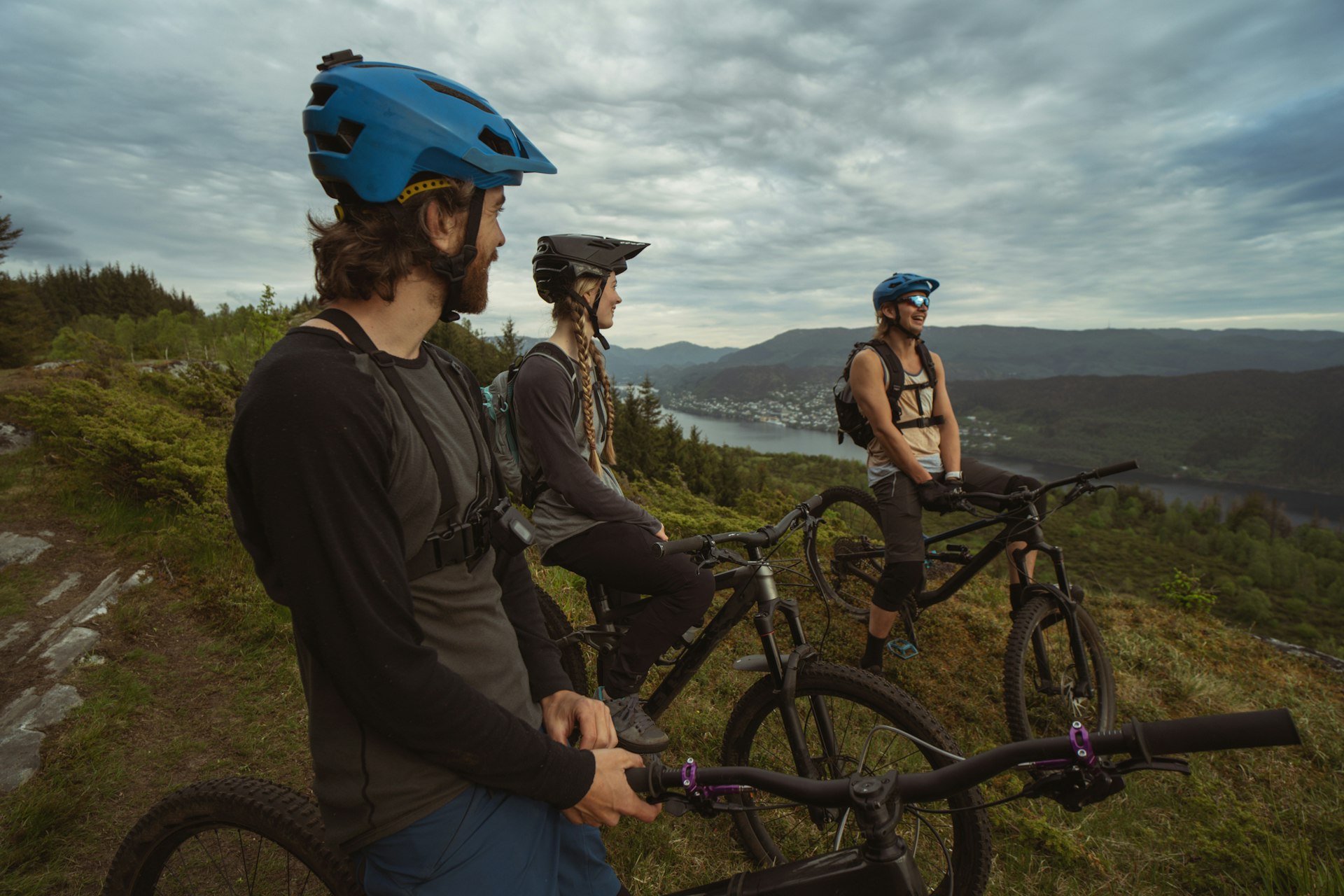

June to August is the best time for good weather and cheaper prices
There is no better time to visit Norway than in summer. Let’s start with the weather. This being a Scandinavian country with much of its territory within the Arctic Circle, we can’t guarantee sunshine every single day, but from June to August, clear, mild days with a piercing blue sky are the norm. This is the best time to see the fjords, the Lofoten Islands or Svalbard at their most pristine and glorious.
Summer days here seem to last forever: north of the Arctic Circle, there is at least one day every year when the sun never sets. The further north you go, the more of these days you get. Even in Norway’s south, there’s no such thing as complete darkness throughout summer as the sun’s light from just below the horizon bathes the night hours in a sepulchral glow.
Summer is, of course, high season in Norway. This can mean that everything – from all roads and campgrounds to tourist attractions like boat cruises on the fjords – gets busy. This is also when most of the festivals happen, and when the majority of locals take to the roads. But traveling at this time comes with an unexpected bonus: unlike high seasons just about everywhere else, high season in Norway means cheaper accommodation prices. While this may sound counterintuitive, the reason is simple: Norway is one of the most expensive countries on earth, and the only people traveling at other times are business travelers on expense accounts. In other words, prices drop so that tourists can afford to travel.
There is one further advantage to traveling in Norway in the summer. For much of the year, Norway’s wild landscapes are susceptible to the kind of unpredictable weather you just don’t want to get caught up in. With that in mind, the hiking season only runs for the three summer months every year. It’s also the best (and, in some cases, the only) time for cycling, white-water rafting and whale-watching off the coast of Vesterålen .
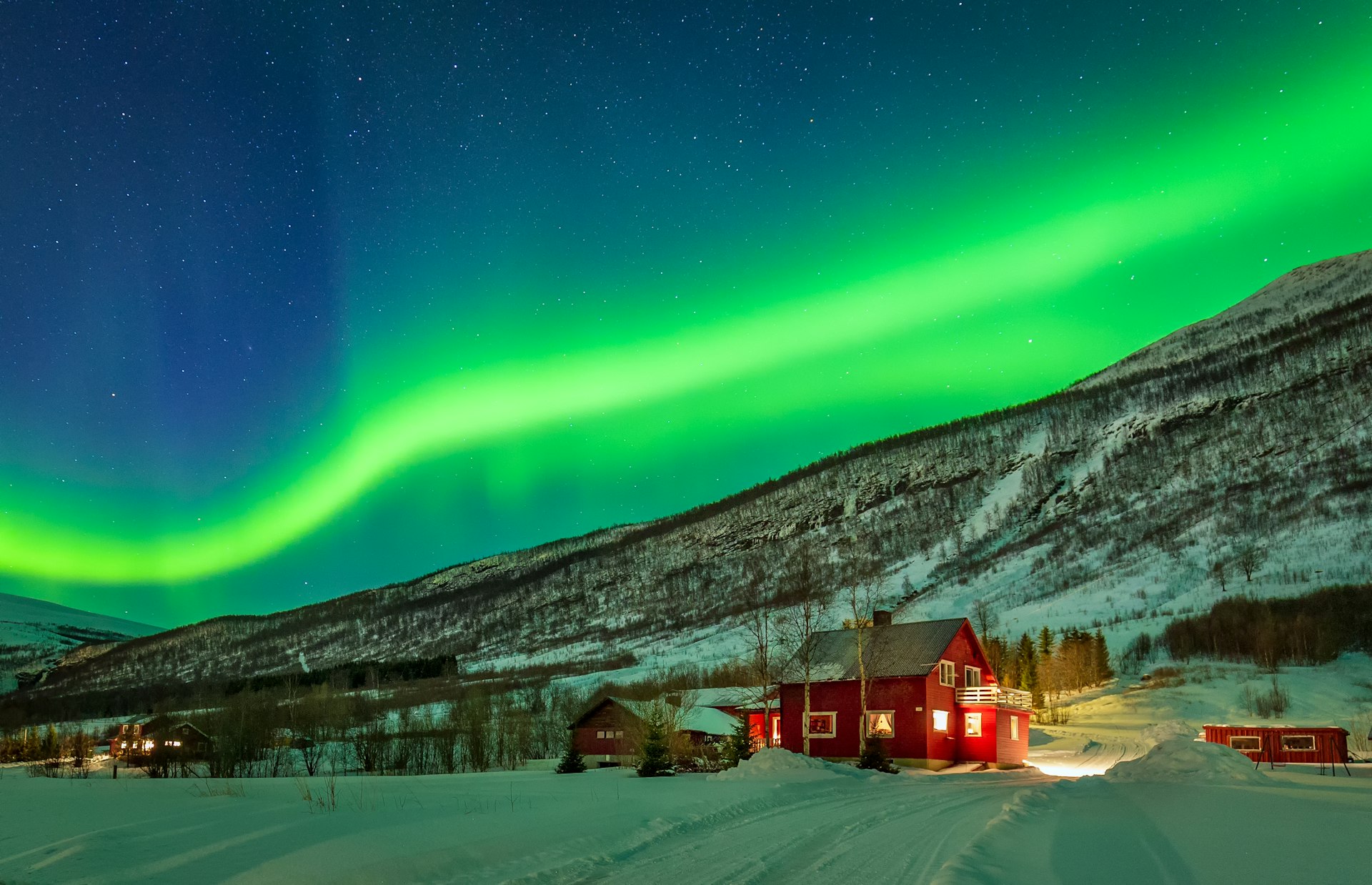
December to February is the best time for the northern lights
Summer may open up a whole world of possibilities but the Norwegian winter has a special (and increasingly popular) call all its own. This is the time of year when the northern lights dance across the sky in great curtains and cascades of shape-shifting colored light. Truly one of the natural world’s greatest spectacles, the aurora borealis happens year-round, but Norway’s long winter nights provide the perfect conditions in which to see them.
Yes, you need clear skies, which is never something that can be guaranteed in the depths of a Norwegian winter. And you never quite know when or where they’re going to appear. But when they do, it’s the kind of experience that lingers in your memory with all of the magic of a fairy tale coming to life.
Winter is also when the polar night descends upon the country, casting it into darkness for months at a time; the sun doesn’t even appear above the horizon from late October to mid-February in Svalbard’s Longyearbyen . But seeing the country at this perspective-altering time can be almost as memorable as seeing the northern lights. If you’re lucky, you’ll experience both.
When the sun is shining in winter, as it does surprisingly often wherever daylight occurs, the snows that cover much of the country transform Norway into a land of singular and spectacular beauty. Even in the iciest conditions, most of Norway’s roads remain open throughout winter, and elsewhere Norwegians take to the paths – whether to the local shops or out into the wilderness – on cross-country skis. If you’re not inclined to join them, there’s always dog-sledding, ice hotels and snowmobiling for those looking to immerse themselves in Norway’s frozen winter world.

March to May and September to November are the best times for quiet roads
With so much going on in summer and winter, Norway falls relatively quiet during the spring and fall months. And therein lies the appeal of visiting at this time. Beyond city limits, Norway’s roads are quieter by a near-exponential magnitude. It’s also easier to come by your favorite hotel booking, while weekend accommodation prices can be the same as those seen otherwise only in summer.
If you time your visit right and visit in late spring (May, for example) or early autumn (September), you might also enjoy some of the benefits of summer – cheaper hotels, hiking trails still open – but without the crowds to share them with.
And yet, perhaps the greatest benefit of traveling at this time is something less tangible. In many ways, this is an ideal time to observe Norway, to look through a window into the world of local life as it goes quietly about its business. It can be a far (and deeply satisfying) cry from the world of busy tourist attractions and carefree summer months.
This article was first published April 2021 and updated March 2024
Explore related stories
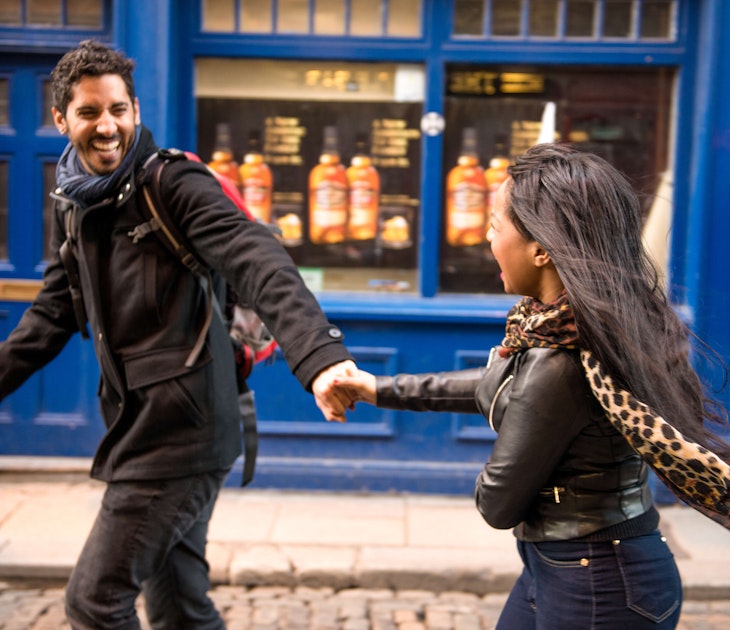
Destination Practicalities
Mar 30, 2024 • 4 min read
Who wouldn't jump at the chance to visit the Emerald Isle? Here’s how to check if you need a visa before setting off on your Irish adventure.
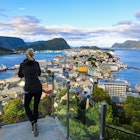
Mar 20, 2024 • 8 min read
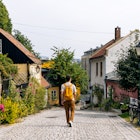
Mar 18, 2024 • 6 min read
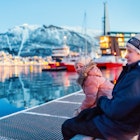
Mar 14, 2024 • 8 min read

Jan 19, 2024 • 11 min read

Dec 27, 2023 • 8 min read

Dec 1, 2023 • 6 min read
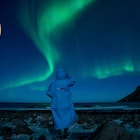
Oct 27, 2023 • 5 min read
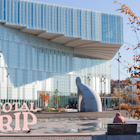
Oct 24, 2023 • 9 min read

Aug 3, 2023 • 7 min read

When To Visit Norway: A Month by Month Guide
Are you wondering about the best time of year to visit Norway? It depends on what you want to see and do. Read our full guide to help you decide.
It might surprise you to hear it, but Norway is a year-round travel destination. While perhaps best known for exploring the fjords in the summer, people flock to the country at different times of year for hiking, skiing and aurora spotting.
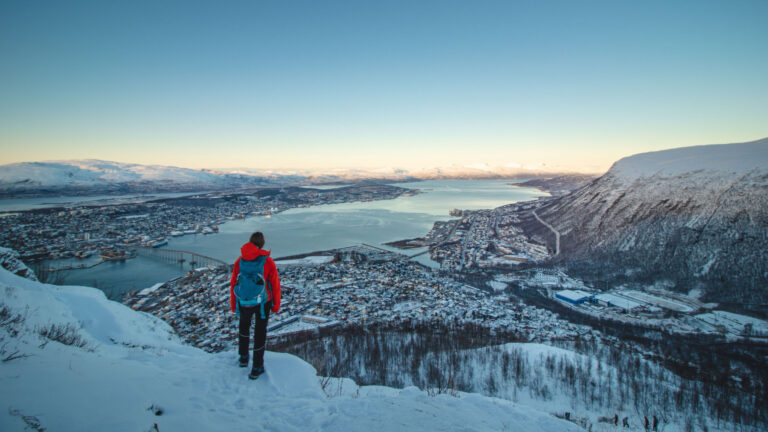
The best time of year for your visit depends very much on what activities you have planned and what your expectations are.
There are very defined seasoned for skiing, hiking, fishing and even chasing the northern lights, but you have more flexibility if your wants are less specific.
Here's our run-down of when's best to visit Norway. We start with some general seasonal advice and then move on to a month-by-month breakdown. Grab a notepad as we take a look at the best time of year to visit Norway.
The best season to visit Norway? It depends
We'll start off with the seasons, because they may be different from what you expect. This is especially true in the winter, when we really have two different winter seasons .
Mid-June to mid-August is considered high season, with July very popular for domestic tourism. During this time you'll find it hard to secure accommodation on short notice. That's especially true for cabins and cottages in popular rural or island locations.
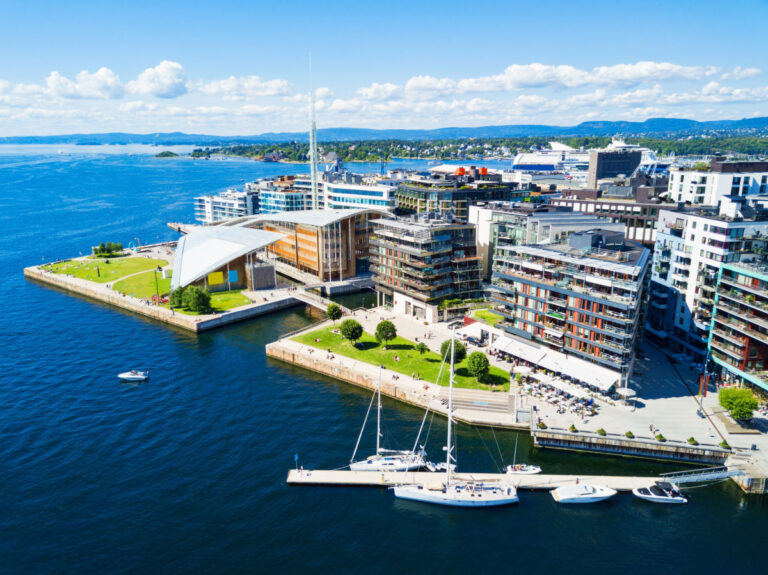
Because of the popularity of summer, the shoulder seasons are being considered by more people. They are late May to mid-June and mid-August to early September.
These periods still offer the chance of better weather but with fewer people. The first shoulder period also offers the advantage of long days.
In the winter, October-November and February-March are the prime months for northern lights chasing. While December and January are the darkest months, there also tends to be more rainfall and therefore more clouds.
Expected rainfall depends very much on where you go. Coastal areas can suffer from significant rainfall at any time of year. Nationwide, May tends to be the driest month, while September to November is generally the wettest time.
The snowy season
For snow: Snowfall is never certain, but is much more likely between January and March. In the main cities, snow could fall as early as September, although most cities see their first snowfall in November or even as late as December.
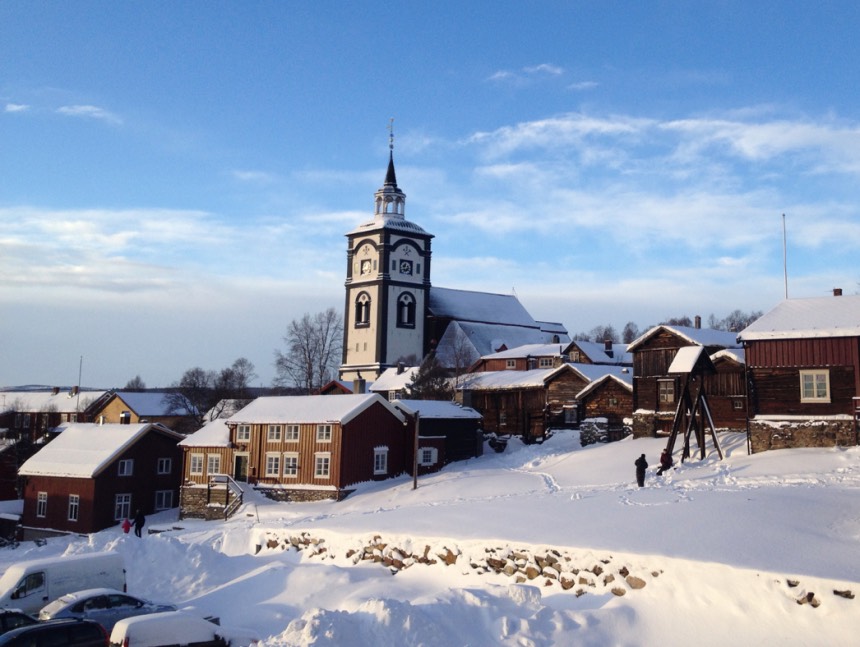
Away from the coastline and at higher altitudes, snowfall can occur anytime from September through to May, but again January to March is the time when you can expect the most.
While most ski resorts open as soon as the first snow falls, February and March are the most popular months simply because of the lighter days, especially for cross-country skiers.
Ski resorts are open through to Easter time, depending on conditions. Easter weekend is usually considered the season ending weekend by most of the big resorts.
The great light show in the sky
For northern lights: Even though the northern lights occur year-round, the human eye requires darkness to see them . This is why it is impossible to see the lights during Norway's summers, as the sun doesn't set in large parts of the country.
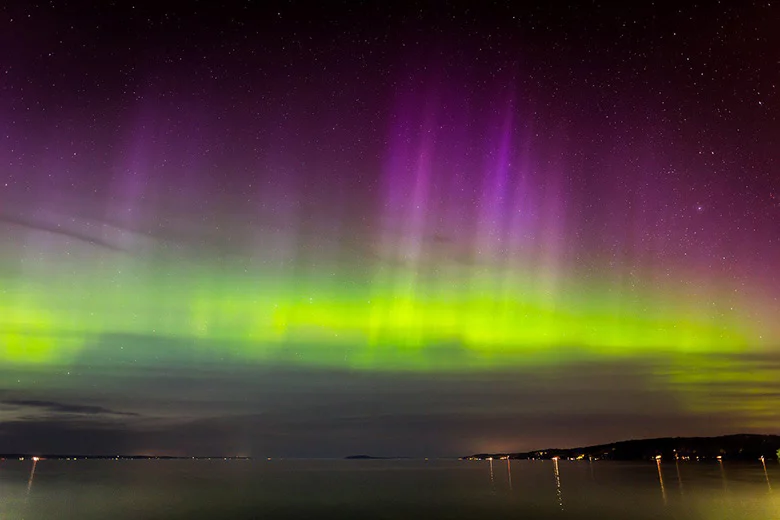
Even though November-January is the darkest time of year, there is also an increased chance of cloudy skies. This is why September-October and February-March are generally considered the optimum time for aurora chasing.
My preference would be for February-March, as the weather is generally clearer then, and there is almost certainty of snow on the ground.
Not only does this brighten up the daytime, it also opens up a whole bunch of other activities for the days while you wait for the light show by night! If you've ever wanted to try snowshoeing, skiing or dogsledding, this is the perfect time.
The iconic fjords
For the fjords: The fjords are very much a seasonal destination and therefore many hotels, campsites, attractions and even roads are closed during the winter months. However, a winter visit to the fjords can be truly special, if you're prepared to plan and be flexible.
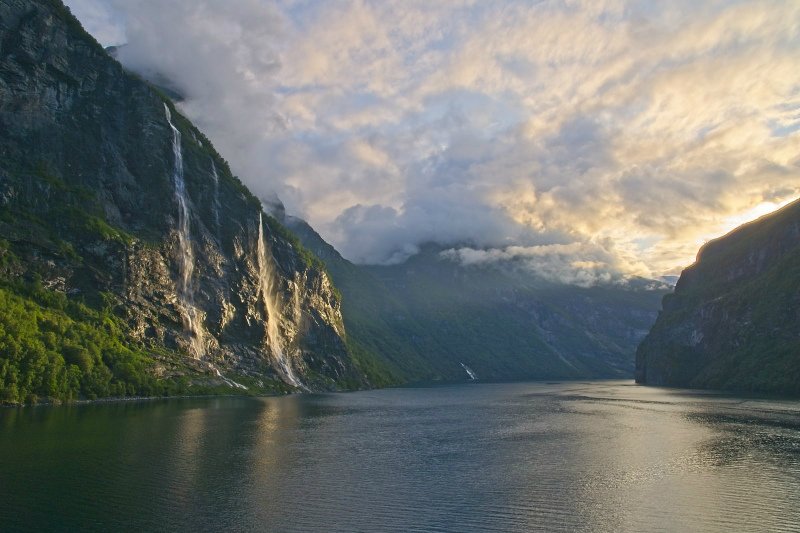
May to August is the best time to plan a visit to the Norwegian fjords, although July can be busy with domestic travellers so advance bookings are required then for all accommodation.
The country's best waterfalls tend to be at their strongest in the late spring to early summer (May-June) when snow melt generally results in a more powerful stream of water.
For road trips: Most people choosing to rent a car do so to get up close and personal with the fjords, so our advice for road trips is similar as to that for the fjords. Late spring through to early autumn are the best time for a road trip in Norway.
Be wary that many mountain roads, including some of the heavily promoted National Tourist Routes, are closed during the winter months and may not reopen until as late as May depending on weather conditions. More information from the Norwegian Public Roads Administration .
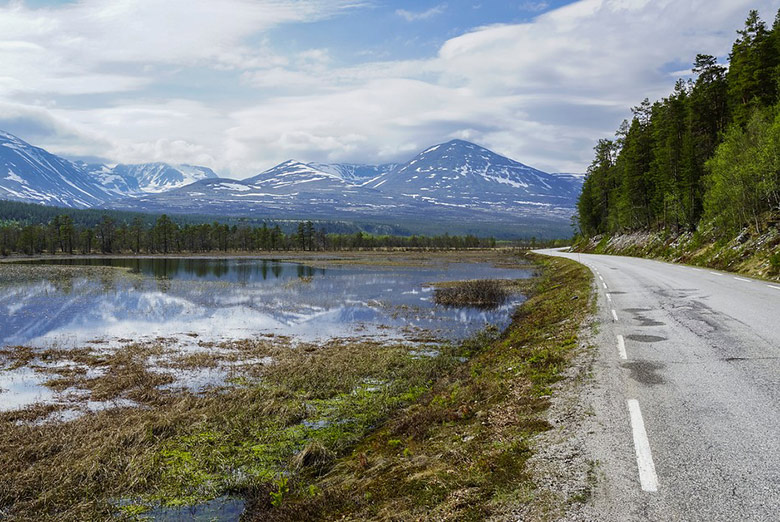
Norway by rail
For rail travel: Norway's railways are world-famous for their spectacular views. The Bergen line and the Flåm railway are particular highlights.
While outstanding in summer, the railways of Norway are a great choice of transportation all year round. The Bergen line offers a trip across one of Norway's highest mountain plateaus, and the contrast between the scenery in summer and winter is truly remarkable.
Bear in mind if taking the night train during the summer, an eye mask and ear plugs are a wise investment! You usually get a thin mask and thin blanket included in your fare on the train, but it's a good idea to pack your own as they are not the best quality.
Fares tend to be cheaper outside of the summer months but bear in mind that the closer to December you are travelling, the more chance you will miss some of the spectacular scenery.
When to visit: month-by month
Now, let's dive into more detail by looking at advice on a monthly basis.
January : Days are very short, especially in the north. The quiest month for tourism. Ski season is underway and northern lights tours run, but the weather can often be poor. It can be very cold but snow often brightens up the darkness. For true winter lovers, this is your time!
February : The light begins to return and snowfall is at its height. Ski resorts start to get busy, while (usually) clearer skies increase the chances of a northern lights sighting. Photographers will enjoy the contrast of lighter days with snow-covered landscapes.
March : Snow remains on the ground while we experience broadly equal days and nights. Very popular month for winter tourism, including northern lights, dog sledding, skiing etc.
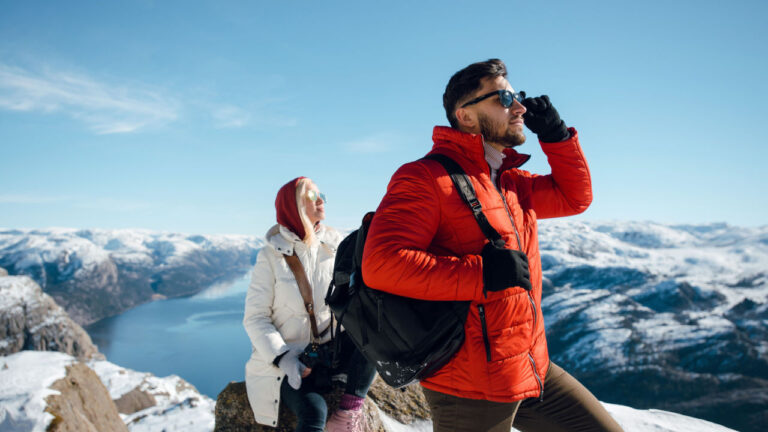
April : Winter weather remains in the mountains but there is more of a spring feeling elsewhere, although landscapes will still be rocky rather than green. Days are getting longer. A good time to explore the cities.
May : Prime waterfall season as snowmelt tumbles into the lakes and fjords. Long days can often be coupled with good weather. Several public holidays during the month, so there is a notable increase in events.
June : The longest days of the year and the midnight sun in the north. Mountain roads are open and hiking trails begin to get busy. More international tourists, but the first weeks of June are still relatively quiet compared to later in the summer.
July : While the weather can be fantastic and days are still long, July is by far the busiest month on Norway's roads and at tourist destinations such as Lofoten and the fjords. Book everything in advance. Be prepared to queue for ferries.
August : Proper nights return as summer draws to a close, but weather can still be good. Fewer tourists as the month progresses, so the fjords and cities like Bergen are good choices especially towards the end of the month.
September : Risk of rainfall increases and autumn colours begin to appear. It can be a stunning month for landscapes and for travel bargains if the weather behaves. Good accommodation availability and rates. However, availability of tours is more limited and any high season attractions will be closed.
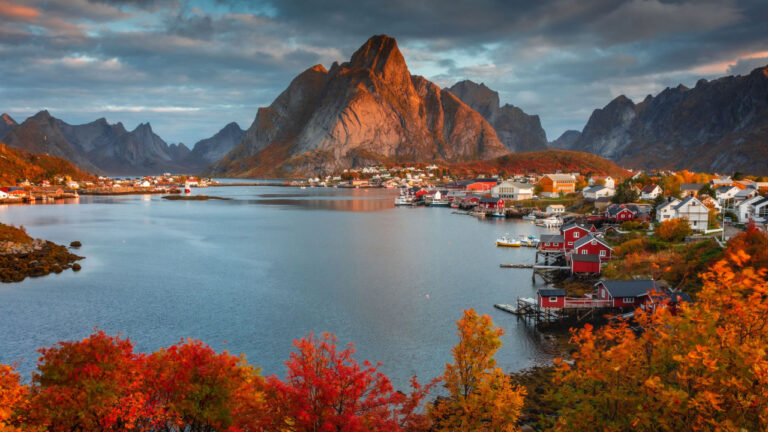
October : Autumn colours by day and good chance of northern lights by night, as long as the weather is on your side. Expect rain. Very few international tourists. A good time to visit the cities.
November : Winter arrives but there's usually very little snow outside the mountains. What snow does fall doesn't tend to settle. Popular for northern lights tourism as the nights are getting longer, but you should expect rain.
December : The darkest month of the year and more chance of snowfall in cities. Christmas markets make December a unique month to visit Norway's cities.
I hope this helps you with your travel planning. When to visit Norway is a difficult question. There is no perfect time.
It's also important to remember that everything in this story should be considered guidance only. It's perfectly possible to get incredibly sunny (albeit cold!) days in February, and cool days with pouring rain at the height of summer. Be prepared for anything!
About David Nikel
Originally from the UK, David now lives in Trondheim and was the original founder of Life in Norway back in 2011. He now works as a professional writer on all things Scandinavia.
You might also like...
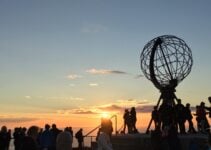
North Cape: A Complete Guide to Visiting Nordkapp
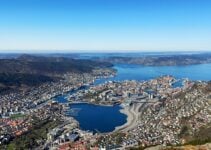
Guided City Tours of Bergen, Norway

SAS Scandinavian Airlines Confirms Star Alliance Exit

6 thoughts on “When To Visit Norway: A Month by Month Guide”
Excellent briefing for travel round the year. Coming to specifics, I would like to know the scenic beauties of rail/Bus travel in the sector Alesund-Andalsnes-Dombas-Oslo.
hi David, I am going to visit Norway from 11 April to 10 May. I know this period of time is not mentioned in your blog as the prime time. I still wants to try to catch some Northern light. Do I have to travel to Alta? I was thinking of spending one night in Oslo then off to the north. I don’t know what is the best way to go north? What train goes from Oslo to Alta? Regards, Jancy
It’s very late in the year to see the northern lights, too late I would think, because there just won’t be enough darkness. .You can check the sunrise/sunset times online. Also, there is no train to Alta. Unless you hire a car (not recommended, the drive is LONG) you would need to fly there.
Hi David, my son and I are visiting Norway in November 2018 (not the best time according to your blog!). We are doing a Hurtigruten cruise from Bergen to Kirkenes finishing on 23 November. We then only have 4 days remaining and my question is whether we should spend that time in Kirkenes or Tromso? We would also like to some dog sledding although I don’t think this is possible in Kirkenes but may be possible in Tromso. I have found a mini break in Tromso which takes us out into the Lyngen Alps to stay in a glass igloo and then dog sledding the next day. We would love to see the Northern Lights but obviously no guarantee there. Anyway would like your opinion on which place would offer the best experience. Thanks and regards, Fiona
Hi David, Planning visit to Norway with family 2 adults and 3 kids (age below 12) during last week of March 2019. Will it be green around Bergen and Oslo. Also is it possible for road trip by car to fjords around that time. And if I have to catch aurora lights where I have to go. Thanks.
Hi David. I am planning a trip with my wife from 27-Oct to 4-Nov’19. Is it a good time to travel? Are a lot of scenic places accessible at that time? Also, are road trips feasible then?
Leave a Comment Cancel reply
- Privacy & disclosure policy
- Portfolio & Press
- NORWAY ITINERARIES
The Best Time To Visit Norway (A Local’s Month-by-Month Breakdown)
Psst! Some links in my posts may be affiliate links, which means that I get paid a fee if you chose to purchase something through it. This doesn't cost you anything, but makes a huge difference for me! Thanks for your support!
I’m often asked by my readers about the best time to visit Norway , which is always a hard question to answer; because I consider Norway to be a year-round destination (and so do most locals you ask). However, it is possible to figure out the best time to go to Norway, depending on what you are after!
Norway is like a dream destination for everyone. Call me biased, but I’m pretty sure anyone who visits Norway is going to fall in love with it, no matter what time of year. To visitors, Norway means majestic fjords, historic towns, beautiful country-sides, steep glaciers and jagged peaks. To me, it’s all of that, and home.
Each season in Norway has its unique attributes, and so what the best month to visit Norway is changes accordingly. However, I have tried my best to break it down for you in this post, to help you decide when to travel to Norway.
There’s a different ‘best time of the year to visit Norway’ for indulging in different activities like skiing, hiking, fishing, cruising the fjords, chasing Northern lights; for witnessing the beauty of nature like spring blossom, autumn fall, glittering snow etc. So, firstly you have to be clear what exactly you want to do and see in Norway.
To help with this, check out my guide to what Norway is famous for , to give you an idea of where you want to go (and what you need to know before you go).
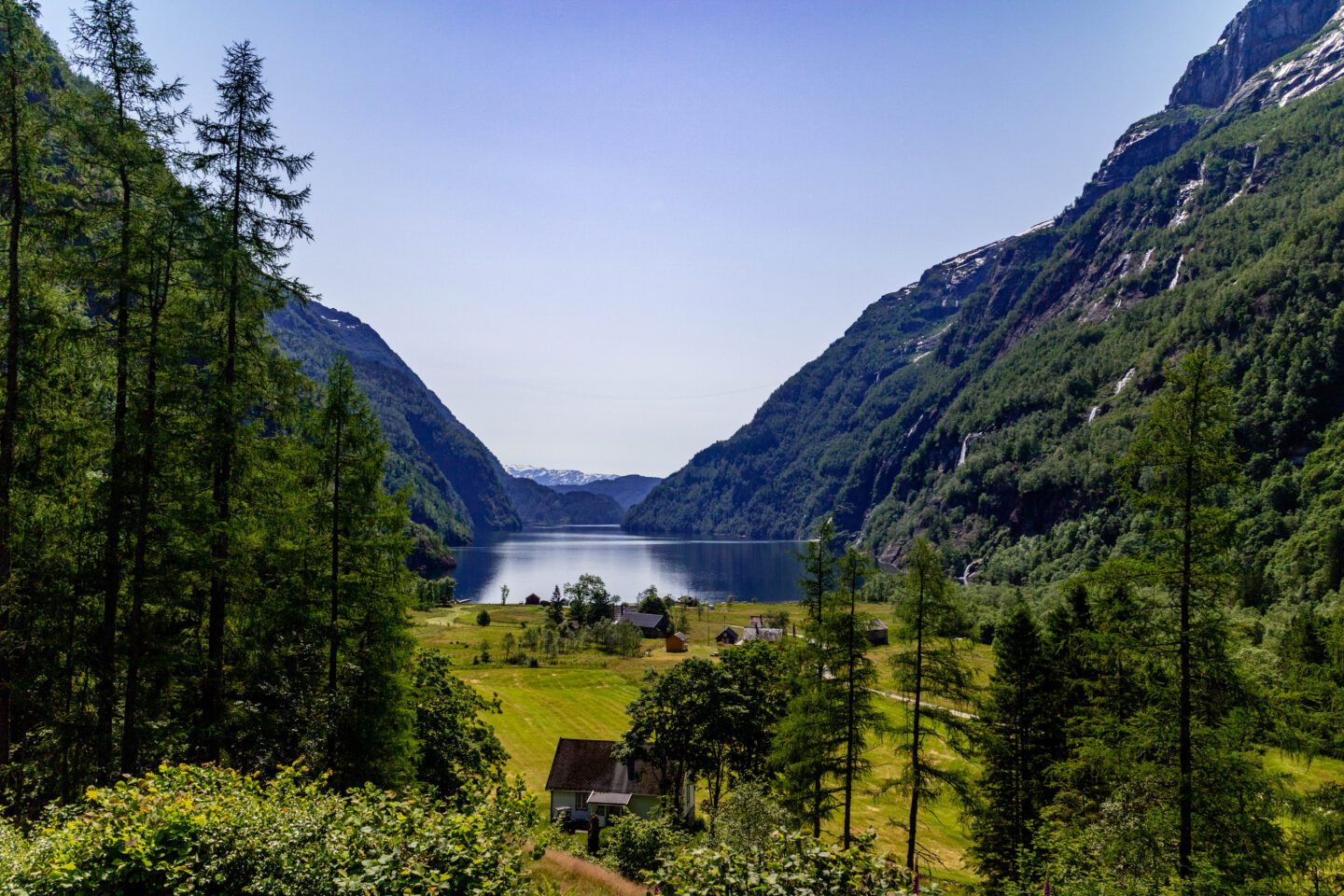
Table of Contents
What is the best time to visit Norway?
The best time to go to Norway varies with the activities you are hoping to do during your trip, and what you want to get out of your Norway vacation. In short, three things will affect your decision : the light, weather and tourist influx. All of these differ throughout the year in Norway.
Norway is located quite far north on the map, and so you can expect pretty big seasonal changes in daylight. This will 100% affect the time of year you should visit Norway.
This means that if you visit in the winter months, the majority of the day is spent in darkness with little to no natural light. Some places don’t even see the sun for months on end. Even further south, this is true, and at my parent’s house in Aurland , we spend about 3 months with no sunshine hitting our house.
On the other side, however, visiting Norway in May, June or July, will result in long days and hardly any dark at all. If you go up north, to destinations such as Alta or Tromsø , you can enjoy the midnight sun shining 24 hours a day!
The next thing that changes depending on the time of year you head to Norway is the weather. In the winter and autumn months, you can expect rainy, snowy and even windy days to be a part of your trip. Whilst in the summer the weather is more stable, and usually sunny (all though it is never guaranteed).
My favourite website for Norway’s weather forecast is Pent.no , because it compares the weather forecast from two other sites. Usually, the weather ends up being something in between the two forecasts.
Finally, the number of tourists and visitors to Norway can affect your trip. If you are bothered by masses of people, longer wait times and hoards of tourists everywhere you go – you might want to avoid visiting in the summer months.
All these things (tourist influx, weather, and daylight) I have included in my month-by-month breakdown below! Hopefully this will give you a definitive answer as to the best time to travel to Norway for you and your family.
If you have 10 days to spend in Norway, don’t miss this 10-day Norway itinerary I’ve created!
The Best Month to Visit Norway: Month-by-month Breakdown
Below I have split the best time to visit Norway into different months with details on the activities to do in those times and the kind of weather to expect.
That way, you can read the whole post and decide for yourself what is the best month to visit Norway, based on which of these sections most align with what you hope to do on your trip!
Visiting Norway in January and February
Best months for: Skiing, spotting Northern lights, snowmobiling, snowboarding, sleigh riding, dog and reindeer sledding, ice fishing, experiencing Sami culture
Tourist influx: Lowest
Weather information:
- Rainfall: 35 to 50 mm
- Average temperature: -6 to 0 degree Celsius
- Season: White winter (Coldest)
- Daylight: 6 to 8 hours in Oslo; Sun does not rise in Tromsø in January but you could enjoy 5 to 6 hours of daylight in February
January and February are the coldest months of the year in Norway. The tourist influx in the country during these months is pretty low owing to the harsh and chilly winters.
However, this is probably the best time of year to visit Norway for travellers who are interested in snow dependent activities, a relaxed ski retreat, or in seeing the Northern lights .
Especially Northern Norway is primarily a winter destination, with unique activities such as reindeer sledding, staying in an Igloo Hotel and going whale watching .
Read this next : How to shoot the northern lights with an iPhone
If you wish to make the most of the magical winters of Norway, head north towards the Arctic Circle, specifically the Northern lights belt, where the entire landscape is covered with thick snow, the fjords are frosted and the northern lights dance in colourful formations across the sky.
Best places to visit: This is the best time to visit Norway to explore Oslo , Bergen , Ålesund, Trondheim, Tromsø, Svalbard, Alta and the Lofoten Islands .
Events or Festivals: Northern lights festival, Tromsø International film festival, Ice music festival), Polar jazz festival, Sami week
Pricing: Air fare and hotel tariffs are at their lowest in January and February, so travelling during these months will definitely make for a cheaper trip.

Visiting Norway in March and April
Best months to visit Norway for: Hiking, cruising the western fjords (the Geirangerfjord and Nærøyfjord), kayaking, skiing (northern Norway)
Tourist influx: Low
- Rainfall: 40 to 45 mm
- Average temperature: -1 to 10 degree Celsius
- Season: Mixed (Late-winter and early-spring)
- Daylight: 8 to 13 hours in Oslo, 10 to 14 hours in Tromso
March and April are some of the best months to visit Norway for travellers who want to make the most of both the winter and spring seasons.
The winter snow slowly starts to melt by mid to late March and most bodies of water are filled with fresh water. Numerous waterfalls are boosted in April by melting waters and summer activities slowly open up allowing tourists to cruise the fjords. The waterfalls during these months (and moving into the next) are quite spectacular.
March is the end of Northern lights season as Norwegians welcome an Easter holiday break and head to the mountains to ski. The Jotunheimen National Park hiking season begins in April and you should not miss out on hitting the beautiful trails before the peak season crowd comes in.
Head this way for the best hikes in Norway .
Best places to visit: Bergen , Trondheim, Røros, Ålesund and the Lofoten Islands (to spot the Northern lights).
Events or Festivals: Holmenkollen ski festival, Winter chamber music festival (Røros), Narvik winter festival, Birkebeiner race, Holy week.
Pricing: Airfare and hotel tariffs are still cheap as the tourist influx has just started picking up.

Visiting Norway in May and June (the best time to visit Norway)
Best for: Road-trips, hiking, cruising fjords, trekking, island hopping, kayaking, mountain biking, fishing
Tourist influx: High
- Rainfall: 50 to 65 mm
- Average temperature: 6 to 18 degree Celsius
- Season: Spring
- Daylight: 16-17 hours in Oslo, sun hardly sets in Tromso
As the daylight time increases and spring season sets in, carpets of wildflowers add colour to the Norwegian landscape. Hence, these months are considered to be the best time to visit Norway to go hiking .
If you head above the Arctic circle, you’ll be able to enjoy the Midnight sun during these months, one of the things Norway is most famous for .
May and June are also the best months to visit Norway to cruise the fjords, with fjord cruises on the Hardangerfjord, Nærøyfjord, Geirangerfjord and even from Bergen opening for bookings.
As the weather starts getting pleasant (or as pleasant as it can get in Norway), you can indulge in several outdoor activities like hiking and trekking where you can see flowers, greenery and stunning views as far as the eye can see.
You could also plan a road trip on the very popular Trollstigen Road near Ålesund, as most of these popular tourist routes open around May (several of them are closed in the winter due to heavy snowfall).
Top tip : Always check the Norwegian road directory website before heading out on a road trip in Norway , to stay up to date on any closures and road works.
Best places to visit: Some of the best places to visit in Norway are Oslo, Ålesund, Bergen, Tromsø, the Lofoten Islands, Svalbard (to spot polar bears and the midnight sun) and Flåm .
Events or Festivals: Constitution day (the 17th of May), Bergen international festival, Tromsø’s midnight sun marathon, North cape march, Færder sailing race, Norwegian wood festival
Pricing: Airfare and hotel tariffs are high as the prime shoulder season sets in. Advance booking is advisable and travel within the country (such as trains) can sell out.

Visiting Norway in July and August (the most popular months)
Best for: Road trips , hiking, fjord cruises, trekking, island hopping, kayaking, mountain biking, fishing, surfing, snorkelling, photography
Tourist influx: Highest
- Rainfall: 80 to 90 mm
- Average temperature: 10 to 20 degree Celsius
- Season: Summer
- Daylight: 16-19 hours in Oslo, sun hardly sets in Tromso
If you are someone who is not a fan of cold weather and snow, then July and August months would be the best time of the year to visit Norway for you. It is as warm as it gets, and the days are long and bright.
There is a range of outdoor activities that you can indulge in considering the endless daylight hours and the warmer temperatures. You can explore the fjords, spot the prominent Midnight sun, hike to Pulpit rock , pick berries, bike, trail, and trek. Try to squeeze in the Sami culture celebration in Norway during these months if you are visiting the north.
This time of the year is perfect for road-trip planning across Norway, and especially a drive through Trollstigen Road (all though it is busy, so make sure to plan for plenty of time and drive within your limits).
A trip to the Lofoten islands is ideal to experience water activities like kayaking, boating, fishing, surfing and snorkelling, in addition to some incredible hikes. July and August are also the best time to visit Norway to spot the migratory birds flocking the coastline.
Top tip : hit the road and get off-the-beaten path to avoid crowds. The western fjords in particular are incredibly busy these months.
Best places to visit: This is the best time of the year to visit Norway in its entirety, however, the Lofoten islands, Stavanger, Vesterålen, Finnmark, Svalbard, Trondheim are major picks. The fjords are, as mentioned, the #1 destination during the summer months.
Events or Festivals: Gladmat (Scandinavia’s largest food festival), Riddu Riddu festival, Arctic sea kayak race, Bergen beer festival, Oslo jazz festival
Pricing: Airfare and hotel tariffs are expensive throughout Norway. Advance booking is recommended.

Visiting Norway in September and October (the best time to go, in my opinion)
Best for: Island hopping, cruising fjords, hiking, trekking, fishing, mountain biking, photography
Tourist influx: Fairly low
- Average temperature: 5 to 15 degree Celsius
- Season: Autumn/ Fall
- Daylight: 11 to 14 hours in Oslo as well as Tromso
In the autumn season (September and October), the locals often go one weekend trips before winter sets in, whereas the tourist crowd slowly recedes.
September is my favourite month of the year, and also my top tip for the best time to visit Norway.
The coastal areas remain warmer than the inner parts of the country. September and October are the best months to visit Norway for those looking to stay away from the tourist crowd, save some money and yet enjoy the perks of the beauty that the country has to offer.
The colours of the summer are still there, opening hours and activities are still running the same schedules as in June-August, and there are (slightly) less tourists than the high season.
As autumn approaches in the end of September, the beautiful colours start to show up and the landscape gets covered with hues of orange, red and yellow, ideal for photography .
The mountain hikes are the prettiest during these months with trees shedding colourful leaves and vistas are covered in sparkling frost towards the end of October.
The outdoor activities slowly start closing up by October, though the fjords can still be explored. By October end, you could again plan to voyage towards the northern parts of Norway to chase the Aurora borealis.
Read next : how to take photos of the Northern Lights with just a GoPro
Best places to visit: This is the best time to visit Norway to explore Oslo, Bergen, Kirkenes, Lillehammer, Bergen, Flåm, Ålesund, Geiranger, Trondheim, Tromsø, Lofoten islands and more
Events or Festivals: Bergen food festival, Nordic light photo festival, Insomnia festival, Lillehammer jazz festival, BIFF (Bergen International Film Festival)
Pricing: Airfare and hotel tariffs are affordable owing to the scaling down of tourist season.
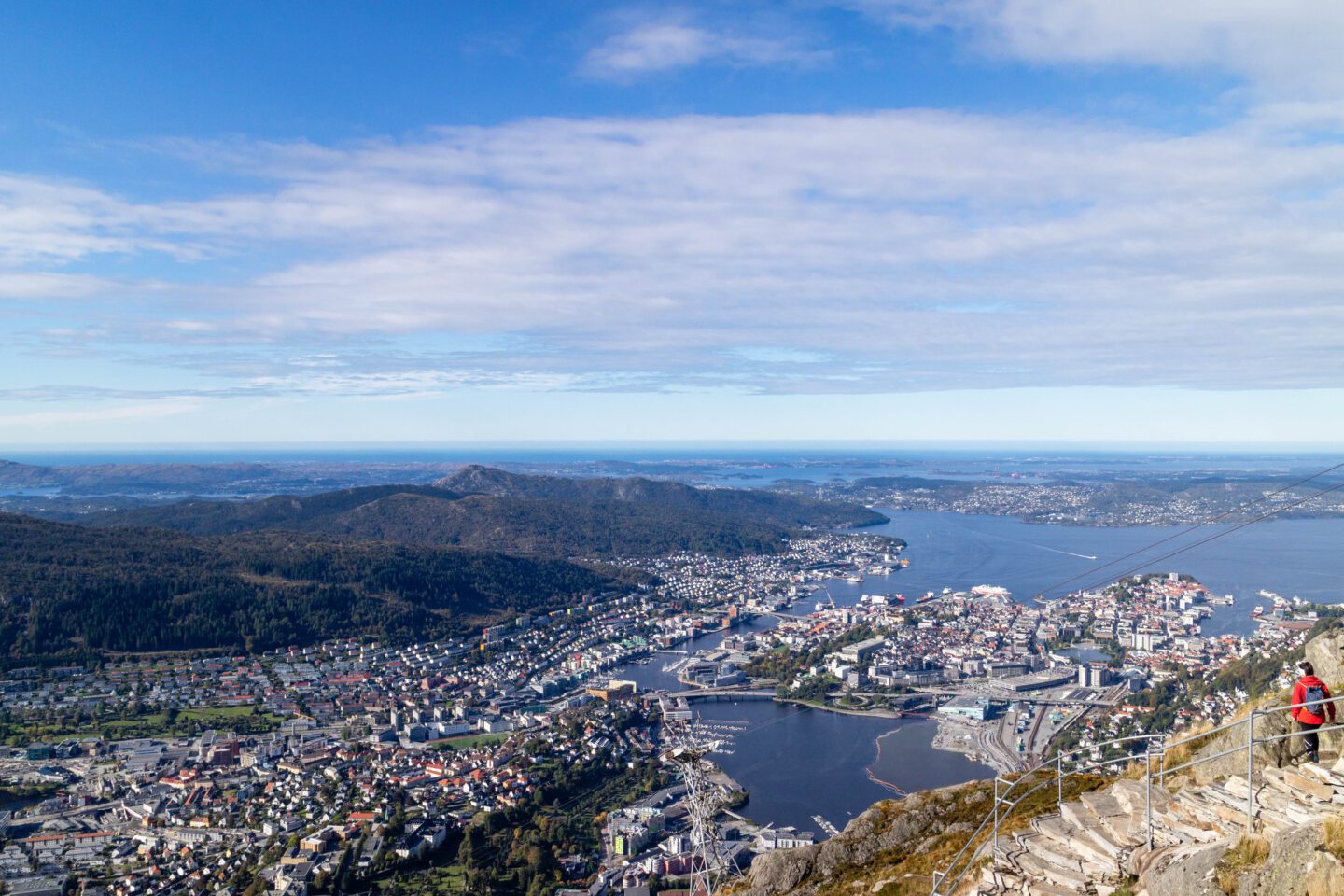
Visiting Norway in November and December
Best months for: Chasing Northern lights, skiing, snowboarding, experiencing Sami culture, spotting whales and orcas, kick-sledding, dog sledding, reindeer safaris, rock art, Christmas/holidays
Tourist influx: Low; slightly higher during Christmas and New year
- Rainfall: 55 to 70 mm
- Average temperature: -5 to 5 degree Celsius
- Season: Dark Winter (Cold)
- Daylight: 6-8 hours in Oslo, sun barely rises in Tromso
While the tourist season has pretty much declined, festivities sets in for the Christmas and New year. Despite the chilling cold, the celebrations bring in warmth and cheer.
Note that opening hours are very limited in some areas. This is one of the reasons it’s important to be prepared and book things early when visiting Norway for Christmas .
Decorations sparkle against the dark winter, and visiting Norway in December is the perfect time of year if you want to see how Norwegians celebrate Christmas .
The Northern lights season starts again and it is the best time to visit Norway for tourists seeking to find snow and chase the Aurora borealis without the crowds of January and February. Most people catch them on a Tromsø northern lights tour .
The lakes and some fjords slowly start to freeze. The days are dark and snowy, and daylight hours tend to become few (with some areas only experiencing 1-2 hours of daylight).
You could spend time doing indoor activities like visiting museums in Oslo or testing out all the restaurants in Bergen for mouth-watering local Norwegian delicacies. Read and bookmark my packing list for winter in Norway before you go to ensure you have everything you need!
Best places to visit in Winter: Svalbard, Kirkenes, Tromsø, Lofoten islands, Oslo, Trondheim, Rorøs, the fjords
Events or Festivals: Rakfisk festival, Rorøs Christmas market, Nobel peace prize ceremony, Christmas holidays, the Bergen gingerbread town (the largest in Europe, I believe)
Pricing: Airfare and hotel tariffs are low but tend to spike during the Christmas and New year time.

The Best Time of Year To Visit Norway: Activity-Focused
Below I try to break down what the best time to visit Norway is according to the activity you are planning. From hiking to exploring the fjords, you’ll find that there are different times of year that are ideal.
Best time to visit Norway fjords
In my opinion, the best time to visit Norway if you want to see the fjords is in May and June . During these months, the colors of the scenery are at their brightest, creating a breathtaking visual experience.
Additionally, this is when the waterfalls are most dramatic, cascading down from the mountains in all their glory. It is truly a sight to behold. If you’re planning a fjord cruise in Norway, these months offer the perfect conditions to fully appreciate the natural beauty of the fjords. So, mark your calendars and get ready for an unforgettable adventure.
Below are some of the best fjord cruises in Norway – I always recommend booking early, as they can sell out.
Best time to visit Norway for hiking
I believe that the best time to visit Norway for hiking is during the months of August and September. During this time, you can witness the breathtaking autumn colors as they start to emerge. The snow has completely melted, making it easier to explore the beautiful landscapes.
Moreover, the temperatures during these months are quite pleasant, allowing for a comfortable hiking experience. If you are looking for some remarkable hiking trails, I highly recommend checking out Aurlandsdalen valley and Pulpit Rock .
These trails are particularly enchanting during August and September, offering stunning views and unforgettable experiences. So, grab your hiking boots and get ready to immerse yourself in the natural beauty of Norway!

The Cheapest Time to visit Norway
Norway is known for its breathtaking landscapes and unique experiences, but it’s no secret that it can be an expensive destination. However, if you’re looking to plan a budget trip to Norway, there’s a silver lining.
During the winter months, specifically in January and February, you’ll find that flights and hotels are more affordable compared to the rest of the year. This presents a great opportunity to explore Norway without breaking the bank. While it’s true that Norway’s natural beauty remains unchanged throughout the year, keep in mind that tours and restaurants don’t generally lower their prices during the winter season.
So, if you’re looking to experience Norway on a budget, visiting during the winter months is definitely a safer bet.
Read next: Oslo on a budget
Final Thoughts
Like I’ve said before, Norway is magnificent all year round. But if you ask me, my (personal) favourite months to visit Norway are February/March (for snow, ski and Northern lights) and September (for all the benefits of visiting in the high season, but with slightly less crowds and the addition of autumn colours).
Hopefully, this guide will make it easier for you to plan your trip to Norway .
Are you planning a trip to Norway? Then you’ll want to read my Norway travel guide , which covers everything from where to go and stay to how much to tip when visiting.
Head this way next:
- Norway itineraries for your trip
- My complete Norway travel guide
- How to plan a trip to Norway
- The Best Places to Visit in Norway
- My travel guide to Flåm and the fjords
- How to get from Oslo to Flåm
- How to get from Bergen to Flåm
- Norwegian sweater you’ll love
Regardless of what time of year you end up visiting Norway, there are so many amazing things to do here. From whale watching and chasing the Northern Lights in the winter, to going on a beautiful fjord cruise in the summer – you won’t be bored.
Below, you can browse some of the best tours and activities across Norway. Make sure to make your bookings in advance, as they tend to sell out fast!
Swimming with Turtles in Akumal, Mexico
Norwegian sweaters: everything you need to know (nordic wool sweater guide), you may also like, how to be a tourist in norway, 10 ridiculous questions tourists in norway have *actually*..., how to plan a trip to norway [a..., 5 fun things to do in oslo with..., top things to do in oslo, norway [a..., 15 free attractions in oslo [a local’s guide], the best museums in oslo, norway [a local’s..., the best beaches of punta cana, the 7 best emerald coast beaches [florida], the best hotels in oslo, norway [budget to..., leave a comment.
Save my name, email, and website in this browser for the next time I comment.

The Best Time of the Year to Visit Norway
When to go to Norway is a common question among first-time Norway travelers. The best time to go to Norway suitable for most travelers is early summer, especially the months of June and July. The weather is pleasant and the days are long however it is also peak season. The other seasons offer plenty to do, though it can be cold and days are very short.
Compared to some of its Northern neighbors, Norway's weather is quite mild. That's because of the Gulf Stream which gives it a temperate climate, however temperatures can vary wildly depending on where in Norway you are. More northern areas can have temperatures reaching into the 80s Fahrenheit (27 degrees C) during the summer and some of the snowiest winters. Generally speaking, Norway experiences four seasons with cold winters and mild summers. For more detailed informations, read our guide to the weather and climate to Norway .
Tourist Attraction Availability in Winter
Many major outdoor attractions, including some mountain hiking paths, are closed in the winter. The large amounts of snow coupled with cold conditions make it dangerous for people to visit. If there are trails or outdoor sights you especially want to see, look up the closure schedule before booking your flight. Whatever you do, do not ignore closures and posted warnings. They're there for your safety.
Peak Season in Norway
The summer is Norway's peak season. The weather is nice and the longs months of darkness are broken with almost constant daylight. Because of that expect lines at popular attractions to be longer. Accomodation and flights will also likely cost more. To get the best of both worlds, plan your trip for late Spring or early fall. May and September are wonderful alternatives for when to go to Norway and get lower rates, and the weather in Norway will still be mild enough for outdoor activities and sightseeing.
Even though it's spring the weather will still feel like winter. Don't expect temperatures much higher than 40 degrees F (4 degrees C) though days are starting to get longer. Ski season also stretches well into spring with resorts open as late as April. In May it's warm enough to enjoy the outdoors and summer tourists haven't started arriving yet.
Events to check out:
- The biggest literary festival in the Nordic region happens every May in Lillehammer. Celebrating its 25th year in 2020 the festival has readings, concerts, exhibitions, and more.
That's the time of the Midnight Sun , so you'll get very long days in southern Norway or even sunshine around the clock in northern Norway. And with the warm weather, there are many things to do and places to go in Norway. You can hike the mountains, explore the fjords, or get to know the country's cities. The months of June and July are also the time for Norway's highest tourism levels, so while all sights and attractions will be open, you will see some tourist crowds.
- See short films from Norwegian and international filmmakers at the Grimstad Norwegian Short Film Festival in June.
- Adventurous travelers flock to Voss in late June for a week of extreme sports at Ekstrem Sport Veko .
Fall is the ideal time to visit for travelers looking to save money. The weather is starting to cool off but hasn't reached the winter lows yet. Fall is also a shoulder season as summer is over, but the ski season hasn't started yet. As such lodging and flights are cheaper in fall than in other seasons however popular outdoor attractions have begun to close. If you're traveling to Norway to see some natural beauty, time your visit for September when the weather is still mild enough for sightseeing. Northern lights season begins in October.
- Jazz lovers should head to Lillehammer for the DølaJazz Festival in October for performances from local and foreign musicians.
Days are very short in the winter, lasting only 5 or 6 hours. However the upside to the short days are the ample opportunities to see the Northern Lights. Winter can also be bitterly cold. Much of the country will be covered in snow so if you don't like the cold stuff, visit during a different time. Avid skiers and snowboarders can start hitting the slopes as early as November. Besides hunting for the Northern Lights, expect to spend time doing indoor activities like exploring a museum or two or catching a live show.
- The Tromsø International Film Festival is the country's largest and it takes place each January. In 2019 more than 60,000 films were submitted. Also because of the short days, films can be screen outdoors.
- Stay in Tromsø to enjoy music of all genres, stage performances, lecutures, exhibitions and more at the Northern Lights Festival from the end of January to February.
- Bundle up and head to the Ice Music Festival in Finse on Feb. 7 and 8. Celebrating 20 years in 2020 this festival features music played entirely on instruments made from ice.
The Best Time to Visit Spain
The Best Time to Visit Naples, Italy
The Best Time to Visit France
Weather in Iceland: Climate, Seasons, and Average Monthly Temperature
The Best Time to Visit the French Riviera
The Best Time to Visit Boston
The Best Time to Visit Marseille
The Best Time to Visit Morocco
The Best Time to Visit Japan
The Best Time to Visit Sweden
The Best Time to Visit Cape Town
The Best Time to Visit Finland
Weather in Norway: Climate, Seasons, and Average Monthly Temperature
The Best Time to Visit Iceland
The Best Time to Visit Munich
The Best Time to Visit Calgary, Canada
- Search Please fill out this field.
- Manage Your Subscription
- Give a Gift Subscription
- Sweepstakes
- Travel Tips
The Best Times to Visit Norway for Northern Lights Viewing, Fjord Cruising, and More
Here are the best times to visit Norway, according to travel experts.
:max_bytes(150000):strip_icc():format(webp)/Stefanie-Waldek-7eed18a8c9734cb28c5d887eb583f816.jpg)
Best Times to Visit for Smaller Crowds
Best times to visit for good weather, best times to visit for lower prices, best times to visit for the northern lights.
- Worst Times to Visit
Christopher Larson/Travel + Leisure
Norway is a year-round destination known for its breathtaking fjords, dazzling northern lights, and robust Viking history. "Norway is so long and diverse, and each part of the country has its own seasonality," Torunn Tronsvang, founder of travel company Up Norway , tells Travel + Leisure. "The best time to savor Norway's diverse climates depends on travelers' preferences."
Generally speaking, summers are mild with long daylight hours, providing ample opportunity for outdoor adventures like hiking and biking. And winters might be cold and dark, but they’re ideal for northern lights viewing — plus, there's no better time to spend indoors at museums and cultural institutions. Here's a breakdown of the main tourist seasons in Norway:
- High Season: June to August and December
- Shoulder Seasons: September to October and April to May
- Low Season: November and January to March
Choosing the best time of year to visit Norway depends on what you want to do during your visit — read on to find out more.
Meet the Expert
Torunn Tronsvang is the founder of Up Norway, a travel company that plans trips to the Scandinavian country.
Matthew Valentine is the head of sales for the U.S. and several other countries at Havila Voyages, a Norwegian cruise line.
Christopher Larson/Travel + Leisure
Nobody wants to travel with crowds, but they do typically coincide with the best time of year to visit a destination, often in terms of weather, but also in terms of school holidays. In Norway, the peak seasons are summer and the holiday break in December, so you'll likely want to avoid these periods if you're looking to visit when there are smaller crowds. "The spring and autumn periods are slightly quieter than summer and holiday peaks, but Norway is just as mesmerizing and filled with nature and features to explore," says Matthew Valentine, head of U.S. sales at Havila Voyages , a Norwegian cruise line.
If you are visiting in peak season, consider heading off the beaten track to avoid crowds. With some 150,000 square miles of land in Norway, it shouldn't be too hard to find some personal space. "For an untouched gem, explore the untamed Varanger Peninsula, where solitude meets stunning landscapes throughout the year," says Tronsvang.
Taylor McIntyre/Travel + Leisure
“Good” is quite a subjective term when it comes to weather. "Many people would argue that it depends on what you consider the best weather and what kind of adventure or experience you are looking to enjoy," says Valentine.
Since it can rain or snow throughout the year, good weather in Norway typically refers to temperature — and most commonly, people consider good weather to be warm weather. "The warmest weather is in the height of summer, which is a perfect time for hiking, exploring, and rigid inflatable boat (RIB) adventures along the stunning Norwegian coastline," says Valentine. Tronsvang is particularly partial to June weather. "June, with its perpetual daylight and blooming landscapes, offers a mild and radiant summer experience," she says.
All that said, if you want to enjoy wintry activities that require snow, such as skiing and snowmobiling, the best weather will be found in the winter months — but you'll definitely need to bundle up.
Lara D'Agostino/Travel + Leisure
"For optimum value, steer clear of Christmas holidays and the bustling June to August period," says Tronsvang. If you visit Norway in early autumn, which is the more affordable shoulder season, you'll still benefit from warmer temperatures — and have a chance to see the northern lights, which can be seen as early as September and as late as March. But the low season of November and the post-holiday period are the cheapest times to visit. "Notably, November, though considered off-peak, boasts a unique charm with its magical play of light and is a haven for food enthusiasts seeking an authentic local experience," says Tronsvang.
Keep an eye on the exchange rate between U.S. dollars (USD) and Norwegian kroner (NOK) to help maximize your savings. "Travelers can capitalize on favorable conditions regarding the current USD to NOK exchange rate, which is at a great spot now," says Tronsvang (as of December 2023).
Norway is one of the best places in the world to see the northern lights , given its northern location on the globe. Though the northern lights technically occur year-round, you need darkness to see them. And in Norway, darkness isn't always guaranteed. Much of the country experiences extremely long daylight hours in the summer, limiting aurora viewing opportunities.
"Without a doubt, October through to March is the best time to visit if you want to see the northern lights," says Valentine. "In fact, we are so confident that the lights will make an appearance during our 11-night round-trip voyage during this period, that we offer a ‘Northern Lights Promise’’ If the lights don’t show, we will offer you a free six- or seven-night cruise the following winter."
There are also ample ways to go northern lights hunting inland, from dog sledding excursions out into the wilderness to overnight stays in glass igloos.
Related: Northern Lights, Explained: What They Are and How to See Them
Worst Times to Visit
It sounds cliché, but there truly is no bad time to visit Norway, as each month of the year provides its own perks. For instance, visiting in the "low" season might mean you're dealing with colder weather, but you get the benefit of fewer crowds and cheaper rates (and northern lights). "The Norwegians have a saying that ‘there is no such thing as bad weather, just bad clothing!’ says Valentine. Conversely, for some travelers, peak season might actually be the worst time to visit Norway. This is when you'll experience the largest crowds and the highest rates — not ideal for solitude-seekers who are looking for a good deal.
To ensure you're visiting Norway at the best time, really think about what kinds of activities you're looking to do. If you want to see the northern lights, for example, summer would be the worst time to visit, since they're usually not visible then.
Thanks for visiting nordicvisitor.com! For the very best browsing experience on our website, we urge you to upgrade to the most recent version of your browser . Some of our site features may not function properly on older versions.
- Travel Update
- Search Suggested Results View All Results
- EUR (€)
- GBP (£)
- Self-Drive i
- Privately Guided i
- Guided Small Groups i
- Northern Lights i
- Honeymoon & Romance i
- Ice & Snow Hotels i
- Multi-Country Tours i
- All Travel Styles
- Show all tours
- Best Sellers
- Special Offers
- Scandinavia
- Switzerland
- United Kingdom
- Book With Confidence i
- Why book with us i
- Booking Terms i
- Sustainability Policy i
- Manage Booking
- Privacy policy
Iceland Bíldshöfði 20 110 Reykjavík +354 578 20 80 View Map
Sweden Scotland View Details
When is the Best Time to Go and Visit Norway?
When planning a Scandinavian getaway you might find it important to know when is the best time to visit Norway. The truth is that this beautiful Nordic nation is a worthy travel destination year-round, so it’s hard to go wrong!
Having said that, each season has its own unique benefits. The summer is perfect for fjord cruises and road trips. The winter is the ideal time to spot the northern lights and take part in snow-based activities.
To learn more about the best time to go to Norway, read this guide to the 4 seasons followed by our travel experts’ answers to frequently asked questions.
You’ll know what to expect at each time of year, what activities are best as well as when and where to go in Norway for your ideal trip.
- Explore these summer tours of Norway to find the itinerary that’s perfect for you
- Or browse winter trips for an adventurous Nordic getaway
- Visit Norway in summer
- Visit Norway in autumn
- Visit Norway in winter
- Visit Norway in spring
- Going on an adventure to Svalbard
- Travelling along the Norwegian fjords
- Taking advantage of the best weather
- Visiting the capital Oslo
- Journeying north to Tromsø
- Discovering Ålesund
- Combining Norway with Sweden and Denmark
- Admiring the northern lights
- Visiting both Norway and Iceland
- Wandering around Bergen
- Touring onboard a cruise
- Hiking in the beautiful landscape
- Enjoying the midnight sun
- Going whale watching
- What to pack for your trip to Norway
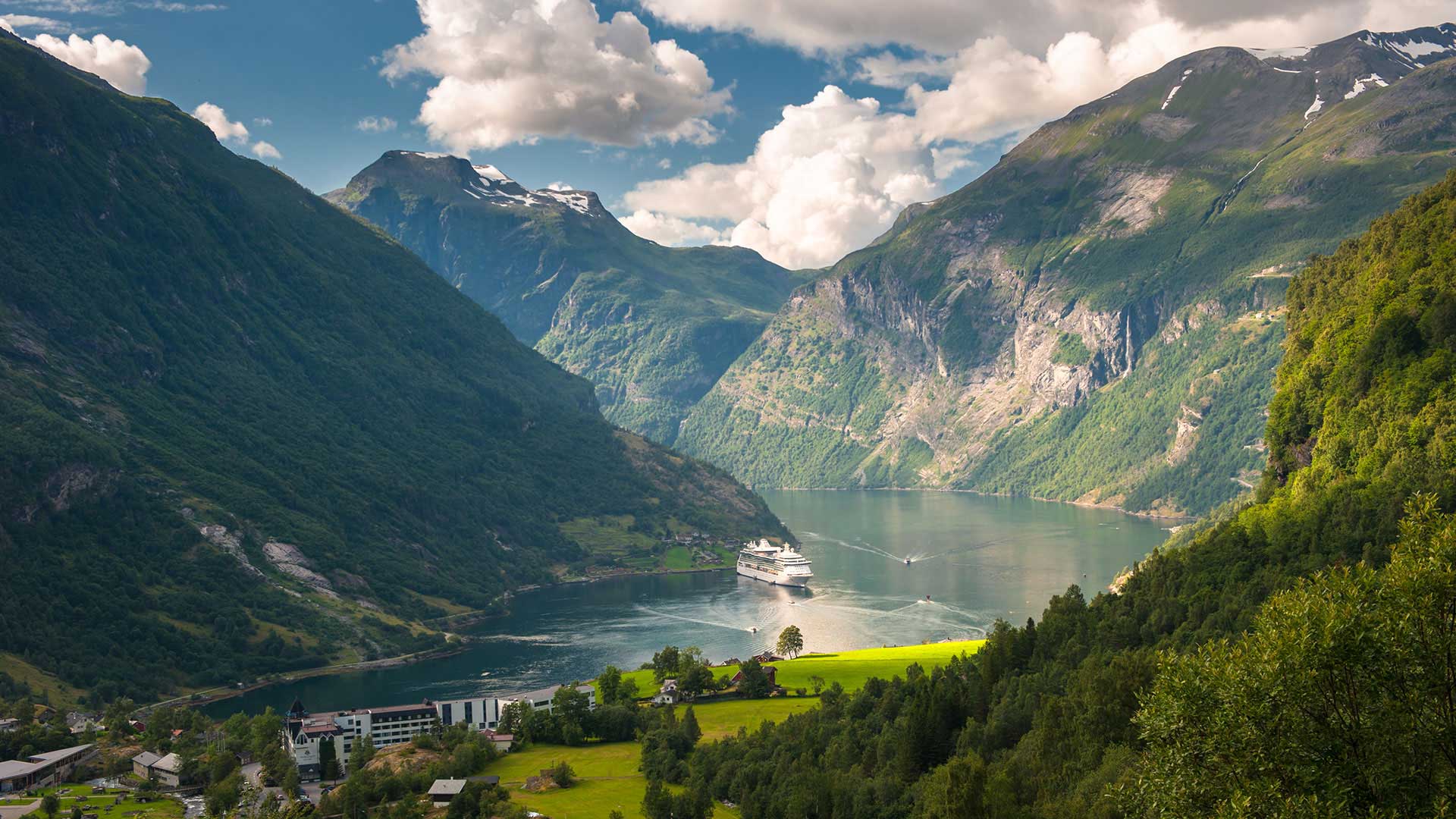
Norway in summer
Best for enjoying the midnight sun & warm waters
June to August is a fantastic time to visit Norway if you want to take advantage of the country’s legendary midnight sun. At this time of year, the days are long and pleasant, and greenery stretches as far as the eye can see.
How’s the weather?
While temperatures in the north (for example in Tromsø) stay low at around 11°C (52°F), temperatures in the south climb into the 20s°C (68°F +). Perfect summer temperatures to enjoy sightseeing.
Best places to visit
The warm weather, endless daylight hours, and good road conditions mean it’s a perfect time for taking on a road trip ! You could leave from the capital, Oslo, and head toward the western fjords region.
Make sure to stop by the famous and UNESCO World Heritage-listed Geirangerfjord .
If you’re keen to venture into the real north of Norway, summer is a good time to go if you want to avoid the coldest, snowiest weather.
We especially recommend touring the Lofoten islands , just north of the Arctic Circle. This charming archipelago is an idyllic place to enjoy nature, hike, kayak, cycle, boat and fish to your heart’s content. Just drink in the astonishing scenery under the midnight sun.
- Look up summer self-drive tours of Norway
- Or take up the epic Norway in a Nutshell ® train and cruise itinerary
Fun activities to do
The warmer weather of the summer means the lakes warm up nicely, making them ideal for wild swimming. Even if you don’t take to the water yourself, you can still make the most of the weather. How abouta boating or kayaking trip?
If you’re in Bergen, you could try the Mt Ulriken zipline. This would allow you to experience the city from a different perspective.
And if you’re a lover of birds, it’s a great time to come to Norway for birdwatching. There are interesting safaris available at this time of year. We can suggest the one in Honningsvåg, in the north of Norway.
Mark your calendar for these fun summer events:
- Riddu Riđđu, an international indigenous festival hosted in July each year. It takes place in Kåfjord, 2 hours outside Tromsø in Northern Norway.
- The Norwegian International Film Festival happens every August in Haugesund, 2 hours outside Stavanger.
- Midnight Sun Marathon is held in Tromsø each June.
- Norwegian Wood, one of Oslo’s best music festivals, also happens to be scheduled for June.
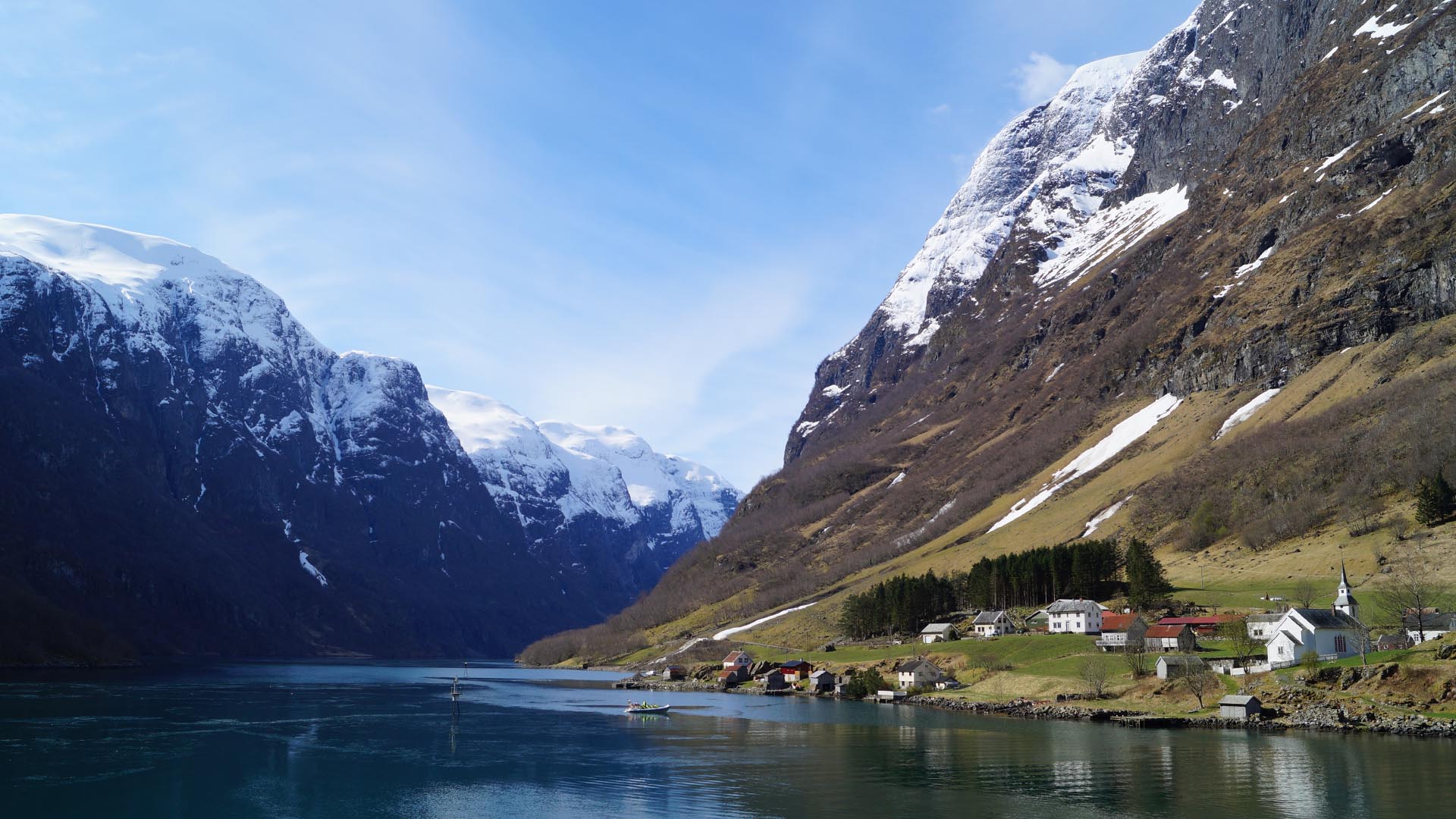
Norway in autumn
Best for enjoying crisp nights & scenic hikes
Between September and November , Norway is transformed. The lush greens of the summer have been replaced with the fiery autumnal shades of yellow, orange and red. At this time of the year, the landscape is on the cusp between colourful foliage and the frost of first snow.
This is the perfect time of year if you enjoy hiking, and especially if you are seeking a quieter ambience. October and November in particular see a drop in visiting travellers, meaning you’ll have more of the sights to yourself.
This is the time of year when the weather in Norway starts to change as the winter approaches. In Oslo, average temperatures come down to around 6°C (48°F) in October, while in the north they are only around 2°C (35°F).
The cities are must-sees during this season as you have plenty of places to visit, such as museums and attractions. You could make your way between Oslo and Bergen, taking on the iconic Norway in a Nutshell® journey.
Going through the country toward the west coast is an ideal way to spot all the gorgeous landscapes, marked by the colours of autumn.
If you’re looking for a fantastic wildlife experience, make sure to head north, maybe on a Havila or Hurtigruten cruise all the way to Kirkenes . This is a good time of year to spot sea life, such as humpbacks and orcas, in the chilly northern waters.
The crisp weather of autumn means it is a great time if you love hiking and are always seeking an interesting viewpoint.
In September and October, you could take on famous hikes to Pulpit Rock , or even Trolltunga. That said, we recommend following local safety advice and weather warnings when out hiking.
You can’t think of the Norwegian autumn without of the aurora borealis. This time of year is the start of the season for going on northern lights tours in Norway .
Mark your calendar for these autumnal events:
- Bergen International Film Festival held at the end of September.
- Dark Season Blues, a music festival held in Longyearbyen in Svalbard each October.
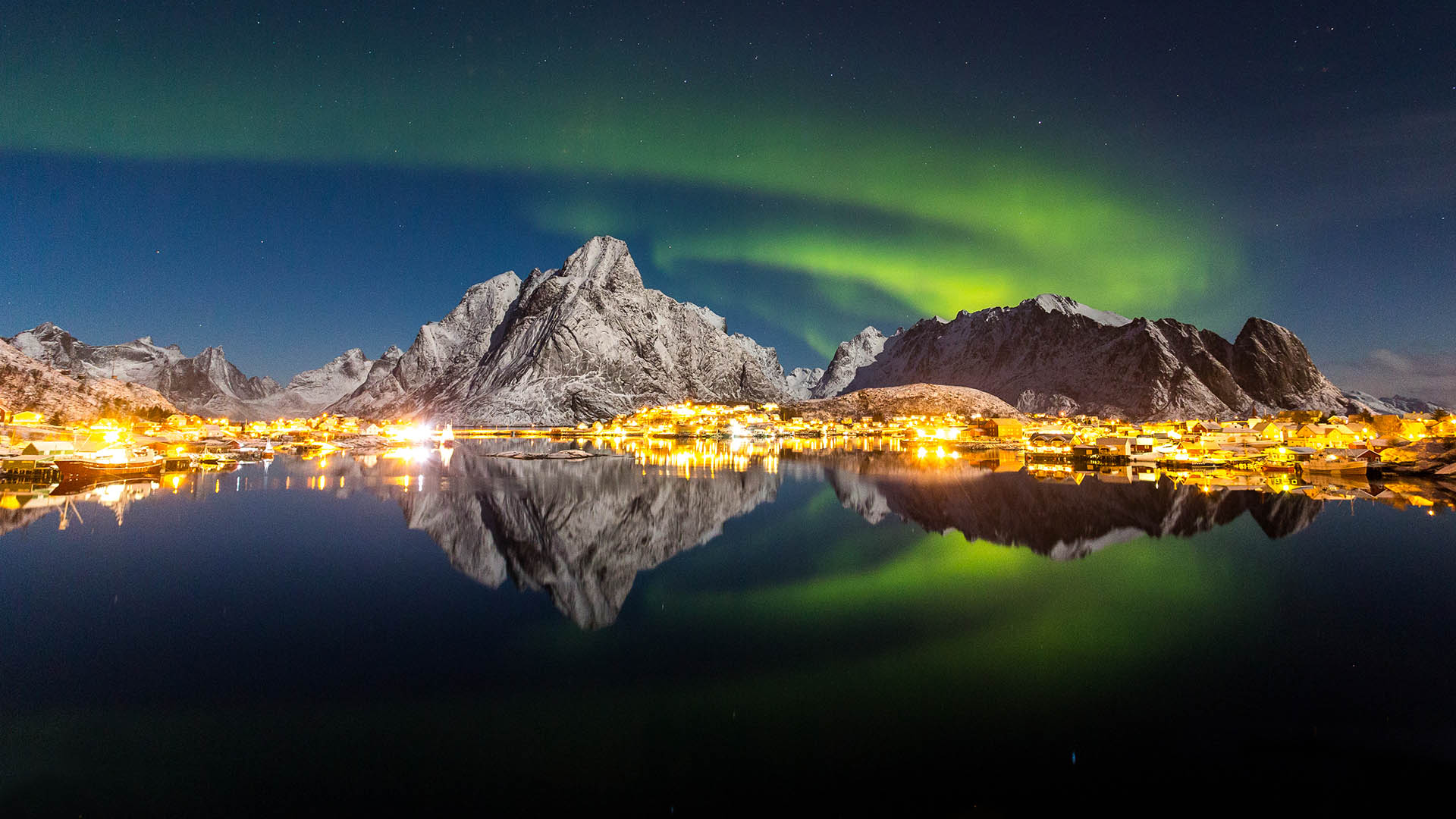
Norway in winter
Best for enjoying the northern lights & winter sports
Norway’s winter is magical! While these months may be cold and dark, the beauty of the landscapes more than makes up for it. The country is draped in thick snow, and the fjords are transformed into mystical ice realms.
If you’re looking for the best time to travel to Norway to witness a snowy wonderland, this is it.
Some roads are closed over the winter months, but you can enjoy cruises and train journeys all year long.
It’s a great time of year to travel through the snow-capped mountains and keep an eye on the dark skies. You may be lucky enough to spot some colourful dancing lights in the sky as well!
Temperatures fall to an average of -3 or -4°C (25°F) in both the capital and the north. By the coast, however, which enjoys a more temperature climate, it stays around 2°C (35°F).
Make sure to head north! Within the Arctic Circle, you’ll be able to enjoy the true meaning of winter.
One of the key draws of a winter trip to Norway is of course the northern lights. And the best location to have a chance to spot them is in Northern Norway.
In fact, there is a zone called the “Northern Lights Belt”, situated from 65 to 72 degrees north. It’s known for having the highestt auroral frequency and intensity. The closer you are to it, the better your odds are!
Both the city of Tromsø and the Lofoten islands fall directly within this area, so we highly recommend these destinations. You could also take on an Arcticcruise to the North Cape and Kirkenes. In fact, these are some of the best cruise journeys in Norway .
- Book a tour to Norway to spot the northern lights with these winter itineraries
- Related: 10 things to do when you visit Norway in winter
Winter may be the ‘off-season’ in some places, but in Norway you’ll find plenty to do! And we don’t mean just looking out the train window at the gorgeous mountains above, or searching for the northern lights.
In the winter months, you’ll be able to enjoy a host of unique activities, including reindeer- and dog-sledding. You could learn more about Sami culture, stay at the SnowHotel , or even chase the northern lights by snowmobile.
Stay the night inside a snow hotel with these ice hotel packages to Northern Norway
Near Oslo, you could visit the Holmenkollen Ski Museum and Tower . The museum is the oldest of its kind in the world and showcases more than 4,000 years of skiing history. Head up to the observation deck at the top of the jump tower for views of Oslo.
Another great place to experience the true north is in Svalbard – a Norwegian archipelago located closer to the North Pole. It is one of the world’s northernmost inhabited areas and is famous for its number of polar bears.
Mark your calendar for these winter events:
- Ice Music Festival, a glacial event happening every February in the alpine resort town of Geilo .
- Northern Lights Festival, a 10-day music festival held in Tromsø every January.
- Rørosmartnan held in February and considered the largest winter festival in the country.
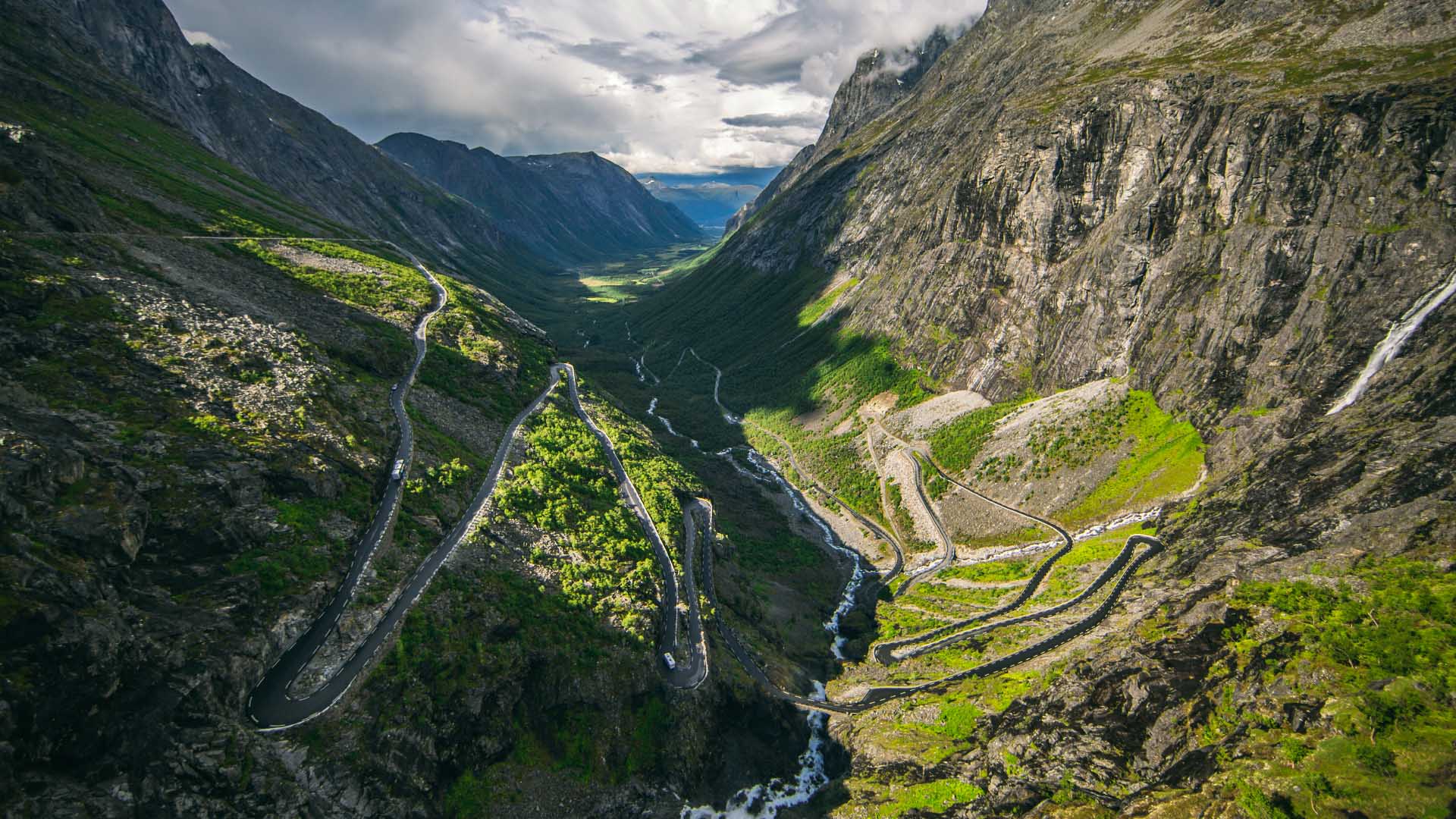
Norway in spring
Best for enjoying flora and bird watching
March , April and May are also beautiful months to visit Norway. As the winter snows melt, the rivers, lakes and waterfalls swell with fresh water and life. Snow-draped landscapes fade away and are replaced with swathes of lush green.
From April to May the weather rises between 0 and 11°C (32-52°F) in Oslo , and up to, on average, 4°C (39°F). As this is a changeable season, you never know as it may inch a bit higher or lower.
You’ll definitely enjoy the fjords in the spring! The western fjords are gorgeous all year long, but in the spring, the landscape transforms from wintry to luxuriant.
We recommend taking a coastal cruise from Trondheim down to Bergen, admiring the coast along the way. At this time of year, many summery activities reopen their doors so you can take advantage of these before the summer boom.
Boosted by the meltwaters, the waterfalls of Norway are at their most formidable during spring. You could go on a kayak or rib boat tour at Geirangerfjord to get close to the stunning Seven Sisters and Bridal Veil waterfalls.
One of Norway’s biggest attractions at this time of year is also the spring blossom. By May, the flowers are in full bloom across the country and, on a sunny day, the scenery can be out of this world.
In May, when the nicer weather has usually settled in, some roads reopen. One you won’t want to miss is the Trollstigen road near Ålesund. You could make sure to drive it on a road trip, or to book an optional excursion to go experience it.
Mark your calendar for these spring events:
- Stavanger Vinfest, a food and wine festival held in April.
- Constitution Day on 17 May, celebrated all over the country.
- Bergen International Festival beginning in late May.
Best time to visit for…
If you’re wondering when the best time of year to visit Norway is for a specific activity or to visit a certain location, read below. Nordic Visitor’s travel experts share their insider tips to help you plan your ideal trip.
Best time to visit Svalbard, Norway
A great place to experience the true north is in Svalbard – a Norwegian archipelago located halfway to the North Pole. It is famous for having more polar bears than human inhabitants.
If you’re keen to fly north, we recommend going between February and September. That is because of the number of daylight hours available during those months.
In the depth of winter, the region experiences a polar night and therefore the sun doesn’t rise at all. From February, you get a better balance of darkness, to spot the northern lights, and daylight, to go on excursions.
You’ll want to be able to admire the glittering icebergs, frozen tundra and maybe even spot the elusive white bear.
- Check out these fun tours of Svalbard
- Related: Read a first-hand account of a special visit to Svalbard
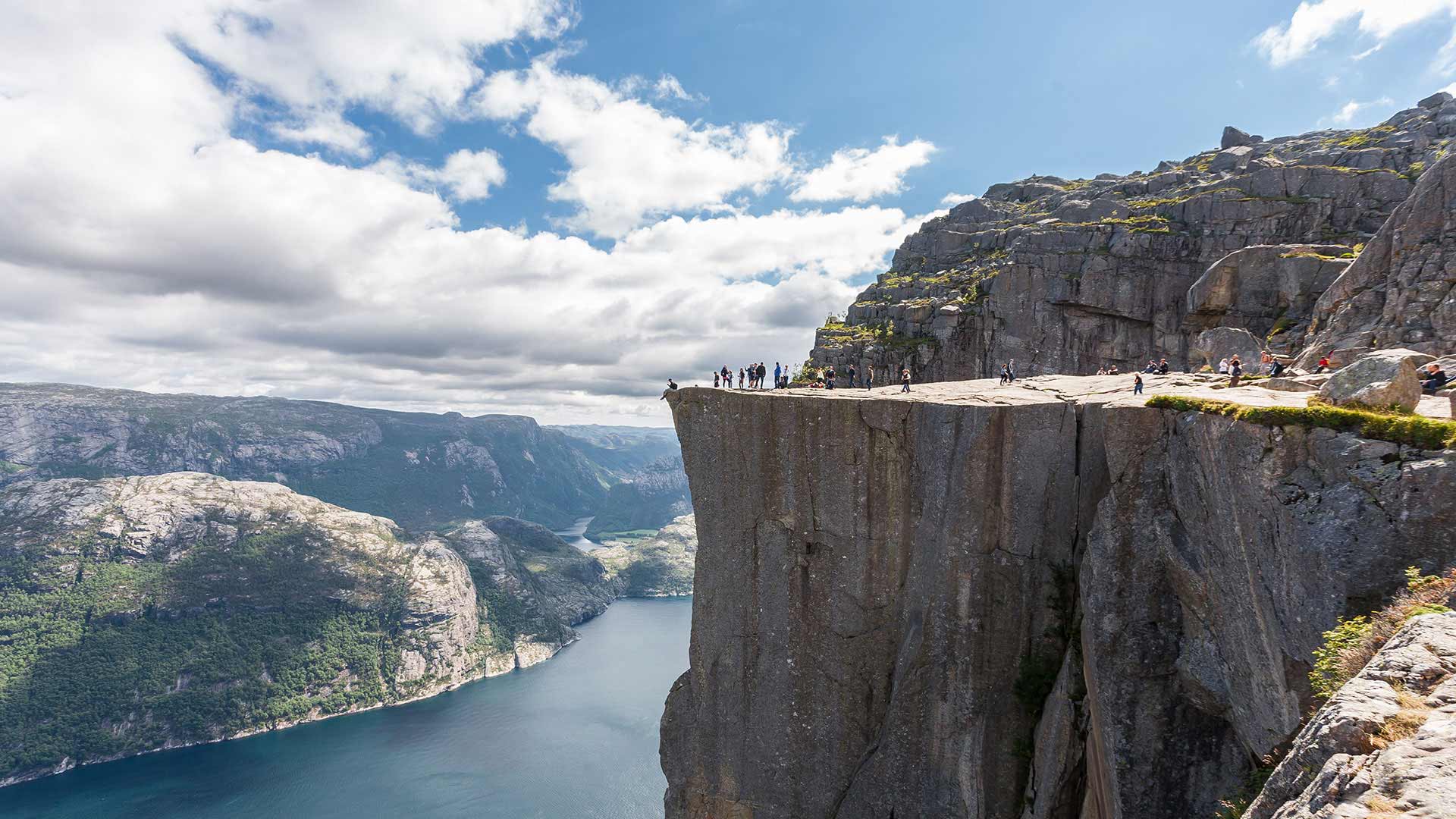
Best time to travel to the Norway fjords
The Norwegian fjords are amongst the most beautiful in the world. It is no wonder that the West Norwegian Fjords, Geirangerfjord and Nærøyfjord , are listed as one of Norway’s UNESCO World Heritage Sites . Picture tranquil waters, thundering waterfalls, and sheer mountain faces.
To see the fjords in all their glory, the summer is a great period for a visit. At this time, you could go kayaking along a fjord to take it all in from a different perspective. You could even try dipping your toes in or going wild swimming.
But there are benefits to the other seasons too. Come in spring to see the waterfalls running with even more power thanks to the snow and ice melting. In winter, you may get a view of snow-capped mountains and frosted waterfalls as you sail through the Norway fjords.
- Discover the majestic western fjords with one of these Norway tours
- Related: The best fjords in Norway
Best time to visit Norway for the weather
First, what is the best weather for you?
As mentioned previously, the warmest weather of the year is definitely during the summer. At this time, you’ll enjoy sunny days in the south, either for a city break in Oslo or to take on a fun excursion to the fjords.
But maybe you prefer colder days with crisp air and plenty of snow to enjoy fun activities. Then come in winter.
If you like mild weather, you’ll probably prefer the shoulder seasons. In April, May and September, you’ll enjoy weather that is perfect for hiking or exploring, with plenty of daylight to do so!
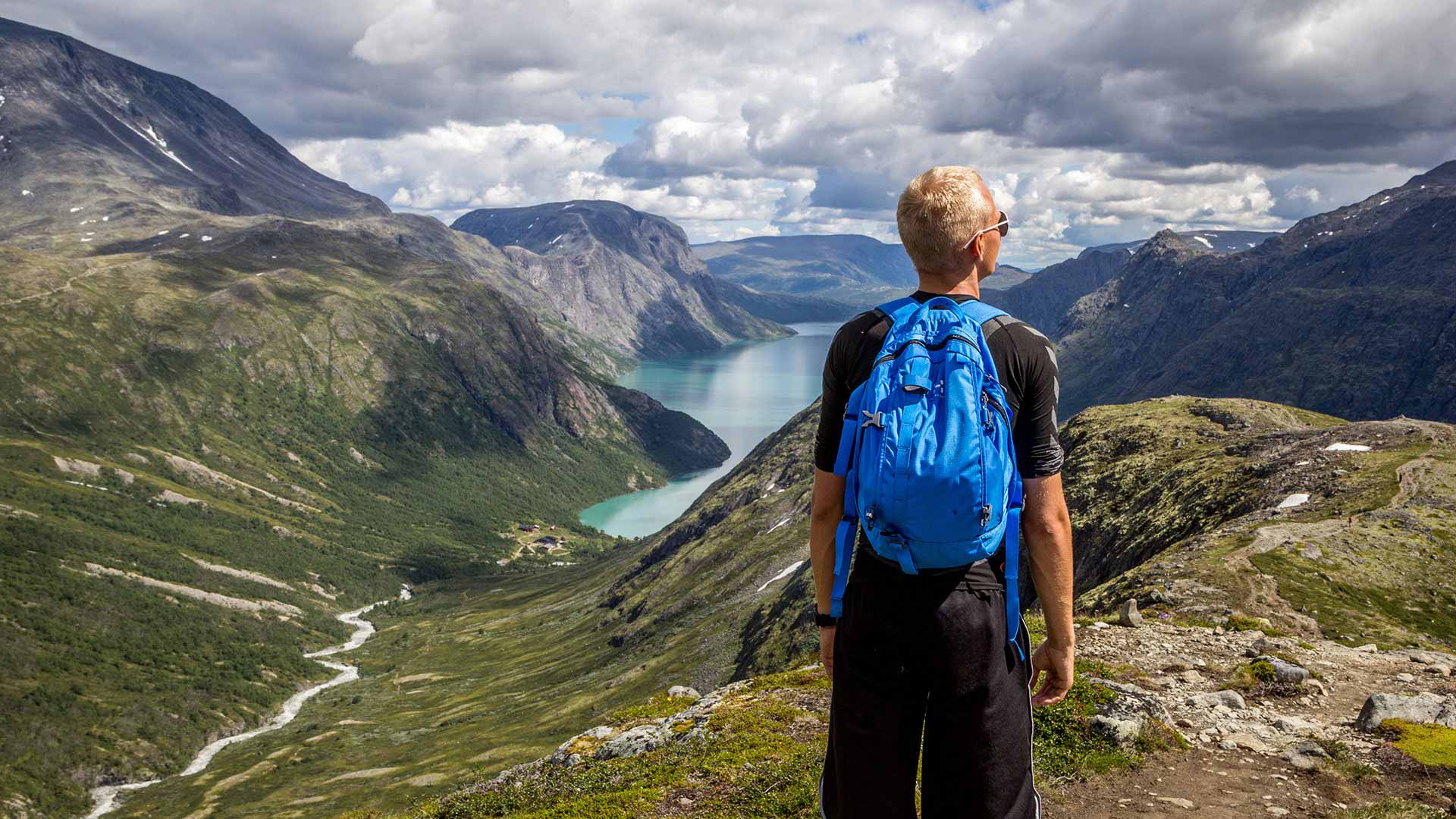
When is the best time to visit Oslo, Norway
Oslo, the formidable capital of Norway, is the ideal Nordic destination for a city break. It’s also a great gateway to discovering more of the country.
To see Oslo at your own pace we recommend visiting in the months just before or after the summer. This way you’ll enjoy all the top attractions with, hopefully, fewer crowds. This time of year is the best of both worlds.
Spend your days visiting the top landmarks, such as Akershus Fortress and the Royal Palace , which may have more availability at that time of year. Later, walk along Aker Brygge , the old waterfront, and enjoy al fresco dining in the bright and cool evening.
Visit Oslo in early winter for another fantastic experience. At this time, you could enjoy the charming Christmas markets and go sightseeing under fairy lights. A trip to Norway’s capital city is a great way to get into the festive spirit.
- Explore Oslo on a city break to Norway
Best time to visit Tromsø, Norway
Tromsø is a great year-round destination if you’re looking for stunning scenery and don’t mind a cooler day out.
Visit Tromsø between October and April to enjoy a winter wonderland and experience a polar night. This phenomenon, where the sun doesn’t rise at all, happens from late November until mid-January.
Another bonus of visiting in winter is the city’s location, straight into the “Northern Lights Belt”. This means you may be able to admire the lights from the city itself.
From Tromsø you could also journey across the northern coast of Norway, to the North Cape and all the way to Kirkenes. This is an amazing winter journey along the Arctic Circle.
In summer, visit Tromsø and the nearby Lofoten islands, to experience the polar opposite (pun intended!). From mid-May until late July, the sun doesn’t set at all. This is called the midnight sun. You could go hiking and enjoy the natural landscape at midnight if you wish.
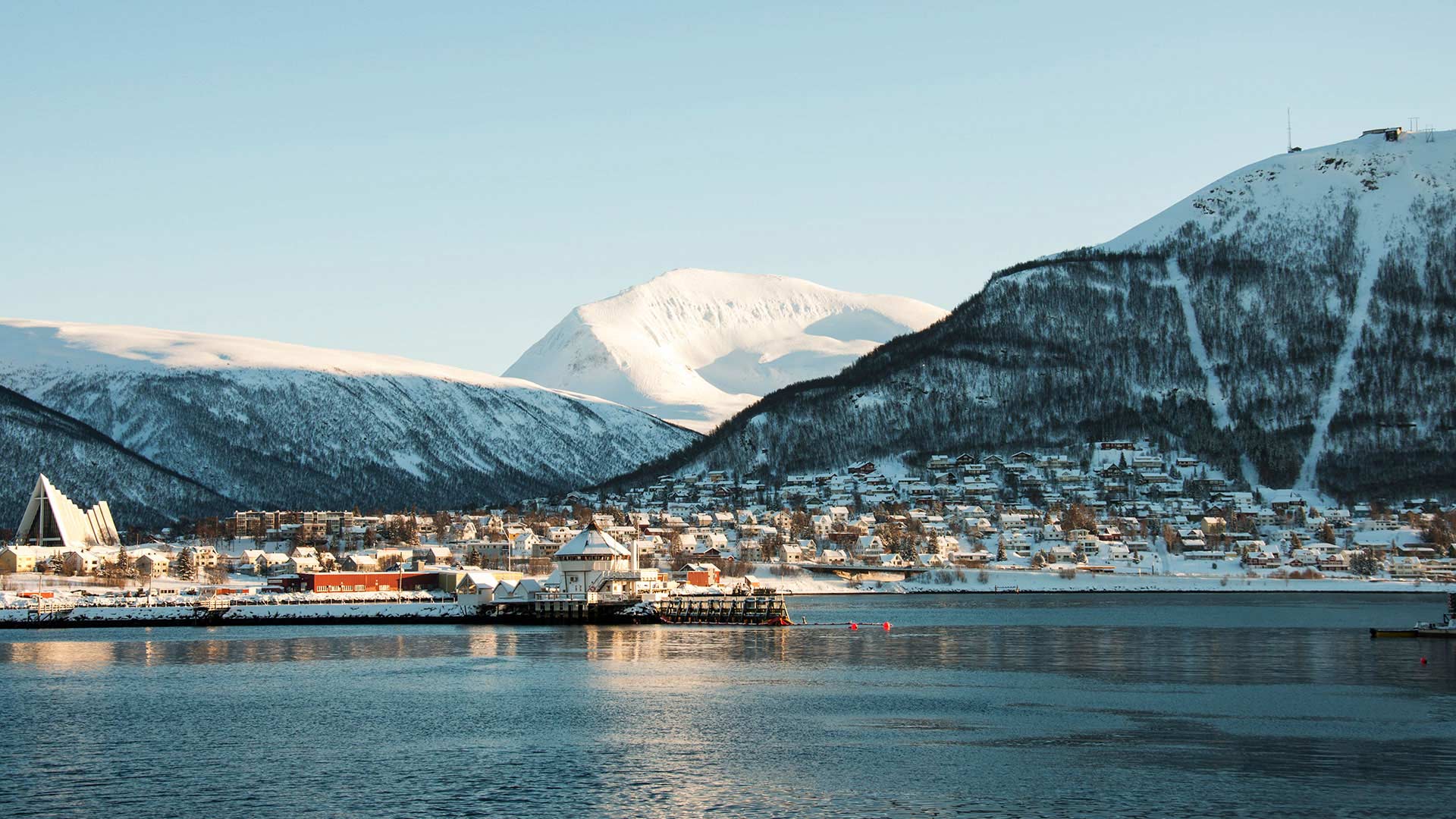
Best time to visit Ålesund, Norway
The charming port town of Ålesund is one of Norway’s most visited cities. This is in part thanks to its beautiful setting along a cluster of islands in the western fjords.
It has also become a popular stop as part of the Norwegian Coastal Voyage. If you’re cruising your way up or down the country, you could add a stopover in Ålesund. And it is definitely worth the visit!
We recommend travelling here in summer to experience it at its best and to enjoy all the activities available. These include angling, sailing, hiking, and kayaking, among others.
From Ålesund, you can cruiseto the nearby Geirangerfjord. You could also spend your days hiking to local viewpoints. Summer is the ideal time to walk up Mount Aksla and enjoy the panoramic views of the archipelago and the peaks of the Sunnmøre Alps.
- Take a look at these Norwegian culture trips
Best time to visit Norway, Sweden and Denmark
Are you looking for a grand tour of Scandinavia? This Northern European region, composed of Sweden and Denmark as well as Norway, is a fantastic destination come winter or summer.
The capital cities, Oslo, Stockholm and Copenhagen, are well connected. That means it’s easy to travel between each of them on one single trip.
In summer, you could drive or take a train and then a cruise to see what makes each city so special. In winter, you’ll be able to sightsee the highlights of all 3 countries with their mild weather and charming winter lights.
Travel just before or after the summer, to enjoy nice weather and plenty of daylight. At popular locations, such as the capitals, Norwegian fjords and top hiking spots, you’ll enjoy having more time and space to yourself.
- Combine a trip to Norway with Sweden and Denmark with these Scandinavian tours
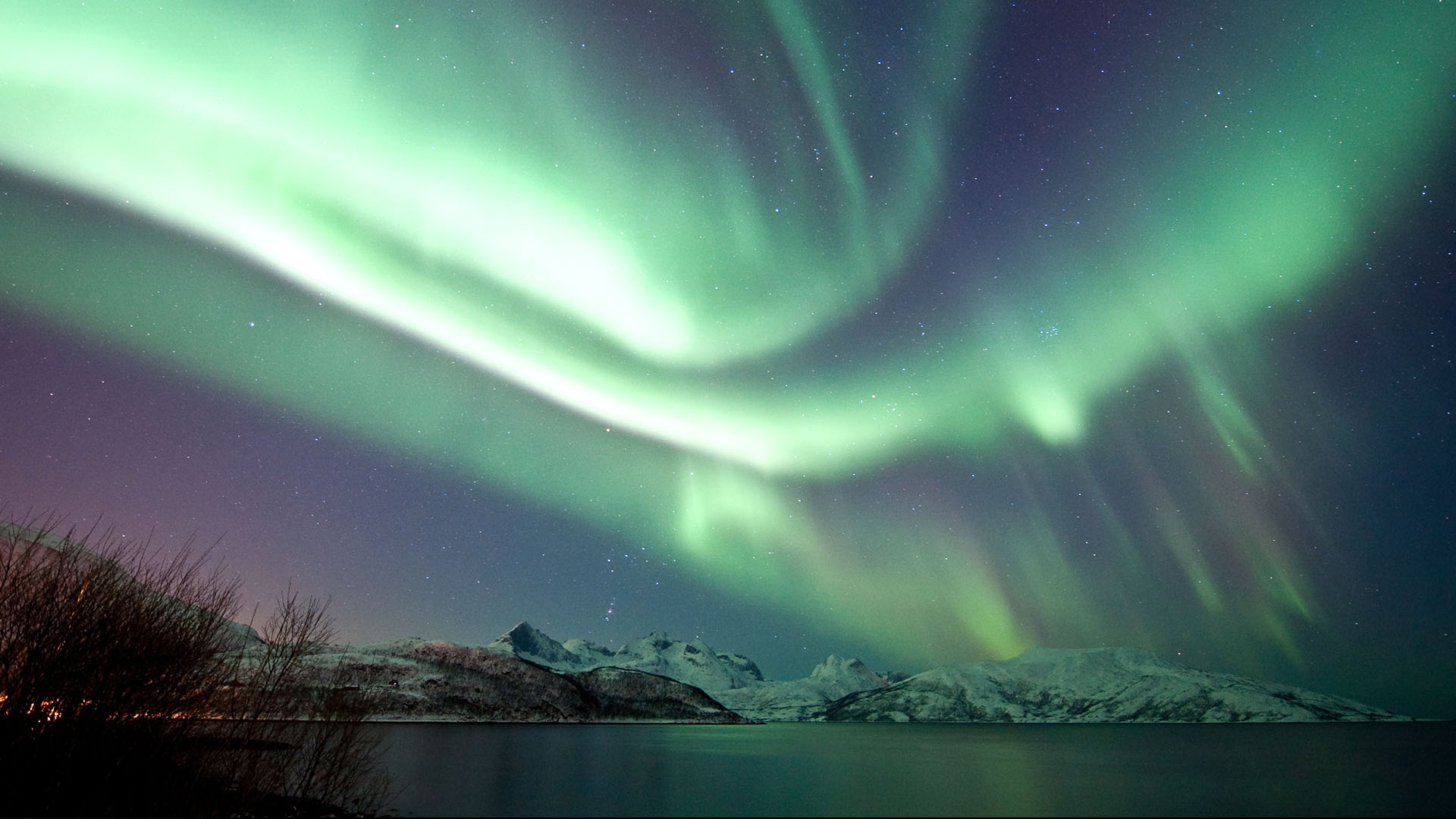
Best time to visit Norway for the northern lights
The northern lights, or aurora borealis, are at their best during the winter season. This means you should visit Norway between October and March.
From late September, the days become shorter making it easier to witness the auroras in the night sky. Indeed, you need darkness, good solar activity, and low light pollution to be able to admire them.
You’ll also want to journey into Northern Norway, all the way into the Arctic Circle, to spot the northern lights. The few prime locations for northern lights spotting in Norway are:
- Tromsø
- North Cape (Nordkapp)
- Book one of these aurora tours to see Norway under a sky lit with northern lights
- Related: Best places and times to see the northern lights in Norway
Best time to visit Norway and Iceland
To combine both these stunning countries into one epic Nordic trip, we recommend visiting in summer.
At this time of year you will benefit from longer days to make the most of your exploration. Take in the highlights of southern Norway like Oslo and the Norwegian fjords before flying to Iceland where you could tour the whole island.
You could even discover more of Scandinavia if you so wish and have the time for a longer trip. Start your tour in Stockholm, passing by Copenhagen before taking on Norway and Iceland.
Sights can be popular at the height of summer, so you could try planning your tour for early or late summer if you want a quieter holiday.
And if you would rather visit during the winter, fear not, it is also possible! In fact, this season has some bonus points of its own too. You’ll be able to admire the glittering frost over amazing Norwegian and Icelandic waterfalls .
This is also the time of year to travel to the Nordics if you want to catch sight of the northern lights. As the darkness sets in, from late September, it becomes easier to see them dancing in the night sky.
- Go on a combined tour of Norway and Iceland
- Or look up Iceland tours to explore the Land of Fire and Ice
Best time of year to visit Bergen, Norway
Bergen is another Norwegian city that can be visited all year long. As it is one of the rainiest cities in Europe, you’ll probably want to travel here in summer for the best weather.
In case of bad weather, fear not, there is plenty to do indoors. You could visit the 900-year-old Bergen Cathedral and one of Norway’s oldest fortresses, Bergenhus Fortress. There are also many museums like the Bryggens Museum, the KODE Art Museum , and the Hanseatic Museum.
But really Bergen is known as the gateway to the fjords and is an excellent outdoor destination. In summer, you could hike up one (or more!) of the seven mountains surrounding the city. You could also participate in fun activities like ziplining across Mount Ulriken.
You also won’t want to miss hiking or taking the Fløibanen funicular to the top of Mount Fløyen . You’ll get some amazing views of the city below and access to some top walking trails.
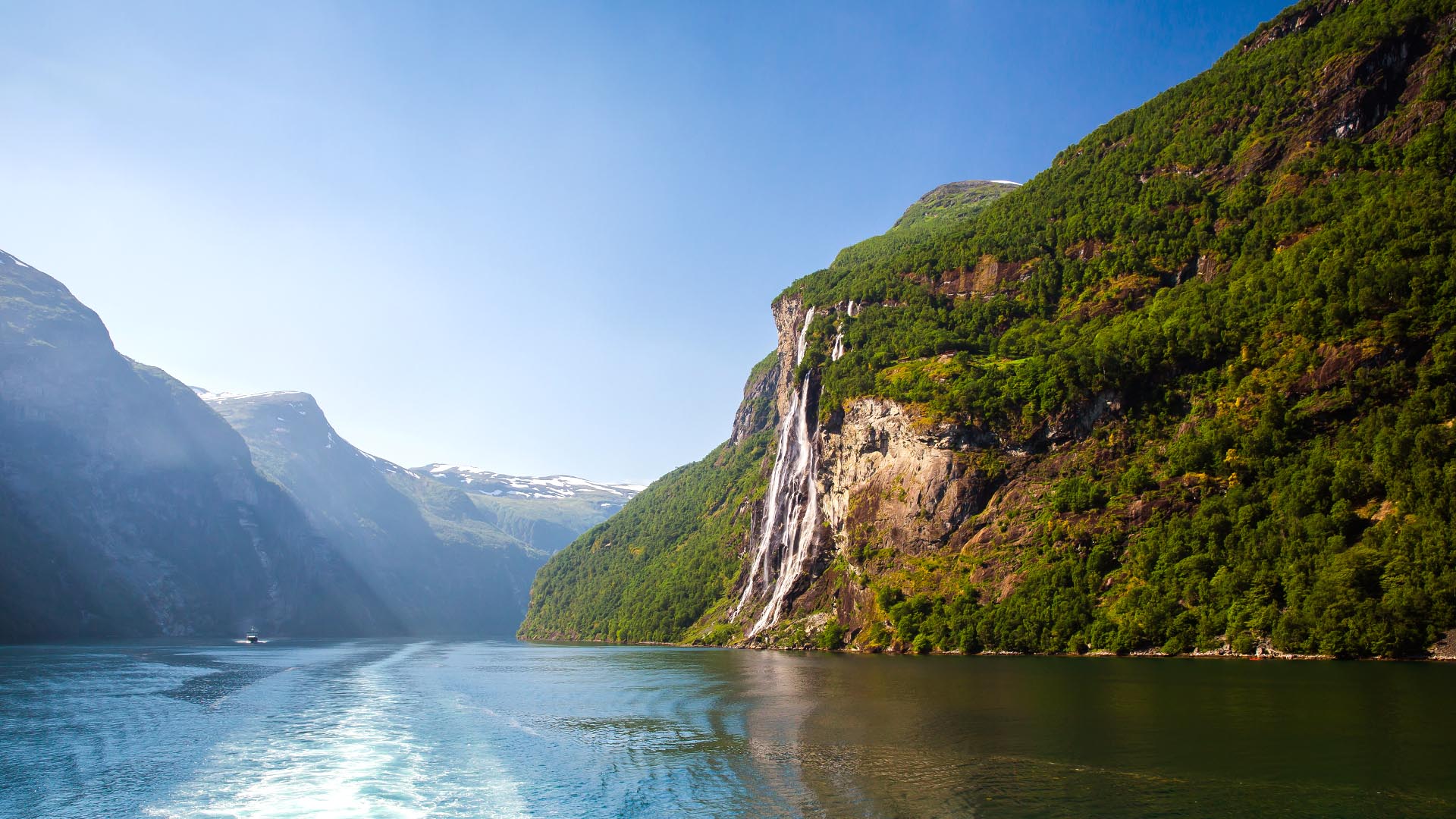
Best time to visit Norway on a cruise
You can cruise Norway’s magnificent and diverse coast any time of the year. That said, we do recommend the summertime for the best experience.
Between May and September, you’ll enjoy long days, ideal for sightseeing. That’s true from the boat or on excursion stops on the mainland. Take photos in the midnight sun and pack more in your day.
In winter, you may enjoy the smaller crowds, but days are much shorter. You may also find the sea is a bit rougher. The one bonus of a winter cruise is the chance to admire the northern lights in the sky above.
A cruise is, in fact, excellent for spotting the auroras as you’ll be away from city light pollution.
- Browse fjords cruise & train tours
- Discover Norway on a Hurtigruten voyage
Best time to go to Norway for hiking
Do you have dreams of standing proudly atop Trolltunga or Pulpit Rock ?
You may have seen the scenic photos of people standing by the cliff edge, with calm fjords below and rocky mountains in the distance.
April until October is the best time to hike to those famous heights. To skip the potential queues for the best Instagram snaps, you should visit during the shoulder season. Late spring and early autumn are quieter times of year that are fantastic to experience the mountains in a bit more peace.
In fact, autumn may be the best time as you’ll find more paths accessible at this time compared to spring. And you’ll be treated to the orange and yellow foliage of the forest.
- Check out these active tours of Norway
Best time to visit Norway for the midnight sun
The midnight sun is an incredible phenomenon whereas the sun does not set below the horizon. It occurs inside the Arctic Circle during summer.
For example, Tromsø and Svolvær , located inside the Arctic Circle, experience the midnight sun between mid-May and late July. You’ll want to visit the northern parts of Norway (or neighbouring Sweden and Finland) at this time to witness it.
Imagine hiking or sitting by the Norwegian Sea admiring the scenery while basking in the light of the sun in the middle of the night.
Just make sure to bring an eye mask to help you sleep!
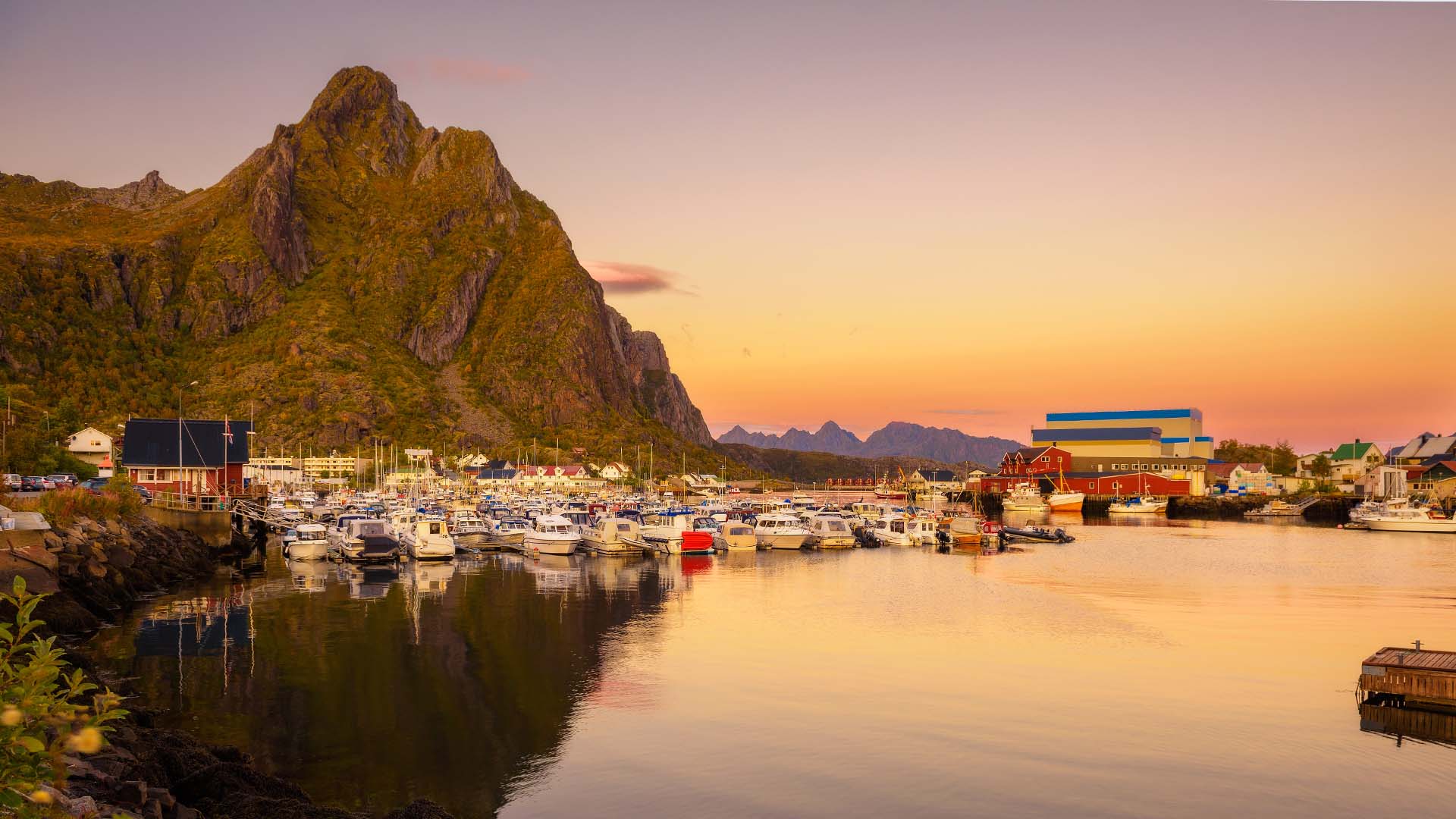
Best time to visit Norway for whale watching
Every year, whales pop up along the Norwegian coast. For this reason, it’s a good location to go on a wildlife cruise to spot them up close.
These gentle giants of the sea are most commonly seen along the Vesterålen coast, just north of Lofoten. Make sure to go there in summertime for your best chances and for more varied sightings.
You could spot sperm whales, but also pilot whales, minke whales, humpback whales, dolphins, and killer whales.
For the best whale-watching experience in Northern Europe, we recommend heading to North Iceland instead. Indeed, Húsavík is considered the capital of whale watching. Trips are available all year long, but summer is the best time to visit.
You might see dolphins, minke whales, humpback whales as well as some sperm whales and maybe the elusive blue whale.
Learn more about whale watching in Iceland .
What to pack for a trip to Norway
The weather in this part of the world can be fickle, but don’t let that stop you from enjoying the best of Norway. Pack well to come ready for rain or sunshine and take advantage of your trip to the fullest.
For all seasons, you should pack layers so you can be flexible depending on the day's temperature. We especially suggest bringing a waterproof jacket and comfortable walking or hiking shoes.
Even in the summer it’s best to have a pair of light gloves, a hat and a scarf handy. Don’t forget your sleeping mask to help with the light nights of summer.
In winter, make sure to pack some warm layers (preferably woollen) along with an insulated jacket.
Finally, don’t forget your camera to snap away at all the spectacular landscapes!
- For more travel inspiration, check out these classic holidays in Norway
Norway is an exceptional destination that can be enjoyed all year long. We hope this post convinced you of that!
When you’re ready to book your dream Norway holiday, take a look at these top Norway packages . And if you’re still not sure or would like local advice, get in touch . Our travel experts can be reached s via live chat, toll-free numbers or email.

Camila grew up between the French Canadian and Chilean cultures, before moving to Scotland in 2012. When she’s not travelling or writing about travels, Camila loves to read, run, and puzzle. Her favourite destinations have been Reykjavík, Copenhagen, Estonia and Cape Town.
Find Camila on LinkedIn .
Getting there
We'd love to give you the same amazing travel experiences as you read about in our blog! To visit the destinations and attractions mentioned in this post - and to discover a few new highlights along the way - check out these recommended Nordic Visitor tours.
HIGHLIGHTS OF NORWAY
- USD ($)
- CAD ($)
- AUD ($)
COMPLETE NORWAY
Related posts, 5 top norway road trips: a local expert’s view.
Blogs , Activity , Scandinavia , Norway , Guides , Things to Do
7 Incredible Things to See and Do in Norway
Best time & place to see northern lights in norway, 10 things to do in norway in winter.
- Best time to visit Norway
Book your individual trip , stress-free with local travel experts
- roughguides.com
- Travel guide
- Itineraries
- Travel Advice
- Accommodation
Plan your tailor-made trip with a local expert
Book securely with money-back guarantee
Travel stress-free with local assistance and 24/7 support
In the popular imagination, Norway is commonly regarded as remote and cold – spectacular but climatically inhospitable. There is some truth in this, of course, but the best time to visit is not, perhaps, as clear-cut a choice as you might imagine with other seasons other than summer offering particular bonuses.
Festivals and holidays in Norway
March/april.
There are, for example, advantages to travelling during the long, dark winters with their reduced everything: daylight, opening times and transport services. If you are equipped and hardy enough to reach the north, seeing the phenomenal northern lights (aurora borealis) is a distinct possibility and later, once the days begin to lighten, the skiing – and for that matter the dog-sledging, ice fishing and snowmobiling – is excellent. There are skiing packages to Norway from abroad, but perhaps more appealing – and certainly less expensive – is the ease with which you can arrange a few days’ skiing wherever you happen to be.
As the year advances, Easter is the time of the colourful Sámi festivals, and mid-May can be absolutely delightful if your visit coincides with the brief Norwegian spring , though this is difficult to gauge. Springtime is particularly beguiling in the fjords, with a thousand cascading waterfalls fed by the melting snow, and wild flowers in abundance everywhere.
Autumn can be exquisite too, with September often bathed in the soft sunshine of an Indian summer, but – especially in the far north – it is frequently cold, often bitterly so, from late September to mid- to late May. Nevertheless, most people travel during the summer season, which can be the best time to visit as bus, ferry and train connections are at their most frequent. This is the time of the midnight sun : the further north you go, the longer the day becomes, until at Nordkapp the sun is continually visible from mid-May to the end of July.
Something worth noting, however, is that the summer season in Norway is relatively short, stretching roughly from the beginning of June to the end of August. Come in September and you’ll find that many tourist offices, museums and other sights have cut back their hours and buses, ferries and trains have already switched to reduced schedules.
Almost every town in Norway has some sort of summer shindig. There are winter celebrations too, though for the most part at least, these are worth attending if you are already in the area rather than meriting a special trip. Festivals fall broadly into two types, one focusing on celebrations of historical or folkloric events, the other based around music, whether jazz, pop or classical.
As you might expect, most tourist-oriented events take place in summer and, as always, national and local tourist offices can supply details of exact dates, which tend to vary from year to year. Below we have listed the more important festivals, some of which are also mentioned in the Guide.
Nordlysfestivalen
(Northern Lights Festival), Tromsø. Late Jan. w nordlysfestivalen.no . This week-long festival of classical and contemporary music coincides with the return of the sun, hence its name.
Birkebeinerrennet
Lillehammer. Late March. w birkebeiner.no . Famous 58km cross-country ski race from Rena to Lillehammer, which celebrates the dramatic events of 1206, when the young prince Håkon Håkonsson was rushed over the mountains to safety. The race follows what is thought to have been the original route.
Easter Festivals
Finnmarksvidda. Easter. w festival.karport.no. Finnmark’s largest festival, held in the town of Karasjok, is something of a Sámi New Year. Sámis prepare by fashioning new gáktis (Sámi dress), polishing their silver and cooking large meals, while during the festival there are snowmobile, reindeer and cross-country-skiing races, lassoing contests and art exhibitions and concerts.
Nasjonaldagen/Grunnlovsdagen
(National Day/Constitution Day). Nationwide. May 17. Many processions and much flag-waving with cheering crowds celebrating the signing of the Norwegian constitution on May 17, 1814.
Festspillene i Bergen
(Bergen International Festival), Bergen. Late May until early June. w fib.no . Much-praised festival of contemporary music that puts a real spring in Bergen’s summer step. Venues across the city. For more information, see The Bergen International Festival.
Norwegian Wood
Oslo. Mid-June. w norwegianwood.no . Three-day, open-air rock festival, arguably Norway’s best, that takes place in Frogner Park; showcases big-name international artists as well as up-and-coming local bands.
Ekstremsportveko
(Extreme Sport Week). Voss. Late June. w ekstremsportveko.com . Every reckless sport imaginable and then some – from paragliding and base jumping through to rafting and bungee jumping.
Midnight Sun Marathon
Tromsø. Late June. w msm.no . Taking advantage of 24hr daylight, this “night-time” run attracts hundreds of athletes. You can opt for shorter distances too.
Kongsberg Jazz Festival
Kongsberg. Four days in early July. w kongsberg-jazzfestival.no . Large-scale jazz festival, one of the country’s biggest, where the emphasis is on Norwegian musicians.
Molde. Mid-July. w moldejazz.no . Held over a six-day period in the middle of the month, this is one of the best festivals of its type, attracting big international names.
Olsokdagene
(St Olav Festival), Stiklestad. Late July. w stiklestad.no . St Olav, Norway’s first Christian king, was killed at the battle of Stiklestad in 1030. Historical pageants and plays honouring him are staged on the King’s feast day (July 29) as well as during the six days before.
Åndalsnes. Late July to early Aug. w raumarock.com . Two-day knees-up showcasing the talents of a wide range of local and international acts from the likes of the Bare Egil Band to the Raga Rockers and the Toy Dolls.
Oslo Jazzfestival
Oslo. Mid-Aug. w oslojazz.no . A six-day event attracting a veritable raft of big international names.
Norwegian International Film Festival
Haugesund. One week in late August. w filmweb.no . Norway’s most prestigious film festival, with a wide selection of the latest releases from across Scandinavia.
Oslo. Ten days in early to mid-Sept. w ultima.no . Much-vaunted festival showcasing the talents of contemporary classical musicians from Scandinavia and beyond. Various venues.
Trondheim. Three and a half weeks in Oct. w uka.no . Prestigious cultural festival, one of Norway’s largest, featuring a battery of international and domestic artists in everything from classical music to rock, theatre to wrestling, juggling and crime writing.
Bergen Internasjonale Filmfestival (BIFF)
Bergen. Mid- to late Oct. w biff.no . Week-long international film festival, one of the best of its type in the country. Various venues across the city centre.
The Rough Guides to Norway and related travel guides
In-depth, easy-to-use travel guides filled with expert advice.

Travel advice for Norway
From travel safety to visa requirements, discover the best tips for traveling to Norway
- Eating and drinking in Norway
- Sports and Outdoor activities in Norway
- Shopping tips for Norway
- How to get to Norway
- Getting around Norway: Transportation Tips
- Travel Tips Norway for planning and on the go
Find even more inspiration here

- Travel Tips
written by Rough Guides Editors
updated 17.05.2021
Ready to travel and discover Norway?
Get support from our local experts for stress-free planning & worry-free travels.
- Where to stay
- Travel advice
The Best Time to Visit Oslo – and When to Avoid it!

Oslo; it’s the land of hygge, beautiful fjords, and thriving nature. It’s a city of many faces. To some, the perfect destination for a romantic weekend getaway; to others, it’s the ideal place to spend an action-packed summer holiday. To me? Well, it’s a bit of both.
Travelers come from all over the world to experience Norway’s Viking capital, but there’s one question on everyone’s mind – when exactly is the best time to visit? The answer, unfortunately, is not so simple. Oslo is a city that experiences all four seasons, and each has its own unique charm.
The good news is that there really is no wrong time to visit Oslo. But, depending on what you’re looking for in a vacation, there are certain times of year that are better than others. To ensure you make the most of your trip, I’ve put together the ultimate seasonal guide to the best (and worst) times to visit Oslo.
Read on to find out when is the best time for you to travel to Norway’s picturesque capital city!
Hint: See if you can figure out what the missing month is!
You might also like: My Top Hotel Recommendations for Bergen
Fall ( Mid-August – October)

Say hello to crisp air, beautiful autumn colors, and long walks along the Aker River. Fall is a wonderful time to visit Oslo if you’re looking to escape the crowds but still enjoy all the city has to offer.
There are significantly fewer tourists than in peak season, which means shorter lines at attractions, cheaper accommodation rates, and a more authentic experience overall. Just be sure to pack a jacket – the weather can be unpredictable!
You might also like: One of My Favorite Hotels in Oslo
The fall season may start in mid-August or early September. The average fall temperature is +12C, but it begins to get even colder as October approaches. There’s no doubt that some of the most beautiful months in Oslo, Norway, are September and October, when the sky often glows in warm hues, the air is crisp, and leaves start to turn yellow.
Best things to do in Oslo during the Fall season:
● Visit the Oslo Opera House – One of Oslo’s most iconic buildings, the Opera House is worth a visit even if you don’t plan on seeing a show. The sloping white exterior is made from Italian marble and granite, and offers incredible views of the surrounding fjord. The Opera House is free to visit, but tours cost 120 kroner (about $15) for each adult and 70 kroner (around $8.50) for children between the ages of 4 and 16. Oslo Passholders get a discounted rate.
● Appreciate Art and Nature at Vigelandsparken ( Frogner Park ) – This is one of the most famous landmarks in Oslo, with thousands of people uploading photos of the sculptures in the park every year. It has more than 900 distinct works of art by Norwegian sculptor Gustav Vigeland, making it the world’s biggest sculpture park. It’s a beautiful spot to spend an afternoon, especially in September when the roses are in full bloom. If you visit in October, you’ll be able to see the leaves changing color.
● Explore the VÍKINGR – This is an immersive exhibit that transports visitors to the Viking Age and immerses them in the daily life of Vikings. See if you can spot the Gjermundbu helmet while you’re there, it’s the best preserved Viking helmet in the world! Check out my previous article to learn more about this incredible exhibition.
● Hiking in Nordmarka – Nordmarka is Oslo’s green lung, and it’s the perfect place to escape the hustle and bustle of the city. There are numerous hiking and biking trails to explore, but you’re also sure to find a quiet spot to relax. The hiking trails in Nordmarka are usually well-marked, but a map is recommended for lengthier stretches.
● Sample Norwegian Comfort Food – Kjøttkaker (meatballs) , Pølse i Lompe (hot dog in a potato tortilla) and Vafler (Norwegian waffles) are just three of the many delicious Norwegian dishes you’ll find in Oslo. Be sure to also try out a shot of Aquavit – Norway’s national spirit!
Winter (December – Mid(end)-March

Photo: Michael Ankes – @w83design
Hibernation mode is real in Oslo during the winter months. From December until March, the city is often blanketed in snow, and temperatures hover around the freezing point. This might not sound appealing, but wintertime in Oslo, Norway, can actually be quite magical.
If you’re lucky enough to visit during the Christmas season, you’ll be treated to festive markets, twinkling lights, and gingerbread galore. However, even if you’re not visiting during December, winter is still a great time to experience Oslo’s unique culture. Ice skating, cross-country skiing, and sledding are just some of the fun activities you can enjoy in the snow.
Best things to do in Oslo during the Winter season:
● Visit the Christmas markets – One of the best things to do in Oslo during winter is to visit the Christmas markets. You’ll find them in various locations around the city. Expect to find handicrafts, gifts, and, of course, plenty of festive food and drink. Check here for 2022-2023 Christmas festival dates!
● Go Skiing, Sledding, or Skating! – Oslo is the perfect place to enjoy winter sports. There are several ski resorts within a day-trip distance, and cross-country skiing is also popular in the Oslo forest. If you’re looking for something a little more low-key, go ice skating at one of the city’s many rinks. Some of the most popular downhill ski resorts near Oslo include Winter Park, Tryvann, and Grefsenkollen ski slope. For cross country skiing start out at Sognsvann or Frognerseteren.
● Embrace Nature – Just because it’s cold outside doesn’t mean you have to stay indoors. One of the best things about Oslo is its proximity to nature. There are several parks and forests within the city limits, so you can easily escape into the wilderness for a day of hiking or cross-country skiing. Nordmarka is a particularly popular spot for outdoor enthusiasts.
● Hibernate With a Good Book – If you’re not a fan of the cold, you can always hibernate indoors with a good book. Oslo has many cozy cafes where you can relax with a cup of coffee and a good read. Deichmanske Bibliotek in Bjørvika is one of my favorite places to curl up with a book. It’s the city’s main public library, and it has an extensive collection of both Norwegian and international literature.
● Rent a Cabin or a Hotel room In the Snowy Oslo Forest – For a truly Norwegian experience, rent a cabin in the Oslo forest. There are many cabins to choose from, and they’re the perfect place to relax after a long day of skiing or hiking. It’s a truly magical experience, and it’s one you won’t soon forget.
From the Voksenasen Hotel , the cross-country ski trails of Oslomarka (the Oslo forest) are directly accessible from just outside the front door.
You might also like: My Top Hotel Recommendations for Bergen
Spring (April – Mid-June)

As the snow begins to melt and the days get longer, Oslo comes alive. The city is filled with blooming flowers, and the trees are starting to turn a lovely shade of green. Spring is the perfect time to visit if you’re looking for a more relaxed atmosphere. Easter is particularly lovely in Oslo, as many flock to the mountains.
The 17th of May is our national day and a big celebration in Oslo. The streets are filled with people in traditional dress, and there are parades and celebrations throughout the city.
If you’re planning a trip to Oslo in the Spring, be sure to pack your walking shoes. This is the perfect time of year to explore the city on foot, and you’ll have plenty of opportunities to take in that fresh flowery air. Spring is also an excellent time for outdoor activities, so don’t hesitate to get out and about. Hiking, biking, and kayaking are all popular activities in Oslo at this time!
Some of the best things to do in Oslo during the springtime include:
● Take a Boat Ride on the Oslofjord – As the weather gets warmer, the Oslofjord becomes a popular spot for boat rides. This is a great way to see some of Oslo’s best scenery; you’ll have the opportunity to see charming landscapes, fantastic city views, and the beautiful hills surrounding it. There are several boat tours to choose from, so you’re sure to find one that’s perfect for you.
Find cruises on the Oslo fjord here .
● Explore the Akershus Fortress – The Akershus Fortress is a must-see for any history buff. This medieval castle is one of Oslo’s most popular tourist attractions, and it’s definitely worth a visit. Be sure to explore the fortress grounds, as there is a lot to see.
● Visit the Munch Museum – The Munch Museum is one of Oslo’s most famous museums. This museum is home to a collection of paintings by Edvard Munch, one of Norway’s most renowned artists. You’ll also find several other artworks on display, and you’re sure to learn something new.
● Hike to Holmenkollen – One of the best things to do in Oslo is to hike to the top of Holmenkollen. This is one of Oslo’s most popular tourist attractions, and it’s definitely worth the effort. The views from the top are absolutely breathtaking, and you’ll have the opportunity to see some of Oslo’s best scenery. Oslo Hiking actively plans scenic trips in the area for whoever wants to join; you can book via their website for 75 euros.
● Kayak on the Oslofjord – As the weather gets warmer, the Oslofjord becomes a popular spot for kayaking. This is a great way to get some exercise, and you’ll have the opportunity to take in some of Oslo’s best scenery. Throughout it, you’ll see the beautiful city sights and wilderness highlights like bays, beaches, and islands. No prior kayaking experience is required.
Find available kayaking tours on the Oslofjord here.
Summer (Mid-June – Mid-August)

My personal favorite; Summertime. In Oslo, late Summer is often referred to as “sensommer.” The days begin to get longer, the weather is warm, and the city is filled with people enjoying the outdoors. This is the perfect time to visit if you’re looking for some fun in the sun. Swimming in the fjord, fishing, park life, staying up late, and enjoying the summer nights should all be on your to-do list.
In the Summer, you can pretty much do everything you can do in the Spring, but better. The weather is nicer, so you can enjoy all of the outdoor activities without worrying about the cold. This is also the busiest time of year for tourism, so be sure to book your hotel room in advance.
Some of the best things to do in Oslo during the summertime include:
● Swim in Oslofjord! – As the weather gets warmer, the beautiful fjord becomes a popular spot for locals and tourists alike. The fjord is incredibly clean and refreshing, and there are plenty of places along the waterfront to just dive right in! This is a great way to cool off, and you’ll have the opportunity to take in some of Oslo’s best scenery. You can find entrances either from the docks, or from some public beaches. There is one at Bygdøy, one next to the Opera House, or jump off the docks right next to the Astrup Fearnley Museum of Contemporary Art!
● Fjord Galore – Oslofjord is unsurprisingly lovely in the Summer. As I mentioned above, this is a great time to swim, but it’s also awesome for fishing, or just simply enjoying the views. On Oslofjord, you can also take a boat ride, kayak, or splish splash while taking in all of the beauty Oslo offers. Many people also enjoy taking the small ferries out to the islands for swimming and a BBQ!
● Visit the Norsk Folkemuseum Open-Air Folk Museum – The Norsk Folkemuseum, located on Bygdøy in Oslo, Norway, has one of the world’s most comprehensive collections of artifacts from all social classes and areas of the country. It also features a large open-air museum with more than 150 reconstructed structures from across Norway.
● Rooftop Concerts at the Opera – During the summertime, the Opera House hosts a number of rooftop concerts, which are a great way to enjoy some live music. Sit back and relax as you let the sweet sounds of the city wash over you.
You might also like: The Best Low Budget Hotel in Oslo
So, Did You Figure it Out?
If you remember correctly, I mentioned that there would be a missing month at the beginning of this post. Did you figure it out?
It’s November! But why November, you ask?
Well, in my opinion, it’s just not a great time to visit Oslo. The weather is starting to get colder, and the days are shorter. There are also fewer things to do, as many of the tourist attractions are closed for the winter. It’s cold, it’s dark, and it’s often raining. So, in my opinion, it’s just not worth it.
With that being said, if you would still love to visit Oslo and don’t want to wait until December or for the weather to get warmer, then you still have the option to embrace yourself in the history of it all. For example, you can check out two fantastic museums in Bygdøy:
● Kon-Tiki Museum : This museum is about the adventures of the famous explorer Thor Heyerdahl. The museum is located in a beautiful setting, and has plenty to see and do!
● Fram Museum : The Fram museum is also located in Bygdøy, and is a great place to visit if you are interested in the history of polar exploration. This museum has a lot to offer, including a huge ice-breaking ship called FRAM, as well as an impressive amount of artifacts!
You can also take a walk to the beautiful Oslo City Hall, where you can see architecture at its finest and take in the views of the city. Read all about Oslo City Hall in my previous blog, “ Visit the Oslo City Hall – A public living room .” Or, enjoy a Sauna by the fjord, which is a great way to relax and bond with your friends or family, and they’re open all year round! Check out my blog post Enjoy Sauna by the Oslo Fjord , to learn more about this remarkable experience.
If you’re looking for the best time to visit Oslo, I would recommend either Summertime or Wintertime. Both have their own unique charm, there is plenty to do, and the seasonal weather is perfect for enjoying all that the city offers.
Thanks for reading! I hope this ultimate seasonal guide has provided you with all the information you need to plan the perfect trip to Oslo. Happy and safe travels!
Traveling to Oslo soon? Check out my YouTube videos for visuals, and tips, and join me on my many adventures!
Your friend in Norway,

Pål of Norway With Pål
Norway native, veteran travel guide, sailor, filmmaker, and writer (you might have seen me in one of Rick Steves’ guidebooks!). I want to help you enjoy Norway the right way — like a local. Learn more about me.
DISCLAIMER: Products on this page may contain affiliate links, and I might make a small sum per purchase. For you this does not affect the product price, but supports me and my work, and makes me able to continue sharing my passion for Norway with you. Read the Disclaimer policy . Thank you, tusen takk!
Join on Patreon
Donate on paypal, watch on youtube.
Maybe we should come and stay for a year!!! but go away in November. LOL Actually your November sounds like our November – just not a fun month. I have to say this is a great article. Kudos to you. Ha en fantastisk Sommer!
haha that sounds like a great plan! I’m glad you enjoyed the article, tusen takk! Hope you’ll have en fantastisk sommer as well
Leave a Comment Cancel Reply
Save my name, email, and website in this browser for the next time I comment.
Join the Newsletter

Get my digital recipe book with seven traditional and tasty Norwegian delights!
Your privacy is important to me. View my Privacy Policy.

Become a part of the virtual viking Norway With Pål family, support, and get exclusive content and perks!
Looking for something?
Norwegian culture, travel in norway, countryside, norway travel tips, norwegian food, norwegian history, norwegian language, norwegian traditions, places to stay, things to do.

Your support helps me to continue sharing my passion for Norway with you. Tusen takk! Thank you!
When is the best time to visit the fjords?
Many would say that spring and summer are the best times to visit the Norwegian fjords, but the autumn and winter months also offer great fjord experiences.
Learn more about the Norwegian fjords :
- The best fjord cruises
- The most famous fjords in Norway
- The best activities to experience the fjords
- How to dress for an all-year adventure in Fjord Norway .
High season: summer is ideal for fjord cruises and outdoor activities
The summer months are the ideal time to visit the Norwegian fjords. The temperature is pleasant, the mountainsides are green and lush, and there are lots of different activities and attractions to choose from. Remember that even in summer, it's a good idea to be prepared for changing weather – especially if you're heading for the mountains. If you want to avoid the crowds, you can explore lesser-known fjord arms in our region . Also, see our overview of the best fjord cruises in Norway !
Spring: nature awakens!
Huge waterfalls cascading down the mountainsides towards the fjord, fruit trees starting to blossom , nature reawakening: spring is a wonderful season to visit the fjords. The weather can be rather unpredictable, so pack for all seasons, but you will get to see the fjords without the crowds, and the prices may be a little lower outside peak season. If you’re lucky, you will experience Fjord Norway bathed in sunshine, with snow on the mountaintops, buds bursting into flower and it will be warm enough to enjoy a fjord cruise on deck. Spring is the season of joy in Fjord Norway !
Autumn: fantastic colour palette and the perfect time for hiking in the mountains
The mountainsides clad in beautiful autumn colours , red, orange and yellow, are a great backdrop for experiences around or on the fjord. The days are getting shorter and the temperatures lower, but the crowds are getting smaller too. There may be a dusting of snow on the mountain peaks, making a great contrast to the autumn colours. Early autumn is perhaps also the best time to hike in the mountains !
The fjords in winter – quiet and dramatic
Winter is not only the time for skiing , but also for experiencing the fjords raw and untamed. Experience a flat calm fjord surrounded by snow-capped mountains on a fjord cruise, or really rough weather – either way, it’s important to dress for the weather. Opening hours are often shorter in winter and some activities are not available, but in many places you can experience fjord cruises all year round, for example to the Nærøyfjord or the Lysefjord .
Read more about the Norwegian fjords!
The best activities to experience the norwegian fjords.
The fjords can be experienced up close or admired from afar. Here are some tips for the very best fjord experience!
The little-known fjords you mustn’t miss
Do you prefer exploring lesser-known gems? We can help you discover the best experiences in the lesser-known fjord arms in Fjord Norway.
Autumn’s adventure – Ålesund, Sunnmøre, Nordfjord and the Northwest
Autumn is the perfect time for a round trip from Ålesund to the Northwest, with a spectacular colour palette in the mountains and fjords, and outdoor activities that don’t involve queuing and waiting around.
A romantic, culinary round trip with stops at historic hotels
Historic hotels, fantastic food and spectacular surroundings in Fjord Norway – the perfect recipe for romance.
Norway in every season
The best experiences, month by month, .css-1ue7yle{transition-property:var(--chakra-transition-property-common);transition-duration:var(--chakra-transition-duration-fast);transition-timing-function:var(--chakra-transition-easing-ease-out);cursor:pointer;-webkit-text-decoration:underline;text-decoration:underline;outline:2px solid transparent;outline-offset:0;color:inherit;background:var(--chakra-colors-transparent);border:var(--chakra-borders-none);padding:0px;height:auto;display:inline;-webkit-align-items:center;-webkit-box-align:center;-ms-flex-align:center;align-items:center;border-radius:var(--chakra-radii-md);font-size:var(--chakra-fontsizes-lg);width:auto;-webkit-padding-start:0px;padding-inline-start:0px;-webkit-padding-end:0px;padding-inline-end:0px;font-weight:inherit;}.css-1ue7yle:hover,.css-1ue7yle[data-hover]{-webkit-text-decoration:none;text-decoration:none;background:var(--chakra-colors-transparent);color:var(--chakra-colors-brand-blue-400);}.css-1ue7yle:hover:disabled,.css-1ue7yle[data-hover]:disabled,.css-1ue7yle:hover[disabled],.css-1ue7yle[data-hover][disabled],.css-1ue7yle:hover[aria-disabled=true],.css-1ue7yle[data-hover][aria-disabled=true],.css-1ue7yle:hover[data-disabled],.css-1ue7yle[data-hover][data-disabled]{background:var(--chakra-colors-transparent);color:var(--chakra-colors-brand-blue-600);}.css-1ue7yle:focus-visible,.css-1ue7yle[data-focus-visible]{box-shadow:var(--chakra-shadows-none);outline:2px solid;outline-color:var(--chakra-colors-brand-black);}[role=group]:hover .css-1ue7yle,[role=group][data-hover] .css-1ue7yle,[data-group]:hover .css-1ue7yle,[data-group][data-hover] .css-1ue7yle,.group:hover .css-1ue7yle,.group[data-hover] .css-1ue7yle{background:var(--chakra-colors-transparent);color:var(--chakra-colors-brand-blue-400);}[role=group]:hover .css-1ue7yle:disabled,[role=group][data-hover] .css-1ue7yle:disabled,[data-group]:hover .css-1ue7yle:disabled,[data-group][data-hover] .css-1ue7yle:disabled,.group:hover .css-1ue7yle:disabled,.group[data-hover] .css-1ue7yle:disabled,[role=group]:hover .css-1ue7yle[disabled],[role=group][data-hover] .css-1ue7yle[disabled],[data-group]:hover .css-1ue7yle[disabled],[data-group][data-hover] .css-1ue7yle[disabled],.group:hover .css-1ue7yle[disabled],.group[data-hover] .css-1ue7yle[disabled],[role=group]:hover .css-1ue7yle[aria-disabled=true],[role=group][data-hover] .css-1ue7yle[aria-disabled=true],[data-group]:hover .css-1ue7yle[aria-disabled=true],[data-group][data-hover] .css-1ue7yle[aria-disabled=true],.group:hover .css-1ue7yle[aria-disabled=true],.group[data-hover] .css-1ue7yle[aria-disabled=true],[role=group]:hover .css-1ue7yle[data-disabled],[role=group][data-hover] .css-1ue7yle[data-disabled],[data-group]:hover .css-1ue7yle[data-disabled],[data-group][data-hover] .css-1ue7yle[data-disabled],.group:hover .css-1ue7yle[data-disabled],.group[data-hover] .css-1ue7yle[data-disabled]{background:var(--chakra-colors-transparent);color:var(--chakra-colors-brand-blue-500);}.chakra-ui-dark .css-1ue7yle:not([data-theme]),[data-theme=dark] .css-1ue7yle:not([data-theme]),.css-1ue7yle[data-theme=dark]{color:var(--chakra-colors-brand-white);}.chakra-ui-dark .css-1ue7yle:not([data-theme]):hover,[data-theme=dark] .css-1ue7yle:not([data-theme]):hover,.css-1ue7yle[data-theme=dark]:hover,.chakra-ui-dark .css-1ue7yle:not([data-theme])[data-hover],[data-theme=dark] .css-1ue7yle:not([data-theme])[data-hover],.css-1ue7yle[data-theme=dark][data-hover]{color:var(--chakra-colors-brand-blue-300);-webkit-text-decoration:underline;text-decoration:underline;}.chakra-ui-dark .css-1ue7yle:not([data-theme]):focus-visible,[data-theme=dark] .css-1ue7yle:not([data-theme]):focus-visible,.css-1ue7yle[data-theme=dark]:focus-visible,.chakra-ui-dark .css-1ue7yle:not([data-theme])[data-focus-visible],[data-theme=dark] .css-1ue7yle:not([data-theme])[data-focus-visible],.css-1ue7yle[data-theme=dark][data-focus-visible]{outline:2px solid;outline-color:var(--chakra-colors-brand-white);box-shadow:var(--chakra-shadows-none);}.css-1ue7yle .chakra-button__icon{-webkit-margin-start:var(--chakra-space-2xs);margin-inline-start:var(--chakra-space-2xs);line-height:1.6;}.css-1ue7yle .chakra-left-button__icon{-webkit-margin-end:var(--chakra-space-2xs);margin-inline-end:var(--chakra-space-2xs);line-height:1.6;} spring i summer i autumn i winter, welcome back sun.
As winter snows melt away, Norway bursts to life with vibrant colours, the scent of cherry blossoms, surging waterfalls, and sun-hungry Norwegians enjoying the outdoors. Embark on picturesque hikes through lush forests, explore quaint villages, and see newborn lambs in the meadows. Norway's springtime beauty promises the rejuvenation and renewal we all need after a long winter. Book your getaway now and get ready to be enchanted by the wonders of spring in Norway!
Hot – hotter – hottest!
Norwegian summer is here – get ready for a magical season! Experience lazy days exploring the coast by boat and cosy small towns in the south, stunning UNESCO-listed fjords and majestic mountains in Fjord Norway and long summer evenings under the midnight sun in Northern Norway. Whether you are seeking thrilling outdoor adventures, peaceful moments in nature, or culinary experiences, Norway's summer promises an unforgettable escape.
Read more about the summer season .
Golden hues and crisp air
Witness the amazing transformation of nature into brilliant red, orange, and yellow colours. Sample the culinary delights of the season, vibrant city life, and hiking in the mountains with the best views. Traveling off-season brings plenty of benefits: more space, fewer queues, and a more personal welcome!
Read more about autumn in Norway .
Step into a winter wonderland
Embrace the beauty of winter in Norway. Whether you're seeking adventure, relaxation, or a getaway in breathtaking nature, Norway in winter promises memories that will warm your heart for years to come. Book your winter adventure to Norway now and create memories that will last a lifetime!
Read more about the winter season .
Discover more
Take advantage of top offers.
See our selection of trusted companies that work hard to make you happy all through your trip.
Your recently viewed pages
- Norway Tours
- Norway Travel Guide
- When to Visit Norway
Best Time To Visit Norway
- Jan Avg Daily: 1 ° C Avg Nightly: -7 ° C
- Feb Avg Daily: 2 ° C Avg Nightly: -7 ° C
- Mar Avg Daily: 6 ° C Avg Nightly: -3 ° C
- Apr Avg Daily: 9 ° C Avg Nightly: 1 ° C
- May Avg Daily: 16 ° C Avg Nightly: 7 ° C
- Jun Avg Daily: 20 ° C Avg Nightly: 11 ° C
- Jul Avg Daily: 22 ° C Avg Nightly: 13 ° C
- Aug Avg Daily: 20 ° C Avg Nightly: 12 ° C
- Sep Avg Daily: 16 ° C Avg Nightly: 7 ° C
- Oct Avg Daily: 10 ° C Avg Nightly: 4 ° C
- Nov Avg Daily: 4 ° C Avg Nightly: -1 ° C
- Dec Avg Daily: -1 ° C Avg Nightly: -5 ° C
- 21.70K views
- ~ mins read
The best time to visit Norway is during the shoulder seasons, in spring (between May and June), and fall (between September and October), when the weather is amazing and there aren’t that many tourists. The summer high season between June and August is also fabulous, with lots of events, warm weather, and long days. However, the Northern Lights are best seen at higher altitudes and are mostly visible during the colder months, between September and March. A trip to Norway has much to offer tourists — from the architectural marvels in Oslo to the famous fjords, and the stunning northern lights that make the entire country seem like an otherworldly wonderland. Many of Norway’s charms are off the more minor roadways and into the quaint little towns.
Find out in this article what the weather in Norway is like, and when the best time to visit is.
- From Australia
Quick Facts
Seasonal overview.
Norway follows a four-season weather pattern with a clear, distinct spring, summer, fall, and winter. But which season would you prefer and why? Read on, and find out when to visit Norway.
Spring in Norway – April to June

April to June is the spring season, and the weather in Norway turns more sunny and warm as winter fades away. Wildflowers start blossoming across the country and snow melt means waterfalls begin to swell in most parts of the country, leading to picturesque scenes and excellent views. However, in several places—especially in higher altitudes—the snow will have just thawed, so beware of sludge beneath your feet!
Highlights:
- Norwegians enthusiastically celebrate the arrival of spring with the National Day on May 17, marked by festive dressing up and merriment.
- The pleasant weather in spring encourages outdoor activities, including music festivals such as the Midnight Sun Marathon in Tromso and the Norwegian Wood Music Festival on a trip to Oslo (both held in June).
- Spring is an ideal season to visit the stunning fjords of Norway, with the melting snow ensuring that the waterfalls are at their most abundant and breathtaking.
Travel tips:
- If you plan to be in Norway for May 17th, Norway's National Day, book your accommodation well in advance, as it's a popular and festive time.
- Consider staying in accommodations with fjord views to make the most of the stunning scenery during spring.
- Plan fjord exploration trips during spring when the waterfalls are in full flow for breathtaking vistas. Opt for fjord cruises and hikes for the best experiences.
In-depth month-wise guides: Norway in April Norway in June
Summer in Norway – July to August

June to August is the peak season and summer time. This is usually considered one of the best times to visit Norway and is known for great weather, lots of events, and long days. Train, bus, ferry, and flight connections will be most frequent, and this is the best time for you to spot the famous midnight sun, which is more prominent the further north you head. There is a chance you might spot some rain during this period, so be prepared with an umbrella, especially if you’re traveling to Northern Norway or Trondelag! This is the busiest period in the calendar, so book your hotel rooms in advance.
- Immerse yourself in Norwegian culture with events like the Arts Festival in Harstad and the Midtsommarfest in Tysvær.
- Summer is the perfect time to explore Norway’s beautiful beaches. You might even be able to swim.
- Except for Northern Norway, summer is the prime season for hiking and biking due to warm weather and snow-free trails.
- Don't miss the Riddu Riddu festival held every July, celebrating the rich Sami culture in Norway.
- Try a whale safari!
- Venture to the natural wildernesses inland and spend a summer night in the wilds for a unique perspective.
- Summer in Norway brings ripe blueberries, make sure you try some fresh ones! making it a perfect time to savor these delicious berries while basking in the midnight sun.
- For the best midnight sun experience, the most well-known places are Helgeland, Bodø, Salten, Lofoten, and Vesterålen.
- Camping is common for the Riddu Riddu festival. Bring your tent or rent on locally!
In-depth month-wise guides: Norway in July Norway in August Summer in Norway
Fall in Norway – September to October

The fall colors take hold of the country this season, and the glorious hues look stunning scattered across the already picturesque Norwegian vistas. The forests and fjords come alive with shades of red, orange, and gold, creating a breathtaking spectacle. As summer ebbs, the weather turns cooler, but snowfall is still unlikely. If you want to chase the warmth during these months, head to the coastal areas.
- Summer is the prime time for berry and mushroom picking in the mountainous regions, offering abundant harvest opportunities.
- Visit fjord towns like Bergen in autumn, when the colors are gorgeous, and art, music, and cultural events often take place.
- On particularly cool or rainy fall days, check out the spectacular museums of Oslo like the MUNCH museum and the National Museum, and dine on elevated local dishes in the culinary scene.
- Don't miss the chance to witness the stunning autumn foliage. A hike into various forests in Norway such as Bøkeskogen (the Beech Tree Forest), during this season, promises unforgettable views of nature's vibrant colors.
- Head to northern Norway if you hope to catch the Northern Lights in autumn.
- Be ready for occasional rain during the rainy season by packing waterproof gear, ensuring your trekking plans aren't completely thwarted.
- The frequency of transport will reduce, as the number of tourists goes down, so plan accordingly.
- Accommodation and travel tickets will be sufficiently cheaper during these months so make the most of it.
- Fall offers incredible photography opportunities with the vibrant foliage and Northern Lights. Don't forget your camera!
In-depth month-wise guides: Norway in September Norway in October
Winter in Norway – November to March

Winters in Norway can get rather harsh but if you don’t like crowds you will appreciate the lack of tourists! The days can be quite shorter, meaning darkness stays late and comes early, providing good reason to cozy up by the fire or savor rich winter foods. By December, the snowfall will likely start, with higher altitudes seeing more, areas like Tromso and Oslo will look stunning in snow, especially around Christmas time when all the decorations go up!
- Winter is the prime Northern Lights season in Northern Norway. Tromsø and the Lofoten Islands are popular destinations for witnessing this natural spectacle.
- Experience cultural festivals like the Tromsø International Film Festival (TIFF) and the Sámi National Day celebrations, offering insights into Norway's rich heritage.
- Stay in a one-of-a-kind ice hotel like the Sorrisniva Igloo Hotel in Alta. These structures are beautifully carved from ice and offer a surreal overnight experience.
- Norway offers world-class skiing and snowboarding opportunities. Destinations like Geilo, Trysil, and Hemsedal are renowned for their ski resorts and winter sports facilities.
- Dress warmly with thermal layers, insulated jackets, waterproof boots, and cold-weather accessories to stay comfortable in freezing temperatures.
- When renting a car, ensure it's equipped for winter driving with snow tires and familiarity with driving in snowy conditions.
- Opt for the experience of rich Norwegian cuisines like hearty stews, cured meat, and mulled wine, and make the most of the winter season.
In-depth month-wise guides: Norway in November Norway in December Norway in January Norway in February Norway in March
Norway's vast and breathtaking landscapes, including the Northern Lights, fjords, glaciers, and archipelagos, captivate visitors with their sheer size and splendor. The country's natural beauty creates a sense of wonder as if you've stepped into a mystical realm, perhaps falling under the enchanting spell of the Fata Morgana.
When planning a trip to Norway, the weather should be a crucial consideration. However, the best time to visit largely depends on your preferred activities. Summer offers long days and excellent hiking opportunities, while winter transforms the country into a snowy sports paradise. Create your ideal trip to Norway with the help of our travel experts and create a customised trip to Norway.
Related Articles
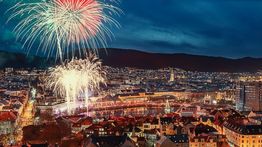
Norway in January: Winter and Northern Lights
If you are used to the first month of the yea... read more
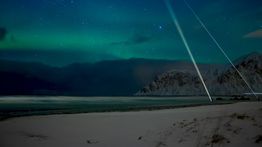
Norway in February: Weather Tips and Low-Season Rates
At first glance, Norway might not seem like a... read more
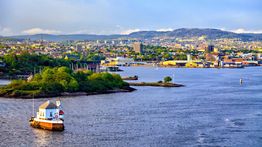
Norway in March: Weather and Travel Tips
A harbinger of spring, the month of March off... read more
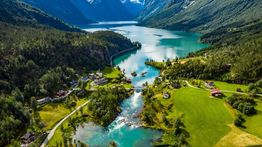
Norway in April: The Start of Spring Season
Spring dawns in Norway in April and the whole... read more
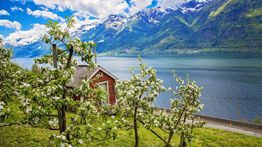
Norway in June: Tons of Fun Under the Midnight Sun
With longer daylight hours, milder temperatur... read more
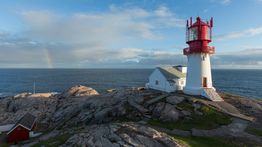
Norway in July: A Treasure Trove of Summer Adventures Await
With the warmest temperatures and longest day... read more
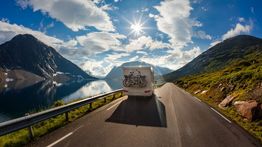
Norway in August: Summer’s Last Hurrah
August is the tail end of summer in Norway. T... read more

Norway in September: Weather, Tips and More
A trip to Norway in September sees long dayli... read more
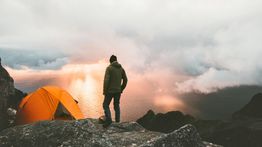
Norway in October: Weather, Tips and More
Norway’s vibrant autumnal hues bloom to their... read more
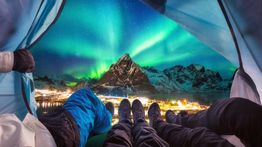
Norway in November: All You Need to Know
A trip to Norway in November is a mixed bag. ... read more
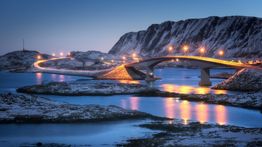
Norway in December: Weather & Northern Lights
Norway is a winter wonderland full of delight... read more
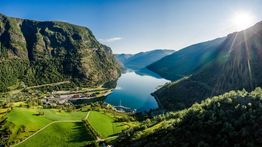
Summer in Norway: Warm Weather, Cool Adventures
Norway is a stunning destination to visit dur... read more
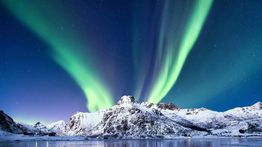
Norway in Winter: Experience Cold Weather Charms
Norway transforms into a winter wonderland be... read more
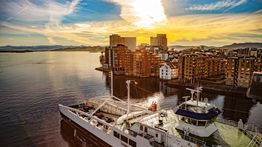
Norway in May: Midnight Sun and Warm Weather
If you want a taste of the real Norway, May i... read more
Related Categories
- How Long To Stay In Norway
- What To Do In Norway
- When To Visit Norway
- Where To Go In Norway

Popular Destinations
- Europe Tours
- Everest Base Camp Trek
- Italy Tours
- Spain Tours
- Argentina Tours
- Canada Tours
- Sri Lanka Tours
- Chile Tours
- Antarctica Tours

Check out the best seasons for the Nordic countries
Visit Rovaniemi / Rovaniemi Tourism & Marketing Ltd
When to visit the Nordic countries
This guide gives you the best tips when visiting Scandinavia and the Nordic countries and the best places to see.
There's plenty to discover and explore in the Nordic countries, which are stunning year-round.
Experience unique Nordic nature, beautiful sandy beaches , Norwegian fjords and waterfalls, the Northern Lights , modern cities and much more.
Best time for the Nordic countries
Scandinavia and all Nordic countries have four seasons, where you can participate in many activities, tours, and attractions. Outdoor activities are part of the Nordic lifestyle, and you find many different kinds of outdoor things in the Nordics.
- Nordic popular outdoor activities
- Scandinavia Travel Guide
Spring is lovely with blooming flowers, and Summer with long sunny days where you can swim and visit one of the many music festivals. Fall is also great for hiking trips, and in Winter, you can visit some of the many ski resorts, enjoy indoor “hygge” by the fire, and visit the Christmas markets in Copenhagen.
But the best time to visit depends on what you wish to see and do. In summer, the weather is warmer and more pleasant, and daylight lasts more than 16 hours.
Summer in the Nordic countries
Summer, June, July and August are great times to visit the Nordic countries and the high season in the Nordics. You have long days; in summer, the Sun comes up around 4:00 and sets around 22:30 in most Scandinavia.
In the Arctic region, the sun is above the horizon in the summer months, and you can experience the Midnight Sun where the sun never goes below the horizon.
For travellers, June, July, and August are the most popular months for visiting Nordic countries. Many tourists choose these months because of the pleasant temperatures and the sunny weather.
If you prefer milder weather and less crowded tourist attractions, May or September's shoulder seasons present an appealing alternative. You can get lucky to have good weather for several days in those months.
In spring, summer and fall, you can enjoy activities such as:
- City breaks in the main Nordic cities
- Visit the many Nordic castles and palaces
- Discover the fantastic fjords in Norway
- Visit one of the many Nordic attractions for kids
- Swimming at one of the most beautiful beaches in Denmark
See also: Weather in Scandinavia
When to visit Denmark
You can visit Denmark in any four seasons, but many tourists visit the country in the spring and the summer.
Especially in May, when the days are getting longer, the weather is getting warmer, and there are lots of outdoor activities to do, and all you'll need is a light jacket. If June isn't an option, July, August and September are good alternatives because the weather is still good and not so rainy.
There are lots of outdoor events in Denmark during those months. However, the summer months of July and August are also the time of year in Denmark when you experience the most tourist crowds. The country is also perfect for a biking holiday because of the temperatures and the infrastructure. If you want to go to Denmark to avoid the high travel season, May and September can be viable alternatives when to go to Denmark, and the weather is still mild enough for outdoor activities. Before May and after September is the lower travel time of the year in Denmark, and prices of flights to Denmark and local hotels are lower.
- Highlights in Denmark
When to Visit Sweden
Summer runs from June to August, and Spring from March to May.
Travelling to Sweden in June is an excellent idea to experience outdoor events like Midsummer's Eve and other activities. The weather is quite warm, and you have long hours of daylight. In the northern part of the Nordic region, you find a unique natural phenomenon called the Midnight Sun, and here the sun is not going down under the horizon.
Also, May and July are great alternatives. It can be rainy in May and June, but July is warmer and drier. July and August can also be slightly more expensive than the earlier summer months, so June is still your best bet for when to go to Sweden.
It is highly recommended in late August and September if you're a budget traveller trying to decide when to go to Sweden. The flights to Sweden will be cheaper than during the high season, along with local hotel prices, and during that time, the weather in Sweden is still mild enough for outdoor attractions, although some sights begin to close during September.
Sweden is a great country to visit in the winter if you want to go skiing and discover the Northern Lights in Swedish Lapland. See more:
- Top highlights in Sweden
When to visit Norway
Most travellers go to Norway in Spring and Summer, especially in June, July and August. That's the time of the Midnight Sun, so you'll get very long days in southern Norway or even sunshine around the clock in northern Norway , and there are many things to do and places to go in Norway. June and July are also the time for Norway's highest tourism levels, so while all sights and attractions will be open, you will see some tourist crowds. So when should you go to Norway to avoid the high travel season? May and September are lovely alternatives to go to Norway and get lower rates - and the weather in Norway will still be mild enough for outdoor activities and sightseeing. For travellers, the cheapest month in Norway is October. The summer is over, but the ski season hasn't started yet. October can be cold, and many outdoor attractions have begun to close.
Highlights in Norway
When to visit finland.
May through September offer the mildest weather and the highest travel volume. Especially early summer - May and June are pleasant in Finland . When you pick when to go to Finland, remember that the Finnish summer holidays are in July, which equals higher prices. After that, August and September have more annual rainfall. In June, the weather in Finland will be warm, outdoor activities and events are commonplace, and you can witness the Midnight Sun. At the other end of the spectrum are the winter travellers. Finland, in the winter months, offers many kinds of activities. If you want to see the Northern Lights, aim for December. It's a pricey time of year, but Christmas in Finland, with all the snow and the local events, is a great experience. Don't forget to visit Rovaniemi , the Santa Claus Village in Lapland . As a winter sports enthusiast, when to go to Finland is not an issue. You will find many flexible choices between January and March, Finland's coldest months. See more
- Highlights in Finland
When to visit Iceland
The warmest months, June, July, and August, are the best to visit Iceland.
The Spring has plenty of unpredictable weather, but spring can be a delightful time to visit Iceland. The country begins to bloom literally, and the emergence of the long winter and brighter, longer days puts locals in an upbeat mood.
Summer in Iceland is peak season. Use Reykjavík as the base for explorations or stay in one of many locations around the countryside. Summer is delightful; the sun barely sets, and enjoy the natural phenomenon of the Midnigh t Sun. You'll have the slightest chance of rain during June, and the weather in Iceland stays mild until late August. Come mid-September, though, almost all of the summer activities will be closed until May of the following year. The colder part of the year is also when flight prices to Iceland fall drastically, and suddenly, the local hotels cut their prices by more than half. Budget travellers wondering when to go to Iceland should aim for February or March. They have more daylight than in the earlier winter months. See more:
- Highlights in Iceland
When to visit Greenland
Greenland falls within the Arctic Circle . In winter, in the Polar darkness, the people there don’t see the sun for three months. This necessarily means no light reaches there in the Arctic region in Greenland . No one enjoys as much sunlight during the summer as Greenland. Even though the summer is precisely hot, per se, it’s enough to give you a good tan on your face. Greenland shares its season cycle with the Arctic.
There are two weather cycles in Greenland, and summer and winter are so different that your experience will vary greatly, in combination with the season when you visit Greenland. The travel season is spread over the summer, winter, and spring. Another important thing is to consider the purposes of your visit. Do you go to Greenland to see the Northern Lights and want to try dog-sledging - October-March is the time to go there.
The high season is between May and September because that’s when the winter ice starts to melt, which gives many exciting options like skiing, boating rides, trips to see the glacier, and some extraordinary polar wildlife like whale watching and experiencing the midnight sun . The amazing Midnight Sun can be explored during the Arctic summertime. Being part of a 24-hour Midnight Sun experience here in the most beautiful natural surroundings in the world is unforgettable.
- Highlights in Greenland
Visit the most beautiful natural sites in the Nordic countries

Top Nordic Experiences
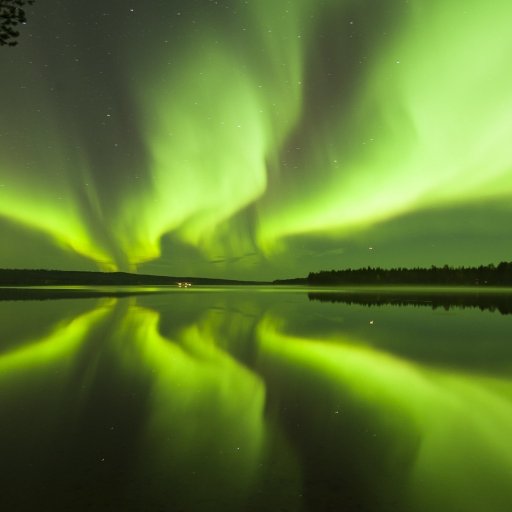
The Ultimate Northern Light Guide
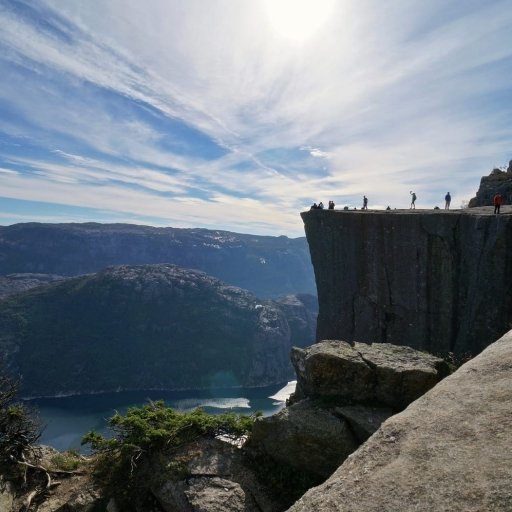
Norway Fjords
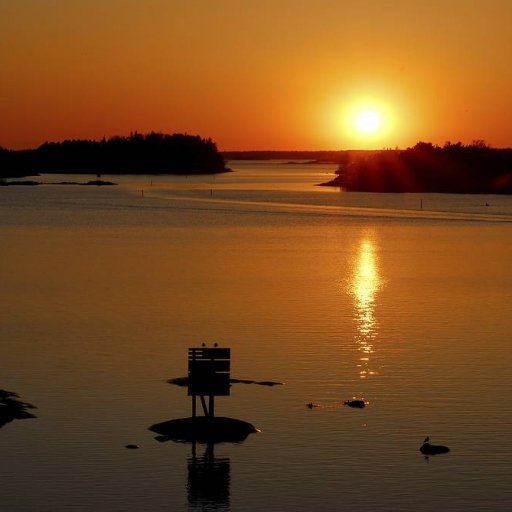
Midnight Sun in the Nordic Countries
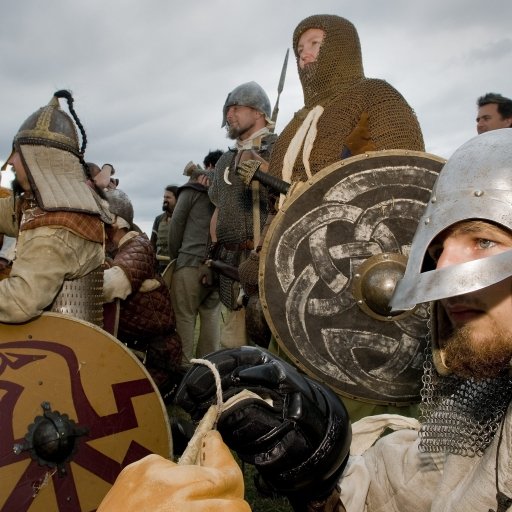
Scandinavian Vikings
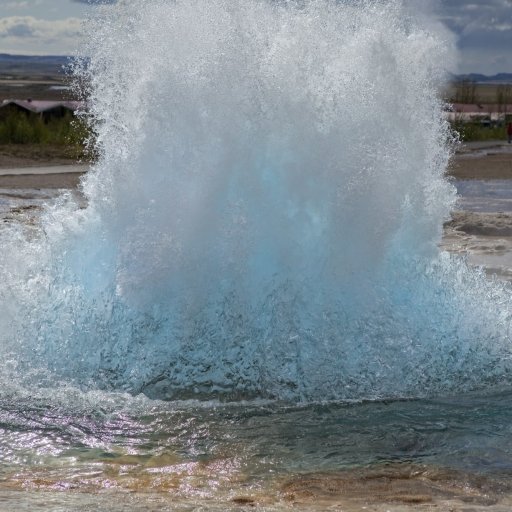
Geysir & Strokkur

New Nordic Cuisine
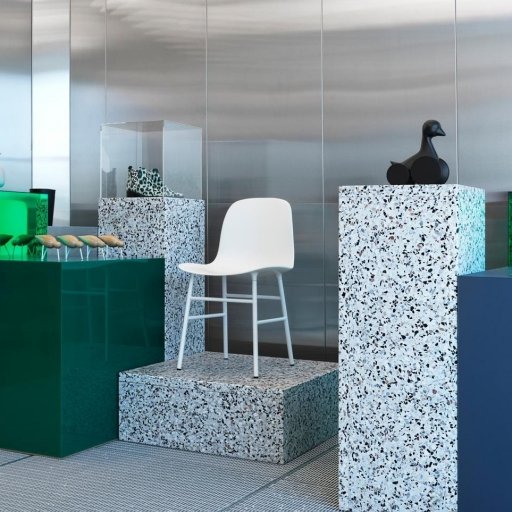
Nordic Design
Popular nordic activities.
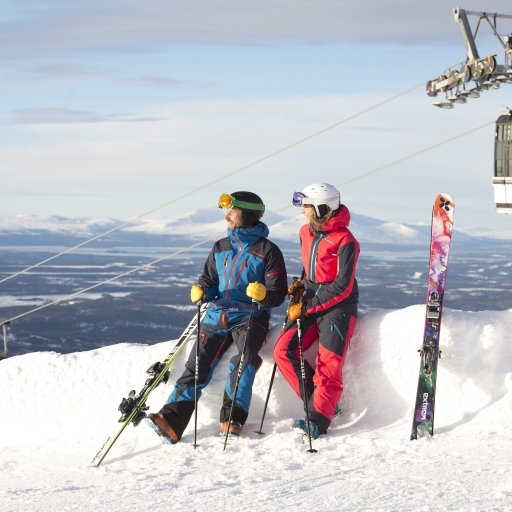
Popular Outdoor Activities in Sweden
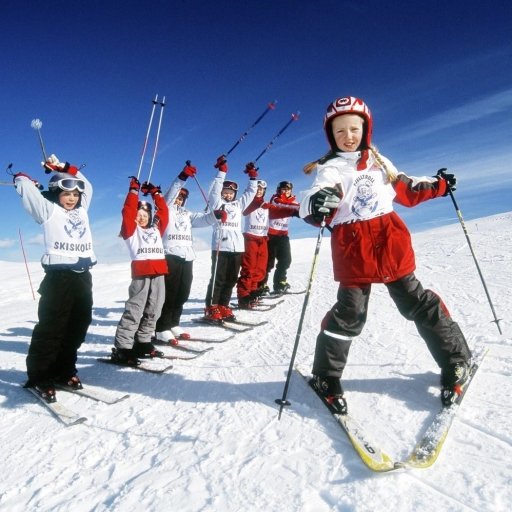
Popular Outdoor Activities in Norway
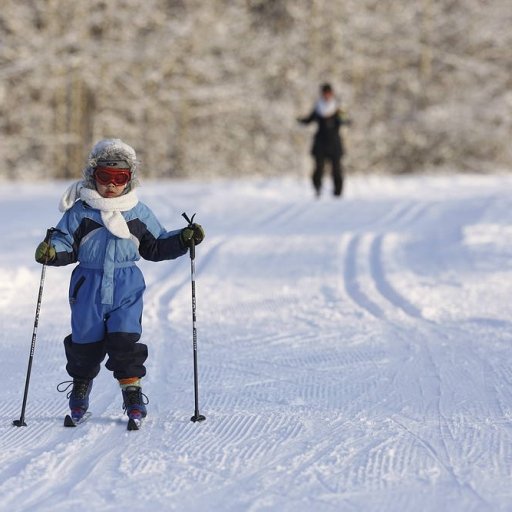
Popular Outdoor Activities in Finland
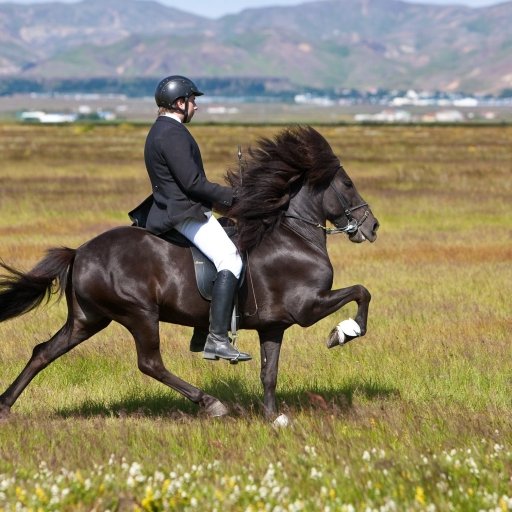
Popular Outdoor Activities in Iceland
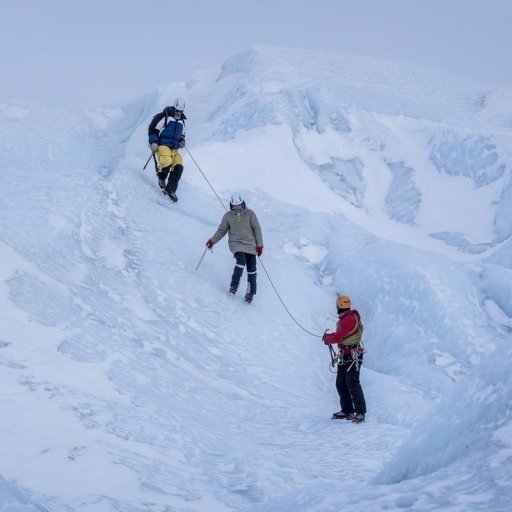
Outdoor Activities in Greenland
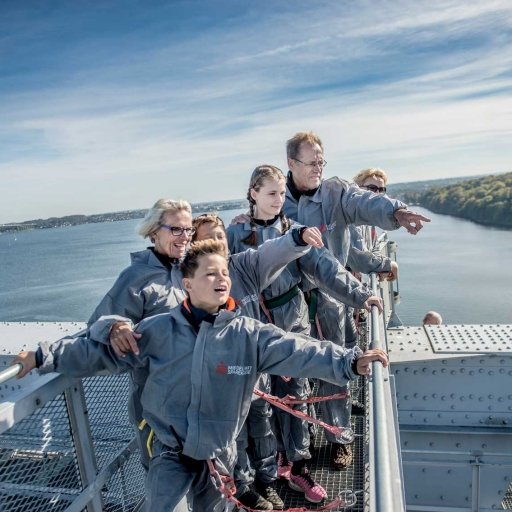
Outdoor Activities in Denmark
Nordic travel guide.
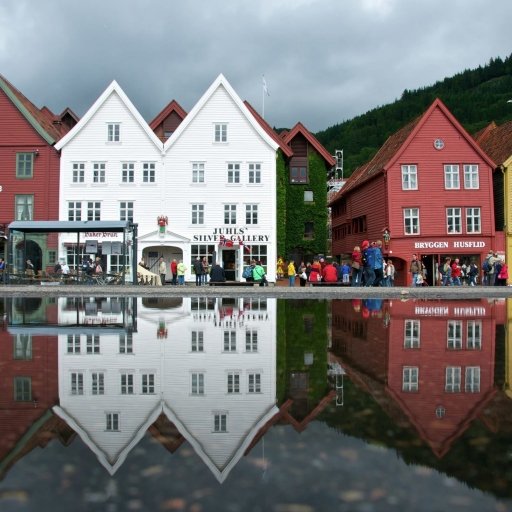
Reasons to Visit Norway
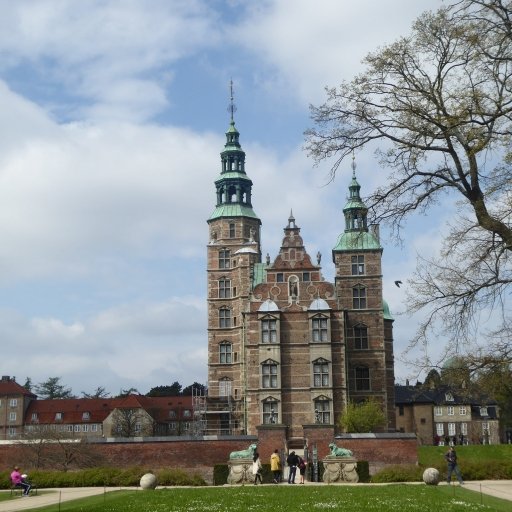
12 Reasons to Visit Denmark
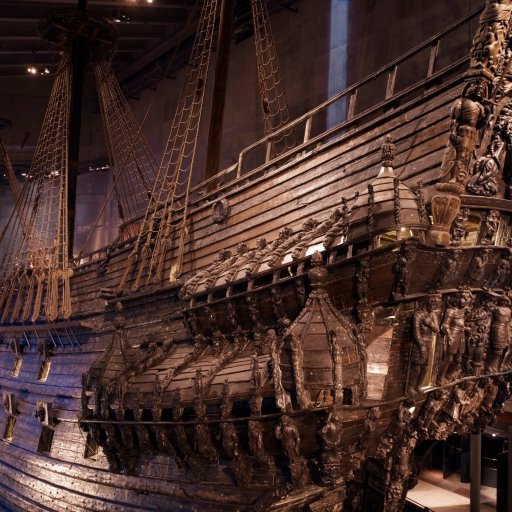
Reasons to Visit Sweden
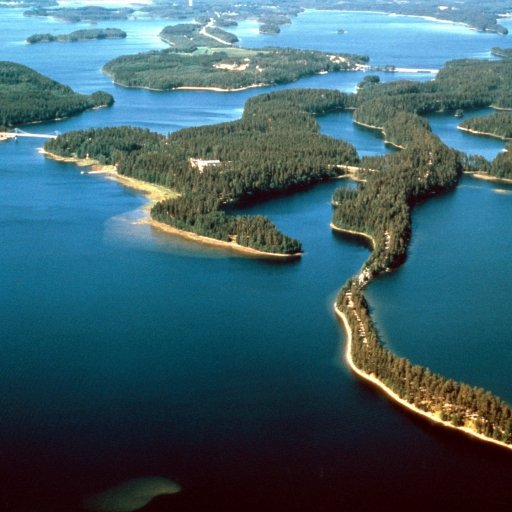
Reasons to Visit Finland
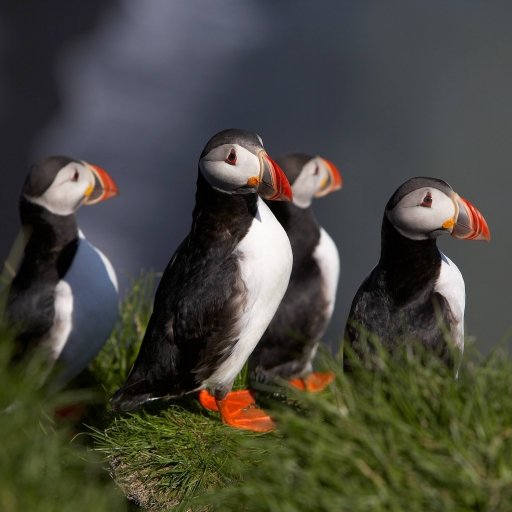
Reasons to Visit Iceland
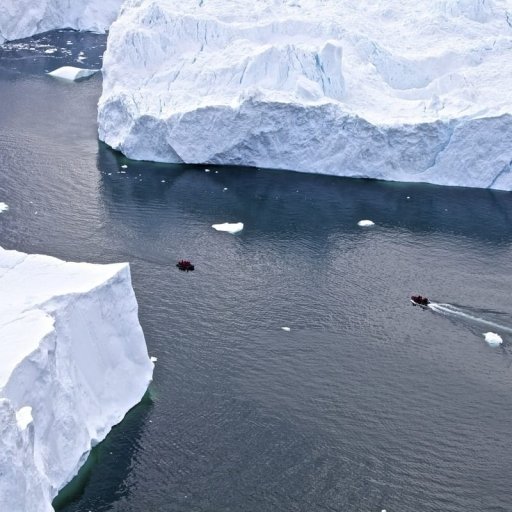
Reasons to Visit Greenland
Norway travel guide.
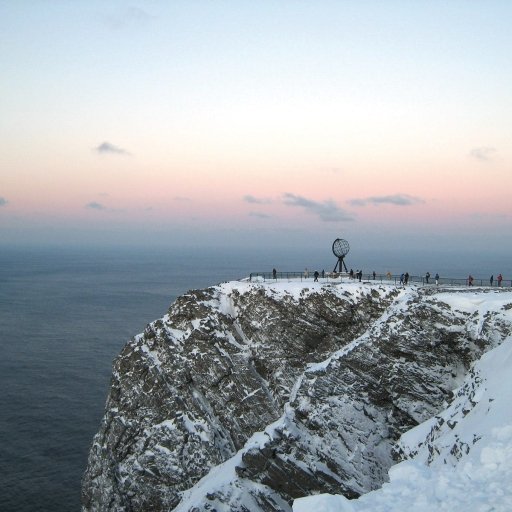
Most popular attractions in Norway
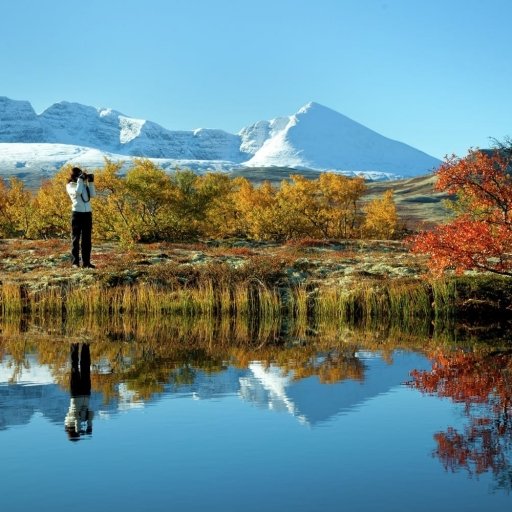
Highlights in Fjord Norway
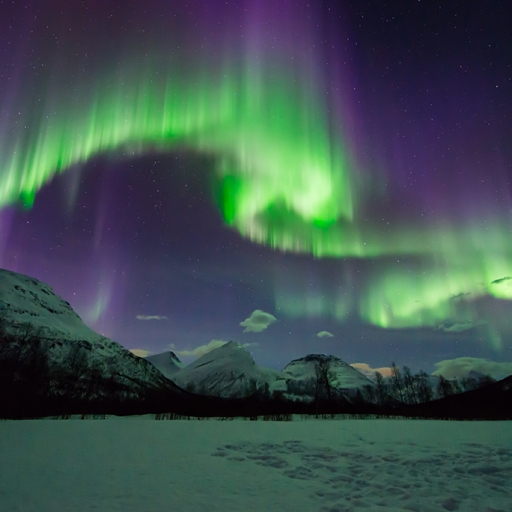
Top attractions in Northern Norway
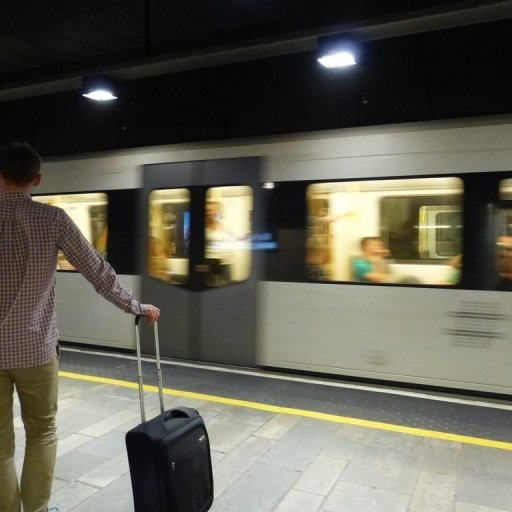
Getting around in Norway
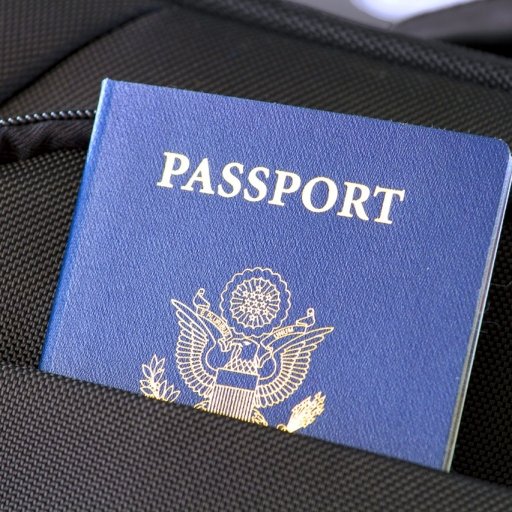
Visa to Norway
- Nordic Countries
- Inspiration
- Heritage & Culture
- Nature & Activities
- Design & Shopping
- Nordic Vikings
- Seasons & Weather
- Visitnordic
- Privacy Policy
- Terms of Use
- Become a Partner

We’re not taking new bookings for travel to Norway at the moment. Our specialists can advise you on all the destinations you can currently book with us.
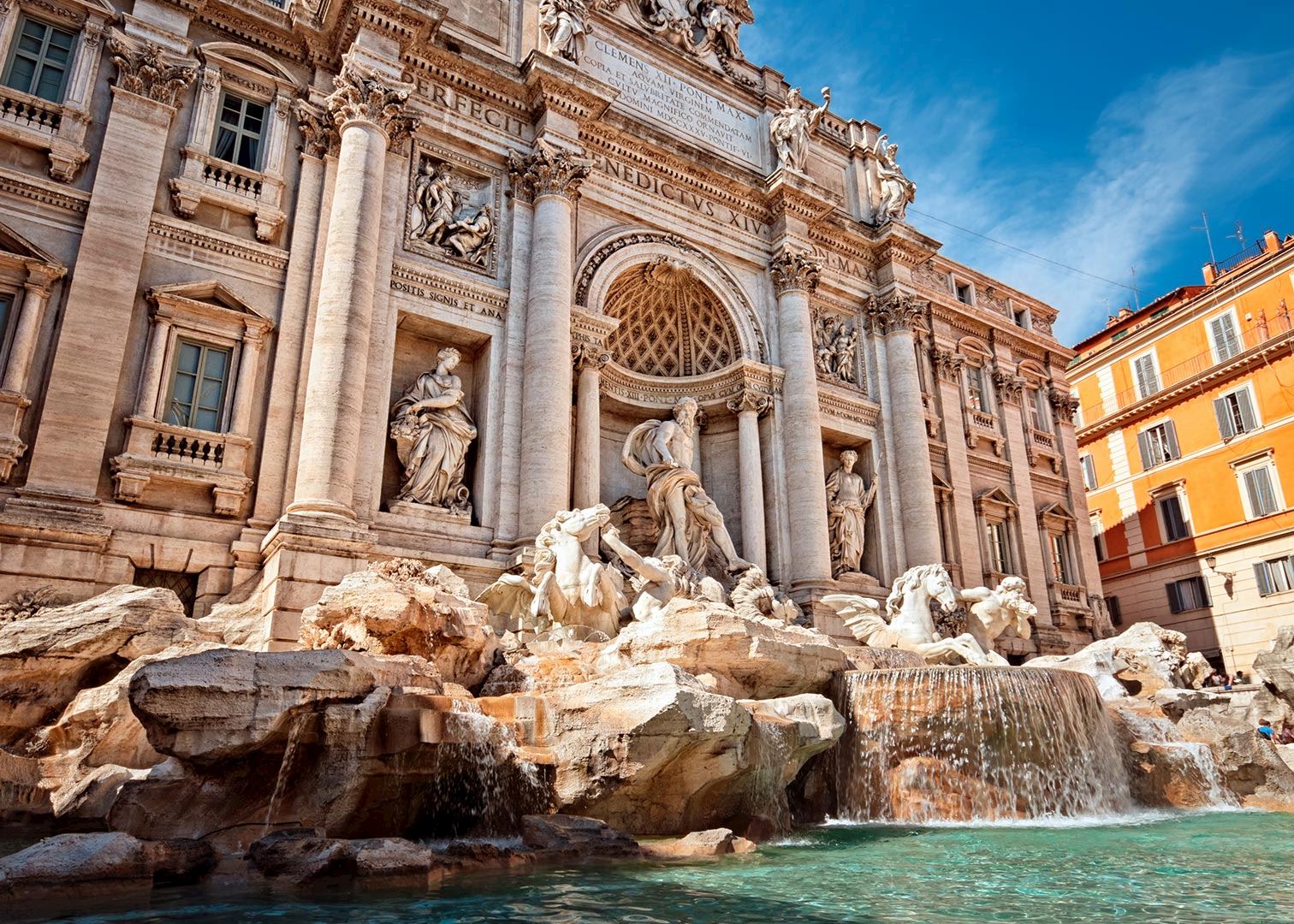
Change location
- Call us today until 8pm
- 01993 838 925 01993 838 763 or
- REQUEST A QUOTE
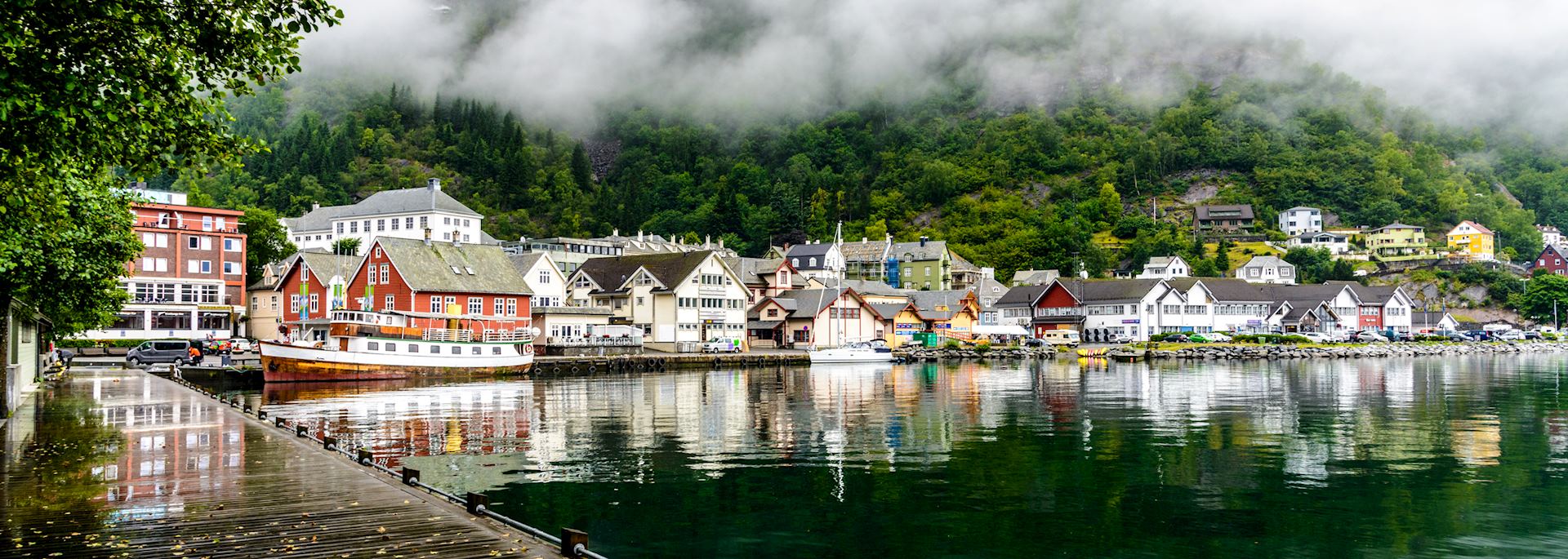
When is the best time to visit Norway?
- Month-by-month
The best time to visit Norway in the northern region is in the autumn, which brings thinner crowds, cooler weather between 5°C to 10°C, and glorious foliage.
The best time to visit Norway in the southern region is between May and August, when the days are long, the landscapes are green, and the weather is warm, between 16°C and 22°C. This is a popular time to explore the region, so expect to see a few more visitors around. In northern Norway, you can hike under the midnight sun at this time of year.
The two regions have very different climates, so when you visit Norway will likely depend both on what you want to do when you’re there and where you want to go.
Starting in late November and running until February or March, the whole country turns into a wintry playground, especially the northern region. If you’re comfortable with frigid temperatures, this is an excellent time to visit the Arctic Circle, where you can watch the northern lights and enjoy the deep snow that blankets the landscape.
The best time to visit the fjords is in April, May or June, which are perhaps the most photogenic months, when the fruit orchards on the shoreline explode into pastel bloom. However, this area of the country offers a milder climate and so makes an excellent destination year-round.
Month-by-month guide for travelling in Norway
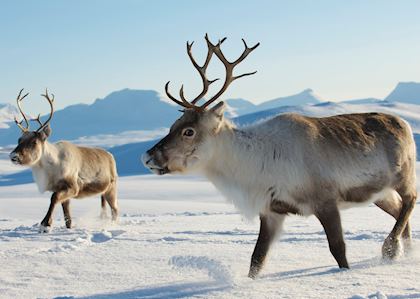
Visiting Norway in December - February
The whole of the country becomes a snowy winter playground during these months, though the deepest snow and coldest weather is found inside the Arctic Circle, where you can often see the northern lights. Temperatures can drop as low as -20°C (-4°F) up in the north, but it’s milder (around -2°C or 28°F) in the fjordlands.
Events & Festivals
- The Nobel Peace Prize Award Ceremony draws luminaries from around the world to Oslo in early December.
- Norwegians celebrate Saint Lucia Day with festivals of lights and parades on 13th December.
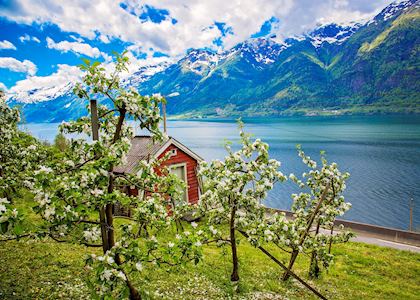
Visiting Norway in March - May
Winter begins to lift and the weather turns milder. The fjordlands burst into bloom as the shoreline orchards of fruit trees blossom. Melting snow fills the rivers and the waterfalls swell as wildflowers unfurl. There are fewer crowds in the cities this time of year, making it a good time to visit museums and other cultural attractions.
- The Bergen International Festival brings together performers, singers, dancers and other artists for a week-long festival in late May.
- Discover Norway’s medieval heritage at Oslo Middelalderfestival, also held in late May.
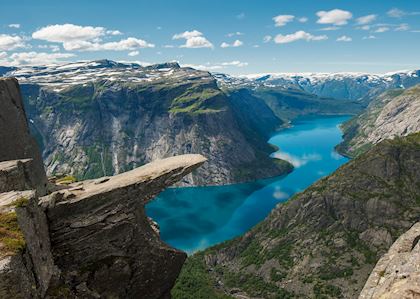
Visiting Norway in June - August
Days get longer, the weather warms and nights get shorter. In the Arctic Circle, there’s 24 hours of daylight, and you can hike under the midnight sun. This is when the weather is at its most stable across the country, with generally pleasant temperatures. It’s an excellent time to explore the rugged countryside and try to spot wildlife. It’s also the most popular season to visit, so be sure to plan well ahead.
- Bergenfest is a music festival in early June spanning a number of genres, including rock and hip-hop.
- The Oslo Jazz Festival and the Oslo Chamber Music Festival both take place in mid-August.

Visiting Norway in September - November
Days shorten, temperatures drop and the air is crisp and cool as the foliage shifts to gold. These are the wettest months, so cities tend to be busier than the countryside — it’s wise to plan ahead if you want your choice of hotels. Some of the attractions will take the opportunity to shut down while it’s quieter.
- The Ultima Contemporary Music Festival in Oslo is a long-running event sponsored by the crown prince each September.
Why travel with Audley?
- 100% tailor-made tours
- Fully protected travel
- Established for over 25 years
- 98% of our clients would recommend us

Travel advice
Practical tips for travelling to Norway, from social protocols to guidance on money matters, with a link to the latest FCDO travel advice.

Request our brochure
Covering all seven continents, The World Your Way shows you how you can see the world with us. It features trip ideas from our specialists alongside hand-picked stays and experiences, and introduces our approach to creating meaningful travel experiences.
Trip ideas and travel guides for exploring Norway
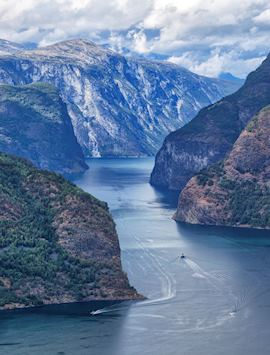
Introduction to Norway
6 days from £2,240pp
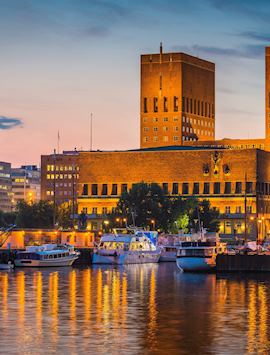
Highlights of Norway
7 days from £3,390pp

Active Scandinavia
9 days from £4,490pp
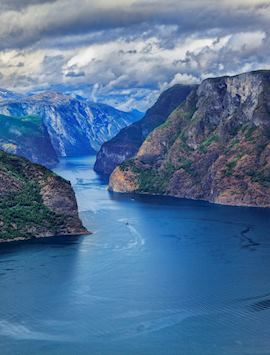
Beauty of the fjords
8 days from £4,605pp

7 Day Norway Itinerary: How to Spend One Week in Norway
N orway is maybe the most beautiful place I’ve ever been. It’s full of mountains and waterfalls and fjords along with delicious food and incredible cities. If you’re looking to plan a trip to Scandinavia, this 7 day Norway itinerary will help you easily see some of the best parts of Norway.
This is an itinerary you won’t need a car for, so it’s super easy for every traveler, especially if you are hesitant about renting a car in another country.
Keep in mind, Norway is a HUGE country with TONS to see though. Seven days in Norway won’t let you see everything, but it is a manageable trip that will let you see some of the best and most popular parts of Norway!
Why Visit Norway?
Norway is a country on so many people’s bucket lists. And for good reason! It is a beautiful country with breathtaking mountains and fjords, refreshing forests, and dramatic landscapes. Here are some reasons you may want to visit Norway:
- To stand on top of some of the most beautiful mountains (and you don’t even have to hike to them!)
- To take a bucket-list worthy fjord tour that I promise you will remember forever!
- To go to some amazing museums where you can learn about Vikings, see some of the most famous art in the world, and even let your kids play.
- To enjoy some of the most photogenic (i.e. Instragrammable, because let’s just be honest here) architecture and landscapes.
Best Time to Visit Norway
Every season in Norway can be a good one to visit, even winter! Each season is just very different.
But I think the best time to visit Norway is summer. You’ll get the best weather, with mild temperatures and less rain. Plus the sun hardly sets at all, which gives you extended daylight hours to enjoy all Norway has to offer!
When we visited in the summer, temperatures hovered around 60 degrees. So we needed light jackets, but we were perfectly comfortable!
Getting to Norway
If you arrive at the Oslo Airport, you’ll need to take a train into the city center. Oslo Gardermoen airport is about 35 km (or 22 miles) northeast of Oslo. But it’s super easy to take a train to the Central Train Station in downtown Oslo.
Likewise, the Bergen airport is several miles from the city center, but you can easily take the light rail into the city. It takes about 45 minutes or so. You can also choose to take the bus, which takes about 30 minutes.
If you are coming from a nearby country, you may choose to arrive by train. In that case, you should arrive at the central train station for each city, and from there it should be easy to walk or find public transportation to your accomodations.
Getting Around Norway
If you wanted to, you could definitely rent a car to get around Norway. However, it is NOT necessary! Norway has a fantastic public transportation system, with trains that can take you from city to city as well as around the city you are staying in.
On our trip, we didn’t rent a car at all and instead relied on trains and buses. And while going back to Norway and renting a car to drive around ourselves is definitely on my bucket list, we didn’t have any issues or feel like we missed anything by just taking public transportation!
Plus, since we bought the Oslo Pass and Bergen Card , all of our transportation (except for our longer train ride between Bergen and Oslo) was included!
7 Day Norway Itinerary Summary
Before we dive into the details of each day, let’s take a look a summary of this 7 day Norway Itinerary.
- Day 1: Arrive in Oslo and Explore Oslo
- Day 2: Explore Oslo with Akershus Fortress and Holmenkollen Ski Jump
- Day 3: Go to the Bygdøy Peninsula Museums in Oslo
- Day 4: Take the train from Oslo to Bergen
Day 5: Explore Bergen’s Mountains
Day 6: take a fjord tour.
- Day 7: Tour Bergen’s Best Museums
Norway Travel Resources
Do the cost analysis and consider getting an Oslo Pass and a Bergen Card . These passes include free (or sometimes discounted) admission to almost all of the city’s attractions and include free public transportation.
Where to Stay in Oslo: The Clarion Collection Hotel Bastion for families. Thon Hotel Opera for a super convenient location.
Where to Stay in Bergen: The Clarion Collection Hotel Havnekonteret for families. Opus XVI for a splurge.
Or use VRBO in either city to find a vacation rental.
You can buy a train ticket for the journey between Oslo and Bergen directly on Vy.no .
7 Day Norway Itinerary
Now let’s dive into the details of this itinerary! We’ve broken each section up into morning, afternoon, and evening to help you plan each day.
Also feel free to switch days around based on what works best for your schedule or even what the weather looks like! I mean, you don’t want to be going up mountains on the rainy day and touring museums on the sunny day!
One note: We did choose to start this itinerary in Oslo for a reason. Mostly because you know that travel advice to go from low to high or budget to luxury when moving resorts? I’m going to apply it to cities here too. Oslo is great and fine and good. And there are some incredible things to do here. But Bergen is one of our favorite cities ever, so it’s the best note to end on! BUT if it works better for you to reverse that order, definitely do it!
Planning a trip to Norway? Here are some books set in Norway to read before you go!
Day 1: Arrive in Oslo
Day 1 morning: get settled.
We’re going to assume you’re arriving to Oslo in the morning, so some of your morning time will obviously be taken up with travel logistics. We won’t pack a lot into the first morning, because you’ll want to find your bearings.
Once you get into the city, head straight to the Oslo Opera House . This is one of the most iconic sites in Oslo. It sits right on the water and you can WALK on the roof, which is pretty cool. I think this is a great place to start out because it’s a quick stop and it gives you some beautiful views, which I always appreciate after traveling.
Day 1 Afternoon: MUNCH Museum
Grab some lunch from one of many restaurants in the area near the Opera House and then head to the MUNCH Museum !
This new museum opened in 2021. It featured the works of famed Norwegian artist Edvard Munch, but it also has galleries featuring other artists and an exhibit about the life of Edvard Munch.
There are so many great things about this museum:
- Bright spaces and large galleries.
- Incredible views of Oslo!
- Fun, interactive displays and activities for kids in almost every different gallery space!
- You can see different versions of the famous painting, The Scream , here.
And if you bought the Oslo Pass , you can use it for admission into MUNCH.
Day 1 Evening: Frogner Park
Hop on the cable car near MUNCH at Dronningens gate (you’ll walk back past the Opera House) and get off at Vigelandsparken to go to Frogner Park . This is a large park in a central part of Oslo. It’s also where you’ll find the Vigeland Sculpture Park , a free outdoor museum featuring the work of Gustav Vigeland.
This is a great place to spend an evening walking the beautiful grounds and seeing some incredible (and free!) art!
Day 2: Explore Oslo
Day 2 morning: oslo’s royal history.
Let’s start day two of our 7 days in Norway visiting the royals! Well…kind of.
Start the morning off at Akershus Fortress where you can visit Akershus Castle . This complex was built in the late 1200s and has been used as a fortress and a royal residence. Today, you can tour the rooms and see the Royal Mausoleum.
While Akershus Castle is the main draw, Akershus Fortress is home to other Oslo attractions as well. You can visit the Norway Resistance Museum , which tells the story of Norway’s occupation and resistance during WWII. Or you can go to the Armed Forces Museum , which has exhibits of Norwegian military history from the Viking Age to modern day.
While entrance into the grounds of Akershus Fortress are free, you will need to use either an Oslo Pass or pay an admission fee for the museums.
After your time at Akershus, head to The Royal Palace . It’s about a 20 minute walk, or you can take the bus from Wessels plass to Nationaltheatret.
You can tour the inside of the Royal Palace from late June to mid-August, usually. But most of the time you’ll just stop by and see the outside of it. Depending on how long your morning took, you may decide to stick around and see the changing of the guard, which takes place at 1:30 p.m. each day.
Day 2 Afternoon: Holmenkollen Ski Jump and Museum
Note: The Holmenkollen Ski Museum is closed for renovations until the end of 2023. Until then, head to some of Oslo’s other museums like the National Gallery or the Nobel Peace Center.
For the afternoon, take the train to Holmenkollen to go to the Holmenkollen Ski Jump and Museum . (Remember, your Olso Pass gets you free access to local transportation including the regional trains like this one!). To get there, you’ll take the train from the Nationaltheatret station to the Holmenkollen station.
Pro Tip: To find the train station, you’ll go under the road from the park behind the Nationaltheatret. It’s a little hidden if you aren’t looking for it!
Once you get to Holmenkollen, it’s about a 15 minute walk (and kind of uphill, so be prepared!) to the Holmenkollen Ski Jump and Museum.
This ski jump has been operating since 1892, although of course it has been rebuilt since then. Inside the Ski Museum you’ll find exhibits about the history of skiing and the ski jump as well as the cutest indoor children’s play area I’ve ever seen.
Then you can take an elevator to the top of the ski jump for some incredible views!
Want more adventure? You can also go ziplining from the top of the ski jump!
Day 2 Evening: Oslo Street Food
For the evening, head to one of Oslo’s popular food halls, Oslo Street Food . Here you can get dinner from a variety of different food stalls that have food from around the world. Options include burgers, tacos, Hawaiian food, Korean food, and more. This is a popular place to go, so it will be busy! So find some great food and enjoy the atmosphere.
Day 3: Tour Oslo’s Bygdøy Peninsula
Day 3 morning: norsk folkemuseum.
For most of our third day in Norway, we’re going to enjoy the museums on Oslo’s Bygdøy Peninsula, which are some of the best museums in Oslo . To get there, you can easily take a bus from several spots in the city center.
The Norsk Folkemuseum , also known at the Norwegian Museum of Cultural History, is one of my favorite museums in Oslo. It’s a step back in time, as you can tour historic buildings in their open-air space and enjoy exhibits on Norwegian history in several indoor spaces.
Really though, my favorite thing about this museum is that you get to enjoy some peaceful nature in the middle of Norway’s capital city !
There are several highlights to see here:
- 160 historic buildings in the outdoor open-air museum.
- Gol Stave church, which is a great, easily accessible (as in, you don’t have to travel far) place to see a traditional Stave church.
- Wessels gate 15 Apartment House with rooms decorated from different time periods.
- Old Town area with buildings from Oslo, including old shops.
- Seter Summer Dairy Farm with fam animals.
This really is a beautiful museum, and is especially a great place to take kids because there’s so much outdoor space for them to run around in. Plus, on the weekends they have demonstrations that kids will enjoy like baking traditional lefse, seeing the blacksmith at work, and listening to fairytales.
While you are touring the museum, you can also enjoy lunch here at the Kafe Arkadia.
Admission to this museum is free with the Oslo Pass.
Day 3 Afternoon: Bygdøy Ship Museums
Spend your afternoon touring the rest of Bygdøy’s famous museums that all revolve of sea exploration. There are three you can choose from, and honestly, I recommend going to as many as you can. None of them are particularly huge museums, so you can spend an hour or two in each one and be able to see so much! Plus an Oslo Pass will give you free admission to all of them.
Bonus: They are all within walking distance of each other!
- Fram Museum — This museum is all about polar exploration. Climb aboard the Fram ship, learn about the race to reach the poles, go inside a sub-zero room, and test your skills as an explorer in interactive elements. This museum is really so much fun for the whole family!
- Kon-Tiki Museum — This is a smaller museum than the Fram Museum, and is all about the Kon-Tiki expedition where a Norwegian man build a balsa wood raft and sailed it with a small crew across the Pacific. The backstory of the expedition and the expedition itself are fascinating! I highly recommend this museum.
- Norwegian Maritime Museum — If you are interested in general maritime history, this is a great museum to go to! Here you can see different ships from Norway’s seafaring history, view an exhibit about what a sailor’s life has been like throughout history, and see a Viking boat being reconstructed.
Note: Normally the Viking Ship Museum is another popular museum to visit on Bygdøy. However, this museum is currently closed as they build the new Museum of the Viking Age which will open in 2026.
Day 3 Evening: Vippa
Take the ferry back across the fjord and then spend your evening at another popular Oslo food court: Vippa . This food court is located right on the Oslo fjord, which means you can enjoy your food and some great outdoor space at the same time. Here you’ll be able to find things like Syrian street food, Polish Pirogis, Chinese food, and more. They frequently switch up the food offerings, so you should find different options all the time!
This is a perfect way to end your time in Oslo — eating some great food and admiring the Oslo fjord. (And knowing that even more spectacular fjords are in your future!)
Day 4: Take the Train from Oslo to Bergen
We’re up to day four of our seven day Norway itinerary, and today you’ll be spending most of it traveling. Which can sound dull, but I promise you this mode of travel IS NOT.
Day 4 Morning & Afternoon: Train to Bergen
Today, take the train from Oslo to Bergen . This train, known as the Bergensbanen , is considered by many to be one of the most beautiful train rides in the world. And I have to say, I agree!
You’ll start in Oslo and travel out into its suburbs before climbing mountains that still sometimes have snow in the summer, passing through forests, and getting a preview of some of Norway’s best fjords.
The train journey itself takes about 7 hours. But it doesn’t seem that long at all!
Besides the most amazing scenery, there are some other great perks to this train journey:
- A family car, with a cushioned play area kids can play and climb in.
- A café car that offers food and drink. I got a warm sandwich here and honestly though it was pretty great!
- Wi-Fi, although it can be a bit spotty in some areas.
- Lots of tunnels, which are just fun!
Day 4 Evening: Dinner in Bergen’s Fish Market
Depending on when you leave Oslo, you’ll probably get into Bergen in the late afternoon. Once you get settled, head to the central area of Bergen and find some dinner at the Bergen Fish Market .
Bergen has long been known for their fishing history, and this area in the center part of town has several restaurants you can choose from. During the summer, there are also outdoor stands that offer different menus.
Then find a bench along the water and take a deep breath of fresh Bergen air and enjoy your evening people-watching and boat-watching!
Day 5 Morning: Bryggen
Start your first morning in Bergen with a stop at it’s most photographed area — Bryggen . These wooden buildings were once used as harbor warehouses and office buildings, but are now classified as a UNESCO World Heritage site.
And while this place can get super crowded later in the afternoon and evening, I love exploring it in the morning before the crowds are out! Be sure to go down the different alleyways and walk along the wooden planks. The architecture of this area has so much character.
Plus, morning is a great time to get photographs of beautiful Bryggen without the crowds!
Day 5 Afternoon: Mount Ulriken
Grab an early lunch, and then head to Ulriken643 to go up to the top of Mount Ulriken . You’ll have to take a bus to get here and then walk about 10 minute (kind of uphill), but I promise it is worth it!
This cable car will take you to the top of Mount Ulriken, where you’ll find amazing views of Bergen and the surrounding area. There are all kinds of hiking trails and places to explore up here. Although my favorite honestly might just be standing at the top of the mountain and looking at all the other mountains surrounding you. You can even see the lakes on top of some of them!
Ulriken is an incredible place and I definitely recommend making the time for it, even if getting to the cable car is a little out of the way.
If you are really up for an adventure, you can make a whole afternoon of hiking here too! You can hike from Ulriken to our next stop, Fløyen, across the mountaintops! It’s a medium-difficultly hike with some challenging areas and takes about 5+ hours. (And be sure to hike safely !)
Day 5 Evening: Mount Fløyen
End your day at my favorite spot in Bergen: Mount Fløyen ! This is another mountain in Bergen that offers amazing scenery and views of Bergen.
It’s a bit easier to get here than Ulriken. You can take the Fløbanen funicular, which departs just a couple blocks from the city center.
The terrain here is also very different from Ulriken. This mountain is forested, which gives you some really fun areas to explore. There are also fun things like a several playground areas, a troll forest, and ice cream stand, and a café.
You can grab dinner here, and then spend your evening exploring the forests and finding a spot at the overlook to watch the sun dip down. (Although, depending on what time of year you are visiting, it might not actually go down before you need to head to bed!)
Day 6 All Day: Fjord Tour
Bergen is known as “The Gateway to the Fjords” because it’s a great home base for seeing some of Norway’s most spectacular fjords in a day trip.
There are lots of different tours you can take to see the fjords, but we recommend the Norway in a Nutshell tour .
This tour is a self-guided tour that takes you through multiple modes of transportation (seriously, a train to a bus to a boat to another train, etc.) to popular fjords. You can choose to either book all of these tickets on your own, or pay a higher prices to have Norway in a Nutshell book the tickets for you .
When they book the tickets for you, they make sure all of your timings are worked out perfectly and they give you step-by-step instructions on how to follow the itinerary. Honestly, if it’s your first time in Norway or you feel remotely nervous about managing your own travel plans, I think this is the way to go!
This tour will take you through some of the most amazing places:
- The popular Nærøyfjord , which has to be one of the most beautiful fjords in Norway.
- Aurlandsfjord , which is a lot wider and definitely different, but still beautiful.
- Flåm , a small town situated at the base of the fjords
- The historic Flåm Railway , which takes you through the mountains and has you stop at an incredible waterfall.
I mean, did you really go to Norway if you didn’t see the fjords? So definitely make sure you set aside a day during your 7 days in Norway for a full day-trip of fjord-touring.
Day 7: Explore Bergen’s Museums
It’s your last full day in Norway, and since yesterday was so busy, we’ll take it a bit easier today with some of Bergen’s best museums.
Day 7 Morning: Gamle Bergen Museum
Start your morning off at the Old Bergen Museum (Gamle Bergen). You can take the bus from Bryggen and get off at the Gamle Bergen stop. Then it’s just a short walk under the road to the museum.
The Old Bergen Museum is an open-air museum with houses from…well, Old Bergen. They have been reconstructed to create a small town that shows what life was like in Bergen in the 1800s. You’ll find houses from community leaders, an old grocery store, and historic actors that tell you about Old Bergen.
Plus, this spot has some beautiful views out into the fjord. Besides all the things we learned about Old Bergen, I really loved this place because it felt so peaceful!
Admission to this museum is free with the Bergen Card.
Day 7 Afternoon: More Museums
Bergen has so many more museums! So after you grab lunch (maybe in Bryggen?), find one or two of these museums which sound most interesting to you!
Most of these museums have free admission with the Bergen Card.
- Norwegian Fisheries Museum — A small museum along the water that teaches you about the history of fishing in Norway and current fishing practices. Plus they have some great interactive exhibits that both kids and adults will enjoy!
- VilVite (Bergen Science Center) — If you are traveling with kids, this is a must! This museum is full of science experiments for kids. They will learn a lot, but they will really feel like they are playing the whole time!
- Bryggens Museum (Bergen City Museum) — If you want to learn more about the history and restoration process of Bryggen, then head here!
- Leprosy Museum — This is definitely one of the more unique museums in Bergen! Late 1800s, Bergen was home to the largest concentration of leprosy patients in Europe, and you can learn about this at what used to the be leprosy hospital.
- Fantoft Stave Church — If you want to venture out of town just a bit, you can take the bus to see the Fantoft Stave Church. This is less of a museum and more of just a sight to see, but if you are interested in Stave churches you’ll want to add this to your list.
Day 7 Evening: Bryggen
There’s no better way to end your last evening in Norway than back in Bryggen , where you can grab some dinner, relax by the water, and maybe do some souvenir shopping. (Although try to hit the shopping before dinner since stores will start to close!)
We’ll keep it low-key this evening, since you probably need to head back to your hotel and start packing up. But stay out for a bit and soak up a bit more of that fresh mountain air that you will wish you could bottle up and take home with you.
Tips for Visiting Norway
If you’re coming from the United States, Norway is a relatively easy country to visit. Most Norwegians are comfortable speaking English, most restaurants and shops take credit cards (in fact, lots don’t take cash!), and cars still drive on the right side of the road.
Here are a few tips to make your travels to Norway a little smoother though:
- Expect rain! It can rain a lot in Norway, and weather can easily change from clear skies to rain within the day. Always have rain gear with you! And wear shoes that will be okay in the rain.
- Wear layers. Temperatures during the day can vary, so always be prepared with layers.
- Wear sunscreen! This is just a good all around travel tip, and since Norway can sometimes be gray or rainy, you may not think to put sunscreen on. But always apply it!
- Budget for food expenses. Norway is known to be one of the most expensive countries to visit, and we definitely saw that in the food prices! So make sure you have plenty of room in your budget for food. We definitely found Oslo to be more expensive than Bergen though.
- Learn some Norwegian. Even though Norwegians are comfortable speaking English, learn a few words like “hello” and “thank you” in Norwegian to be polite.
- Don’t be surprised with you don’t get a response. If you are trying to be polite and say “thank you” don’t be surprised if you don’t get a “you’re welcome” back. It’s just one of those cultural things, but no one is being rude!
- Consider City Passes. If you plan to see a lot of sights in Oslo and Bergen during your 7 day Norway itinerary, consider getting the Oslo Pass and Bergen Card to save money. They also include local transportation!
- Check attraction times and dates. Always be sure you know what time something opens. And check the dates too! Some museums may be closed on certain days or even during the winter entirely!
More Norway Posts
- Norway in a Nutshell Review: How to See Norway’s Incredible Fjords
- 3 Days in Bergen, Norway: What to See and Do
- 13 Best Museums in Oslo, Norway
- How to Spend One Day is Oslo, Norway
Like this post? Save it for later!
The post 7 Day Norway Itinerary: How to Spend One Week in Norway appeared first on Flying Off The Bookshelf .
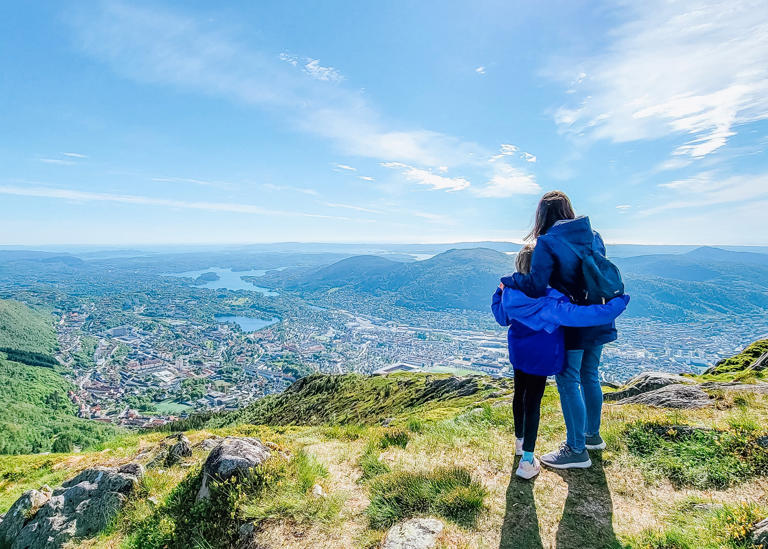
When To Visit Norway: A Monthly Guide
.webp)
If you're thinking about visiting Norway and wondering when is the best time to go, we've got good news for you! This Scandinavian country has something special to offer in every season.
From magical winter wonderlands with Northern Lights displays to long summer days with never-ending sunlight, Norway is a destination that can be enjoyed all year round.
To help you plan your trip, we've put together a list of what you can expect in Norway each month, along with some exciting events and festivals that are worth attending. Start planning your Norway trip with this guide and get ready for an unforgettable adventure in one of the most beautiful countries in the world!

Best Time to Visit Norway
Don’t have time to read the whole article? No worries! To help you plan your trip, here are the most popular activities in Norway, along with the best months to visit.
Whale Watching: Late October to mid January
Northern Lights: November to February
Midnight Sun: Typically from June to July
Road Trips: April to early September
Hiking: May to September
Camping: April to September

Weather in Norway by Month
This guide can help you plan your trip to Norway accordingly and make the most of your visit. We've listed what to expect in Norway by month, as well as the major events. It's always a good idea to check the weather forecast and book your accommodations ahead of time, especially during peak tourist seasons.
.webp)
January is one of the coldest months in Norway. During this month, you can expect snow almost everywhere. With an average daylight of 6 to 7 hours, January is one of the best months to view the northern lights.
You can also enjoy many snow activities in the mountains, such as skiing and dog sledding. Except for ski resorts and ice hotels in the snow, January is a slow season with lower prices and fewer crowds. As the coldest and darkest month of the year, January has a unique beauty that can only be experienced during this time.
Events: Northern Light Festival , Tromso International Film Festival

February in Norway is usually a bit brighter and has longer days than January but it still is another cold month in Norway. Despite the colder temperatures, February is still a great time to visit, as there are plenty of outdoor activities that can be enjoyed, including viewing the northern lights.
February in Norway is still the low season, so you can take advantage of lower rates and fewer crowds for another month.
Events: Ice Music Festival , Kristiansund Opera Festival , PolarJazz Festival , Sami Week

March has plenty of festivals to enjoy. It is still considered an off season month in Norway, but the days start to become noticeably longer and temperatures begin to creep up a bit, making it a great time for outdoor activities. During this month, there are more daylight hours to enjoy winter sports.
You can enjoy lower rates and fewer crowds in March until the end of the month, when spring breakers begin to arrive. It is also the last chance to see the northern lights before they disappear until autumn.
Events: Narvik Winter Festival , Winter Chamber Music Festival , Stavanger Vinfest , Holmenkollen Ski Festival
.webp)
As the weather warms and nature begins to bloom, spring arrives in Norway, making it an ideal time to explore the country. The weather in the north is still cold, but it warms up later in the month. While the rest of the country enjoys longer daylight hours and temperatures ranging from 4 to 9 degrees Celsius.
April is considered shoulder season in Norway, so you can enjoy fewer crowds and lower rates. It is also one of the best months to cruise the Fjords. It is important to note that some businesses may be closed during Easter.
Events: Voss Jazz festival , Inferno Metal festival
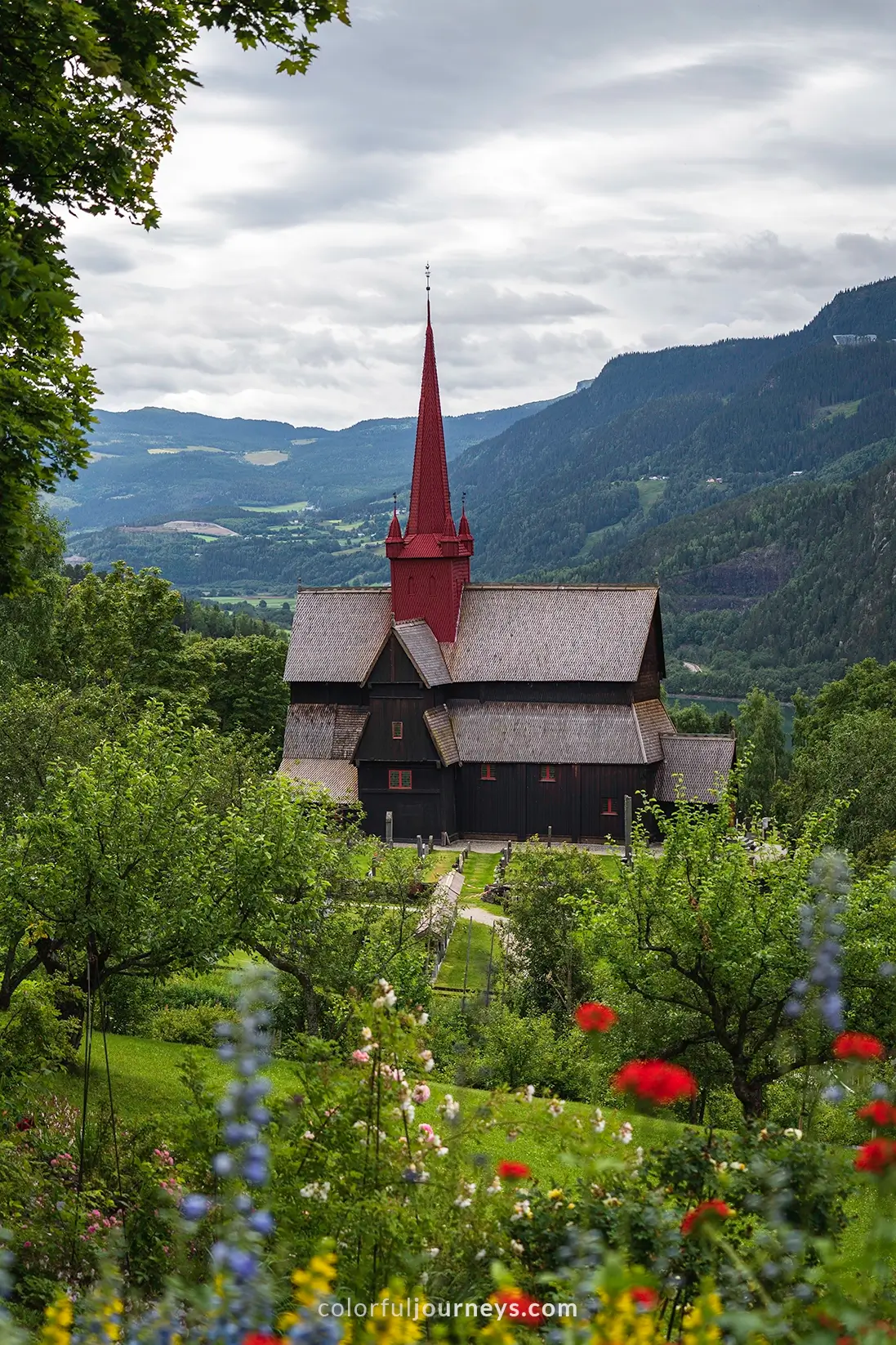
May is an excellent time to visit Norway before the summer crowds arrive, as most tourist attractions still have lower prices and fewer visitors. Spring is in full bloom, and you can look forward to warmer weather and longer days.
The weather in May is also known to be extremely unpredictable, so expect some days to be rainy and others to be warm and sunny. May is an excellent month for hiking, and waterfalls are in full flow due to melted snow. On the 17th, you can also join the locals in celebrating Norway's National Day.
Events: Bergen International Festival , Mai:jazz, Stavanger International Jazz Festival

June in Norway is the beginning of the summer months, offering the perfect opportunity to experience all that this picturesque country has to offer. With warmer weather and longer daylight hours, you can enjoy a variety of outdoor activities such as hiking, cycling, and camping.
In June, there are numerous outdoor and music festivals to attend. The great weather also brings more crowds, so expect higher prices this month for most activities, accommodations, and attractions. Head up to the north to experience the midnight sun in Norway.
Events: Extreme Sports Festival , Overoslo Music Festival , Færderseilasen Race , Risør Kammermusikkfestival

The busiest time of the year in Norway is in July. With the warm temperatures and long hours of daylight, many people choose to take their holidays during this time, including the Norwegians. As a result, long lines at popular attractions and higher prices are to be expected.
In July, daylight lasts around 16 to 18 hours, perfect for enjoying the outdoors. July is also an excellent month for island hopping, fjord cruising, and hiking. Tourists visiting Norway during this month can expect days filled with festivities and breathtaking views of the midnight sun around the arctic circle.
Events: Gladmat , Riddu Riđđu Festival , Arctic Sea Kayak Race , Kongsberg International Jazz Festival

August marks the end of the summer season in Norway but it is still considered a high season, so prices remain high. However, you can expect smaller crowds at the main tourist attractions compared to July. During this month, you can still enjoy pleasant temperatures and many sunny days.
However, expect unpredictable weather in the north and prepare for some rainy days. With plenty of sun lasting 14 to 16 hours, August is still a great time to visit and enjoy the outdoors. Such as hiking, camping, and the numerous festivals that take place throughout the month.
Events: Bergen Beer Festival , Norway Seafood Festival , Pstereo Music Festival , Skalldyrfestivalen

September marks the beginning of autumn. It is a great time to visit if you want to avoid the summer months while still enjoying longer daylight hours. Expect the weather to be cooler in the early mornings and evenings, so bring some warm clothing with you.
If you enjoy hiking or camping, September is an excellent month to avoid crowds. Just be prepared for the unpredictability of the weather and expect some cool wind or rain. You need to plan ahead when visiting in September as some popular attractions may be closed and tour availabilities are limited.
Events: Bergen Food Festival , Oslo Marathon

The month of October in Norway is ideal for viewing the autumn foliage. October sees fewer travelers due to the cooler weather and shorter days, so you can expect a quieter and less expensive travel experience compared to the peak season. The northern lights will begin to appear in the Arctic Circle as the days become shorter.
However, Norwegian autumns are known to be very unpredictable. As a result, expect cloudy and rainy weather in October. We recommend checking the weather forecast for the area you're visiting ahead of time and bringing warm and waterproof clothes.
Events: Lillehammer Jazz Festival , Insomnia Festival
.webp)
November in Norway is the last month to see the last fall colors. This is typically a slow month with fewer visitors because summer vacationers have long since left and winter travelers have yet to arrive.
You can expect warmer weather in the south and winter-like conditions with freezing temperatures in the north. Remember to bring warm clothing, as well as rain and snow-resistant walking shoes.
Because there are fewer daylight hours in November, you have a good chance of seeing the northern lights. It's also a great month for other winter activities like skiing and dog sledding in the north.
Events: Rakfisk festival
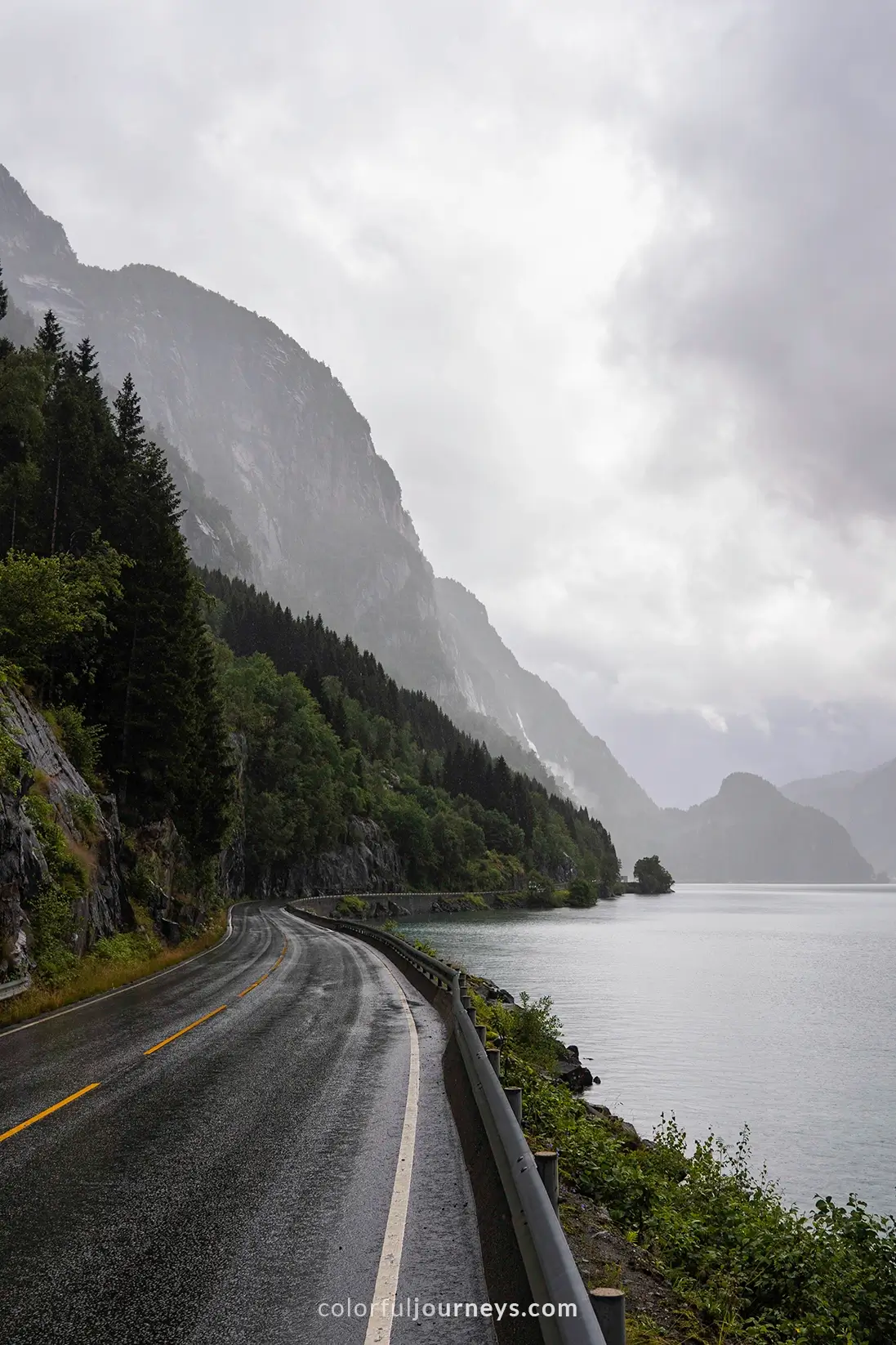
While December is a very busy month for Norwegians, it is slightly less busy for tourists. It is a great time if you want to experience the Christmas spirit, as the villages and cities have a festive atmosphere as they get ready for the holidays.
December is also one of Norway's coldest months, with 5 to 6 hours of daylight in the south and polar nights in the north. That means there's a good chance you'll see the northern lights in December. Just remember to bring warm clothes and be prepared for rain that can turn to snow. Other December activities include a whale safari, ice skating, reindeer sledding, and many more.
Events: Røros Christmas Market , St. Lucia Day
.webp)
And that's the guide to the best times to visit Norway, as well as a monthly guide to what you can expect.
Norway is a beautiful country, and visiting during any month of the year promises a unique and unforgettable experience. With a variety of activities available all year, Norway has something for everyone, and you're sure to have a great time.
Some links in this Norway guide may be affiliate links.
This means that if you make a purchase after clicking on one of our links, we will receive a small commission at no extra cost to you. Please know that by doing so, you are supporting Colorful Journeys in continuing to provide free high quality content to help you in your travels!
Share this article
Related posts.
.webp)
Guide to Driving the Atlantic Ocean Road in Norway
Looking to drive the Atlantic Ocean Road in Norway on your own? Here is a guide that includes the best time to drive, things to do, photography tips, and more!
.webp)
A Guide to Lovatnet Lake in Norway
Visit Lovatnet Lake, also known as Lake Loen, one of the most breathtaking lakes in Norway using this complete guide for first-time visitors.
.webp)
Visiting Briksdalsbreen Glacier in Norway
Here is a complete guide to the most popular glacier arms to visit in Norway - Briksdalsbreen Glacier! Find out when to visit, best way to reach the glacier, troll car and hiking information, and many tips to help you plan your trip.
Physical Address
304 North Cardinal St. Dorchester Center, MA 02124

The Best Time To Visit Norway: A Month-By-Month Guide
- June 9, 2023
If you’re planning a trip to Norway, it’s important to know the best time to go. Norway is a beautiful country that offers different experiences depending on the time of year.
Whether you want to see the Northern Lights, hike through the fjords, or bask in the sunshine, there’s a perfect time for you to visit.
In this month-by-month guide, we’ll take you through the different seasons and highlight the best activities and sights to see during each one.
From the snowy winter wonderland to the lush greenery of summer, Norway has something to offer all year round.
So pack your bags and let’s explore the best time to visit Norway!
January – March: Experience the Northern Lights and Winter Activities
If you’re looking for a winter wonderland adventure, you’ll want to visit Norway between January and March to witness the awe-inspiring Northern Lights and take part in thrilling winter activities .
Dog sledding and ice fishing are among the most popular winter activities in Norway’s Northern Lights season. You can explore the snow-covered landscapes on a dog sled, or try your hand at ice fishing and catch your own dinner.
The Northern Lights, or Aurora Borealis, are a natural phenomenon that can only be seen in certain parts of the world, and Norway is one of the best places to witness this incredible display of lights. The best time to see the Northern Lights in Norway is from December to March, and you can take part in guided tours to ensure you have the best chance of seeing them.
As you admire the dancing lights in the sky, you’ll feel like you’re in a magical winter wonderland.
Now, let’s move on to the next season: April – May, springtime in Norway.
April – May: Springtime in Norway
Experience the beauty of Norway’s spring season in April and May, where the stunning landscapes come to life with colorful blooms and the fresh scent of nature. As the snow melts away, Norway transforms into a picturesque paradise with vibrant wildflowers, green forests , and crystal-clear lakes.
The best activities during this season include hiking and cycling through the countryside, where you can witness the stunning scenery up close. You can also go fishing in the fjords, where salmon and trout thrive during this time of year.
In addition, April and May is the perfect time to visit Norway’s major cities, such as Oslo and Bergen, where you can stroll through the streets and enjoy the warm weather. You can also visit the numerous museums and art galleries, which offer a glimpse into Norway’s rich history and culture.
As the spring season is a popular time to visit Norway, make sure to book your accommodation and activities in advance to avoid disappointment. Now, let’s move onto the next season, where Norway truly shines: summer.
June – August: Summer in Norway
Now that the spring season’s come to an end, it’s time to get ready for summer in Norway!
Get ready to explore the stunning fjords and coastline that this beautiful country has to offer.
Experience the magic of the midnight sun during this time of year and attend music festivals like the Oslo Jazz Festival for a truly unforgettable summer adventure.
Don’t miss out on all the fun that Norway’s got to offer during this exciting season!
Explore the Fjords and Coastline
You’ll be mesmerized by the stunning fjords and picturesque coastline of Norway during the summer months. The best way to experience the beauty of Norway’s coastline is by taking a fjord cruise. You can explore the majestic fjords, see waterfalls cascading down the cliffs, and spot wildlife like eagles and seals. Along the way, you can also visit charming fishing villages and experience the local cuisine.
Norway’s coastline is dotted with small towns and villages that offer a glimpse into the country’s rich fishing culture. From the colorful houses of Bergen to the quaint town of Ålesund, there are plenty of places to explore. You can sample freshly caught seafood, stroll along the harbor, and learn about the history of Norway’s fishing industry.
As you immerse yourself in the culture and natural beauty of Norway’s coastline, you’ll begin to understand why it’s such a popular destination. And if you think the scenery is breathtaking during the day, just wait until you experience the midnight sun!
Experience the Midnight Sun
As the sun sets and the sky turns into a soft shade of pink and orange, you’ll witness a natural phenomenon like no other when the sun never truly sets but rather dips just below the horizon before rising again in a blaze of glory, creating a stunning display of colors that will leave you in awe – the midnight sun in Norway is a sight to behold.
During the summer months, the sun remains visible at all times of the day and night above the Arctic Circle, providing ample time for outdoor activities and exploration.
If you’re looking to experience the midnight sun in Norway, there are several activities and locations that offer breathtaking views. Here are three options to consider:
- Hike to the top of Mount Fløyen in Bergen, where you can enjoy panoramic views of the city and the midnight sun.
- Take a midnight sun cruise along the coast of Tromsø, where you can witness the sun’s reflection on the calm waters of the fjords.
- Visit the Lofoten Islands, where the rugged landscape and picturesque fishing villages are surrounded by a golden glow during the midnight sun.
As you bask in the beauty of the midnight sun, don’t forget to attend music festivals like the Oslo Jazz Festival, where you can enjoy live performances amidst the stunning natural backdrop of Norway.
Attend Music Festivals like the Oslo Jazz Festival
Don’t miss out on the opportunity to groove to live music amidst the stunning natural backdrop of Norway at the Oslo Jazz Festival. This annual event, held in August, is a must-attend for music lovers from all over the world.
The festival features a diverse lineup of jazz musicians from Norway and beyond, performing in various venues across the city. Some of the Oslo Jazz Festival highlights include the opening concert at the Oslo Opera House, the Jazz Cruise on the Oslo Fjord, and the Jazz Picnic in the Frogner Park. The festival also offers workshops, seminars, and jam sessions for aspiring musicians.
The music scene in Norway is thriving, and the Oslo Jazz Festival is a testament to that. So, mark your calendar and get ready to experience the best of jazz music in Norway.
As the summer comes to an end, the autumn season in Norway brings a different kind of beauty. The leaves turn golden, the air becomes crisp, and the landscapes transform into a picturesque wonderland.
September – October: Autumn in Norway
As you move into September and October, you’ll find that Norway’s autumn is a breathtaking sight to behold. The crisp air and changing colors make it the perfect time for outdoor activities like hiking and scenic drives.
You can experience the vibrant reds, oranges, and yellows of fall against the stunning landscape. And if you’re lucky, you may even catch a glimpse of the Northern Lights during the annual Northern Lights Festival.
Enjoy Hiking and Scenic Drives
Enjoy hiking and scenic drives in Norway! Experience the breathtaking beauty of the country by taking scenic drives and hiking through stunning landscapes. This offers a true immersion into Norway’s unparalleled natural wonders. Here are four must-see scenic routes and best trails for hiking during September and October:
- Geiranger-Trollstigen National Tourist Route: This route offers a fantastic view of the Geirangerfjord and the Trollstigen mountain road, with many stops along the way for photos and hikes.
- Rondane National Park: This park offers a range of hiking trails for all levels of hikers, with stunning mountain views and beautiful autumn colors.
- Hardangervidda National Park: This park offers scenic drives with stunning views of mountains, glaciers, and waterfalls. It also has many hiking trails for all levels of hikers.
- Sognefjellet National Tourist Route: This route offers a scenic drive through the highest mountain pass in Northern Europe, with breathtaking views of glaciers, mountains, and lakes.
As you explore the scenic routes and hiking trails, you’ll also witness the stunning colors of fall in Norway. From the vibrant reds and oranges of the leaves to the golden hues of the sunsets, the autumn season in Norway is an experience not to be missed.
Experience the Colors of Fall
Fall in Norway is a truly enchanting time, with the vibrant colors of the leaves and golden hues of the sunsets creating a mesmerizing atmosphere. It’s the perfect time to take a leaf peeping tour and witness the stunning autumn foliage that blankets the countryside. The bright reds, oranges, and yellows of the trees against the backdrop of the blue sky and the fjords is a sight to behold.
Aside from the colorful foliage, fall is also the season for autumnal food festivals. This is the perfect opportunity to indulge in the local cuisine and try out traditional dishes such as reindeer stew, smoked salmon, and hot mulled wine. These festivals are held all over Norway, so you can experience the unique flavors of each region.
As the leaves fall and the autumn festivals come to an end, it’s time to prepare for the next season and attend the northern lights festival.
Attend the Northern Lights Festival
Don’t miss out on the chance to witness the breathtaking display of the Northern Lights at the annual festival. The Northern Lights Festival is held in Tromsø, Norway, and it’s the perfect opportunity to witness the aurora borealis while immersing yourself in the local culture.
Here are a few things you can experience during the festival:
- Northern Lights photography workshops led by professional photographers.
- Concerts featuring traditional Norwegian music and dance performances.
- Guided tours of the city’s historic landmarks and museums.
- Delicious local cuisine, including fresh seafood and reindeer meat.
In addition to the stunning display of the Northern Lights, the festival offers a wide range of cultural experiences that are sure to enhance your visit to Norway.
As the festival comes to a close, it’s time to gear up for the winter wonderland of November and December.
November – December: Winter Wonderland
By November and December, Norway transforms into a winter wonderland, making it the perfect time for skiing and snowboarding enthusiasts to visit. The snow-covered landscape is a sight to behold, and the crisp, fresh air is invigorating.
Winter activities such as dog sledding, ice fishing, and snowmobiling are also popular among visitors.
In addition to winter sports, Norway’s Christmas markets are a must-see during this time of year. The markets are filled with handmade crafts, traditional Norwegian food , and festive decorations.
The largest Christmas market in Norway is held in Oslo, but smaller markets can be found in other cities throughout the country.
Strolling through the markets, sipping on hot cocoa or gløgg (Norwegian mulled wine), and listening to carolers singing in Norwegian is a truly magical experience.
Congratulations! You now have a month-by-month guide on the best time to visit Norway. Whether you’re a fan of winter sports, spring blossoms, summer hikes, or autumn foliage, Norway has something to offer year-round.
Remember to pack accordingly for each season, and don’t forget your camera to capture the stunning scenery. Norway is a place of natural beauty, with majestic mountains, sparkling fjords, and charming towns.
So, what are you waiting for? Start planning your trip to Norway and experience the magic of this Nordic wonderland. Safe travels!
travellingnorway
Related posts.
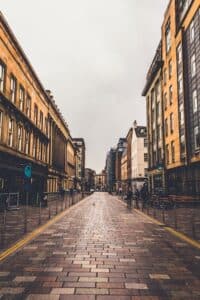
Holmsbu: A Quaint Town With A Big Heart
- July 12, 2023
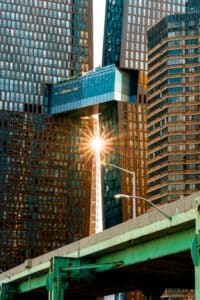
The Copper Town Of Norway
- July 8, 2023
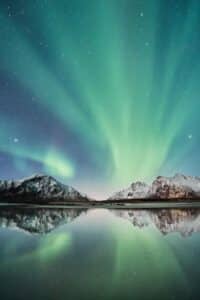
Capturing The Spirit of Norway In Setermoen
- July 6, 2023
Trending now
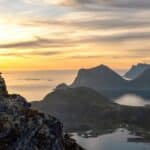
- Inspiration
When is the Best Time to Visit Norway?
If you’re planning a trip to Norway, you’re likely wondering what the best time of year is for visiting our beautiful country. Norway is actually a great travel destination year-round, so it’s hard to go wrong no matter what time you end up visiting! The best time for you to go to Norway depends on where you’d like to go and what you’d like to do during your trip.
In this article, we’ll tell you about the Norwegian climate and weather conditions, and give you some insight on what the best time for your visit would be depending on what you’d like to do.

What’s the climate in Norway like?
The climate in Norway varies a lot between the different parts of the country, and even within regions, the weather and climate can vary greatly. In general, Norway enjoys a much more mild climate than other places in the world that share the same latitude, for example, Siberia and Alaska – this is due to the warm water the Gulf Stream brings. However, Norway can still feel quite cold to travelers, and the North of Norway is generally much colder than the rest of the country due to the Arctic climate .
Norway’s coast enjoys a fairly mild climate, which is one of the reasons that fjord Norway is so popular as a destination all year round. No matter what time of year you decide to visit Norway, we would recommend checking the weather forecast ahead of your visit and packing warm clothes !

When is the best time of the year to visit Norway?
Spring is a lovely time to go to Norway since the snow and ice will have melted away in most parts of the country, and flowers are in bloom. Springtime is a wonderful season for Norwegians, marking the end of the winter which can often seem long and dark. A city break or an active holiday such as skiing or hiking (depending on where in the country you’d like to go) is a fantastic option for a Norway holiday in spring. During the spring, there will also be fewer tourists around than during the height of summer, making it an attractive period for travelers hoping for a more low-key experience in Norway.

Summer is, perhaps unsurprisingly, the peak period for travelers to Norway. The weather is usually mild depending on where you go, and there’s plenty to do and see during the summer. The south of Norway is considered a true paradise during the summer, with many Norwegians opting to go there during their holidays rather than going abroad. The summer is the best time to come to Norway if you’re hoping to experience the fascinating midnight sun when the sun is up all night long in certain parts of Northern Norway. The summer weather in Norway is usually quite nice, with pleasant temperatures on land and to a lesser extent in the sea for those looking to have a swim.

In the autumn , the colors in the beautiful nature and scenery of Norway changes, with tones of orange and brown on the mountainsides. Since it’ll usually still be fairly mild temperatures in autumn, this is a lovely time for an active holiday in Norway , with many hikers, cyclists and other outdoor enthusiasts opting to visit during this time. Autumn is also a great time for a city break or a spa holiday, with plenty to do and see in Norway’s bigger cities and in the charming rural villages and towns.

Winter is a fantastic time to visit Norway due to the many interesting experiences and activities that can only be done during the cold and snowy season. For many travelers, it’s an extra bonus that the winter months offer a much more quiet traveling experience than the height of the summer season with its many tourists. If you’re coming to Norway during the winter, chances are you’re doing that because you’re keen to experience the snowy winter wonderland with its many opportunities for outdoor exploration and activities . Also, the winter season is the best time to experience the aurora borealis – the spectacular northern lights so many visitors come to Norway hoping to catch a glimpse of.

When is the best time to go to the fjords?
Fjord Norway is a popular destination for travelers all year round. In the spring, you’ll be able to experience the stunning fjords with flowing waterfalls and blossoming fruit trees on the hillside landscape. The summer, with its warmer weather and plenty of opportunities for outdoors activities , is the high season for travelers to Norway, with fjord Norway being a hugely popular attraction. The autumn will bring lovely fall colors to the fjord landscape and is a great season for exploring Norway’s natural landscape. The winter is a fantastic time to explore the fjords if you’d like to see them at their most quiet and serene, with much fewer people around – and as an added bonus, the beautiful snow-capped mountains around the fjords will look spectacular.
No matter what season you choose to visit Norway, we recommend experiencing the Norway in a Nutshell® tour . This tour does exactly what it says on the tin as it gives you Norway - in a Nutshell!

Protect Your Trip »
The 18 best places to see the northern lights.
Check the aurora borealis off your bucket list.
The Best Places for the Northern Lights

Getty Images
The northern lights, known as the aurora borealis, are a spectacular natural light show visible at certain times of the year in the Northern Hemisphere. They occur when electrically charged particles from the sun collide with gases in the Earth's atmosphere, creating vibrant streaks of blue, green, pink and violet dancing across the night sky. 2024 and 2025 are an excellent time to catch the northern lights: Solar activity will be at a peak, making for a more impressive experience, if you're in the right place.
The best places to see the aurora borealis have little light pollution, clear skies and no precipitation. The lights are only visible at northern latitudes when it's dark outside, so the months from September to April are best for seeing the aurora. There's also a Southern Hemisphere counterpart, the aurora australis; there are fewer easy spots from which to view this phenomenon, but if you're lucky, it can be equally brilliant.
For more information on the northern lights, scroll down to the FAQ section at the bottom of this page. Read on to discover the top destinations where you can see the kaleidoscopic northern and southern lights.
Fairbanks, Alaska

Fairbanks is by far one of the best places in the world to view the northern lights, as it's located directly under the auroral oval. This ring-shaped zone sits around the Earth's geomagnetic North Pole and is generally associated with the most vibrant aurora sightings. Visitors can expect to see the lights on an average of four out of five clear nights during aurora season, which lasts from late August to late April.
You can book a northern lights tour to see the aurora from the springs and tubs at Chena Hot Springs Resort. This excursion includes round-trip transportation to the resort from town, a soak in the hot springs, a visit to the Fairbanks Aurora Ice Museum and an aurora viewing tour; dinner and drinks centered around Alaska produce are an option extra with hot drinks supplied.
There's more to Fairbanks than just the northern lights: If you visit in late summer, consider family-friendly activities like a ride on the Riverboat Discovery or gold panning. For a festive holiday experience in the winter, head around 15 miles out of Fairbanks to visit the Santa Claus House in the city of North Pole. Travelers can also see ice sculptures in February and March at the impressive World Ice Art Championships or take a dog-sledding or snowmobiling tour .
Where to stay: For excellent chances of aurora viewing, book a private igloo at Borealis Basecamp, a top glamping resort located on 100 remote acres of boreal forest about 25 miles from Fairbanks. With activities like dog-sledding on top of aurora viewing, past visitors regularly describe it as a once-in-a-lifetime experience.
Tromsø, Norway

Located about 220 miles above the Arctic Circle, Tromsø is one of several top spots to view the northern lights in Norway. At the darkest point of the aurora season – which runs from September to early April – the sun doesn't rise in this northern part of the country, although there is twilight during the day. With this level of darkness, there are more opportunities to see the aurora.
Tromsø itself is a small but lively city, so there's plenty to see and do when you're not looking up at the sky, including a visit to the beautiful Arctic Cathedral. In late January to early February, the city hosts the Northern Lights Festival, a 10-day music and performing arts event featuring a variety of musical genres.
Aurora chasers can view the lights on their own while in town, but to get a better view, it's recommended to head away from the city lights. Arctic Circle Tours is one company offering guided trips, with small groups for a more personal vibe. Alternatively, adventure-seekers can embark on an exhilarating husky trekking expedition in the Arctic wilderness.
Where to stay: For accommodations with harbor views, look no further than the Scandic Ishavshotel – guests love it for its convenient central location in the city, as well as its plus-sized breakfast buffet with plenty of choices.
Luosto and Rovaniemi (Lapland), Finland

Lapland is located within the Arctic Circle in the northernmost part of Finland. The northern lights are most visible here between the end of August and April – and approximately 200 times a year – so there are many opportunities for aurora spotting. Finnish Lapland is also known as home to the Sámi people (the only recognized Indigenous group in the European Union region), some 200,000 reindeer and Santa Claus – who can be visited in the town of Rovaniemi, the region's largest city and a great base for your aurora expedition.
Consider venturing roughly 70 miles north of Rovaniemi to the resort town of Luosto, set among the picturesque and hilly landscape of Pyhä-Luosto National Park. Here, you can also spend a magical evening outdoors under star-filled skies during a reindeer-drawn sleigh ride through the snow-covered forests. Jaakkola Reindeer Farm offers a reindeer sleigh tour to spot the aurora once weekly; it includes a stop to warm up at a bonfire camp with snacks, hot beverages and local fireside stories.
Where to stay: For a bucket list experience, watch the impressive light show from a glass igloo at Santa's Hotel Aurora & Igloos in Luosto. Past visitors love the cozy atmosphere here, boosted by amenities like saunas and log fireplaces. If you're sticking to Rovaniemi, the Arctic TreeHouse Hotel is a stunning choice, with designer cabins perched among the snow-covered taiga forest.
Orkney, Scotland

This group of captivating (and mostly uninhabited) islands, located about 10 miles off Scotland's remote northern coast, is one of the best places to see the northern nights in the U.K. Fall and winter are the best seasons to witness the aurora, also known in local Shetland dialect as the "Mirrie Dancers," with fall bringing the highest proportion of clear nights. A few places to see the spectacular light show include along the coast at Birsay or the Broch of Gurness, an archaeological ruin on a sweeping and dramatic coastline.
In addition to the aurora, Orkney is home to breathtaking coastal landscapes and more sheep than you can count (try some local lamb, if you can). Travelers can also visit the Heart of Neolithic Orkney, a UNESCO World Heritage Site with several monuments dating back 5,000 years.
Where to stay: During your visit, plan to stay in the historic town of Kirkwall, the capital of the Orkney Islands: The no-fuss Ayre Hotel offers harbor views, and past visitors compliment the hearty meals in the hotel restaurant. Spot the aurora close to town at Inganess Bay and Wideford Hill.
Yellowknife, Canada

Yellowknife, the capital of Canada 's Northwest Territories, dubs itself the "Aurora Capital of the World." Thanks to its position in the middle of the auroral oval, the city puts on one of the world's most awe-inspiring light shows. The period from mid-November to the beginning of April is the recommended time to spot the aurora, but it's also possible to see the aurora during more hospitable weather from late summer to early fall as the lights are visible up to 240 days a year.
Located on the northern shore of Great Slave Lake, Yellowknife boasts winter sports such as ice fishing and cross-country skiing. If you visit in March, plan to attend the monthlong Snowkings' Winter Festival, which features events and activities like a snow-carving competition, a snow castle, live music and more.
For a unique experience, book a tour through Aurora Village to view the lights. The property will pick you up from your hotel and take you to its site, where you can stay warm in a tent while sipping hot beverages. The Aboriginal-owned Aurora Village also offers activities such as dog-sledding or snowshoeing excursions.
Where to stay: Warm up in the fireside lounge at The Explorer Hotel in Yellowknife. Previous visitors note the warm and helpful staff as a strength here.
Jukkasjärvi, Sweden

The optimal time for seeing the illuminated skies in the northern part of Sweden, known as Swedish Lapland, is between early September and late March. The small Swedish village of Jukkasjärvi sits around 125 miles above the Arctic Circle on the Torne River and is an ideal locale for aurora viewing. You'll fly to the nearby Kiruna Airport to get here. With the village's origins dating back to the 17th century, you can still find some of the original homesteads, including an old timber cottage. Today the village boasts 800 residents – and more than 1,000 dogs.
Where to stay: If you're up for a chilly overnight adventure, reserve accommodations at the world's first permanent ice hotel, the aptly named Icehotel 365. Each of its artist-designed suites is sculpted from ice with a unique theme and maintains temperatures around minus 5 degrees Celsius (about 23 degrees Fahrenheit). The rooms also feature beds with reindeer hides and thermal sleeping bags so you can bundle up during the night. While you're at the property, take advantage of the guided "Northern Lights Safari on Snowmobile" or embark on the "Moose Safari on Horseback" atop an Icelandic horse.
Reykjavik, Iceland

October through March is the best time to chase the aurora borealis in Iceland . There are numerous natural parks and attractions throughout the country where you can view the show during the long and dark winter, but the capital city of Reykjavik also offers many options for accommodations, restaurants, tours and other activities for your visit. For optimum aurora viewing in the city away from the light pollution, head to Öskjuhlið. This wooded and hilly area in Reykjavik sits at 200 feet above sea level and has walkways and paths where you can see the nighttime show.
Atop this hill sits Perlan, which houses the only planetarium in the country and a museum featuring exhibits about Iceland. Perlan is also home to the world's first indoor ice cave and glacier exploratorium. During your visit, don't miss the panoramic views of the city from the building's fourth-floor observation deck. From this vantage point, you'll be able to see the Snæfellsjökull glacier; Keilir, a volcanic mountain; and Esja, the mountain of Reykjavik.
Where to stay: While in Reykjavik, splurge on an overnight tour with Buubble Tours. This experience includes breathtaking sightseeing spots and a night spent under the magical northern skies in a transparent bubble at the 5 Million Star Hotel. For longer stays, consider the eco-friendly Eyja Guldsmeden Hotel, with sweeping views of the city – guests love it for its cozy yet chic Scandinavian design.
Southern Iceland

While Reykjavik is a great aurora-viewing spot if you like having amenities close by, consider getting out into Iceland's stunning, otherworldly countryside for a unique backdrop for the northern lights. One unique place to see them is the black sand beach at Reynisfjara (but watch out for the dangerous waves here). Alternatively, head to Jökulsárlón, a glacial lagoon and seal habitat, where the aurora's reflections in the icy water are truly beautiful.
There's no shortage of tours that will stop by these locations and more for possible aurora sightings. Consider a 10- or 13-day tour around the country with Fun Travel, or a four-day option from Arctic Adventures. If you want to do things at your own place, it's also possible to self-drive – just know that road conditions can be icy, particularly in the depths of winter (although Icelandic roads are generally well-maintained).
Where to stay: Hotel Rangá is a formidable option for aurora-spotting. It offers a variety of special amenities, such as aurora wake-up calls, a lookout deck and snowsuits to keep you warm if you're outside viewing the lights. Past visitors praise Rangá for being a comfortable yet luxurious place to relax, be it in the outdoor hot tubs or the cozy and sociable bar.
Kangerlussuaq, Greenland

Greenland may not be the most accessible place to travel for viewing the northern lights, with limited flight options (mostly via Iceland), but those who make it here will be thrilled they did. The tundra of Kalaallit Nunaat – the Greenlandic name for the country – is one of the best places on the globe to see the aurora from September to early April.
For the more adventurous aurora seekers, head to the top of the Greenland Ice Cap for spectacular views of the lights. This impressive glacier covers 80% of the country and is accessible via the tiny town of Kangerlussuaq. Located on a fjord right along the Arctic Circle, the town, often described as a gateway to Greenland, was a former U.S. Air Force base and is now home to Greenland's main airport. The town is known for having clear skies on some 300 nights per year, so chances of a sighting are particularly good here.
Tour company Guide to Greenland offers various tours, from two-hour aurora-viewing trips to a tough but rewarding multi-night dog-sledding expedition across the ice. For a less strenuous experience, companies like Nordic Saga Tours offer cruises through the Arctic landscapes around Kangerlussuaq.
Viking cruise along Norway's coast

Courtesy of Viking
Embrace the winter and set sail for the Arctic Circle to experience the aurora in northern Norway. The 13-day "In Search of the Northern Lights" cruise itinerary with Viking departs from London for the North Sea with stops in ports of call that are top aurora-viewing locales, including Tromsø, Alta and Narvik, plus a stop in Amsterdam en route. The cruise ends in Bergen, Norway.
While on land, take in the natural beauty of the snow-blanketed landscapes and book bucket list excursions like a night spent in an igloo or a reindeer sledding adventure. You can also chase the lights into the wilderness by snowmobile, take a dog sled ride under the stars or view them from a Sámi tent atop the mountain Pæska in Alta. This Viking Ocean Cruises itinerary is offered with departure dates from mid-January to mid-March.
Headlands International Dark Sky Park, Michigan

Regarded as one of the top spots in the U.S. to see the aurora outside Alaska, Headlands International Dark Sky Park sits at the top of Michigan 's lower peninsula, less than 5 miles from Mackinaw City. While the northern lights are less common here due to the relatively southern location, the best time to catch a glimpse of this phenomenon is typically during the spring and fall – and appearances can usually be predicted a couple of days in advance. The park even maintains an online Clear Sky Chart so you can check the weather forecast before you go.
There are also other stargazing opportunities throughout the year at Headlands. During the summer months the Milky Way is visible across the sky, and late summer evenings entertain visitors with meteor showers.
Where to stay: If you're visiting between late April and the end of October, splurge on a stay at Mission Point Resort on Mackinac Island, where the aurora should also be visible. Guests describe this iconic property situated along the shoreline of Lake Huron as positively charming, thanks to its historic nature and manicured grounds. The resort also offers a host of outdoor activities from bike rentals to swimming.
Tips on Trips and Expert Picks Newsletter
Travel tips, vacation ideas and more to make your next vacation stellar.
Sign up to receive the latest updates from U.S News & World Report and our trusted partners and sponsors. By clicking submit, you are agreeing to our Terms and Conditions & Privacy Policy .
Voyageurs National Park, Minnesota

Martha Shuff | Courtesy of Voyageurs National Park
Located on the international border between Minnesota and Ontario, Voyageurs National Park is an approximately 218,000-acre labyrinth of boreal forests, lakes and streams. Voyageurs is Minnesota's only national park; it's also unique in that the park's interior is accessible only by boat, unless you visit by snowmobile in winter. As a certified International Dark Sky Park , Voyageurs provides opportunities to view the Milky Way on clear evenings, especially in the summer. Year-round aurora viewing is also possible on evenings with clear dark skies, but chances are better during the winter, when it's dark for longer.
For a guided stargazing tour – including the Milky Way, the constellations and (if you're lucky) the northern lights – book with Voyageurs Outfitters. If you're on your own, park officials note that almost any campsite is a good spot for northern lights viewing and stargazing. You can also check out the boat launch areas around Ash River, Kabetogama Lake and the Rainy Lake Visitor Center for top-notch views.
Where to stay: Those who prefer to sleep in a warm, cozy bed instead of camping under the stars can make reservations at the Cantilever Distillery + Hotel, a boutique Trademark Collection by Wyndham property in the nearby town of Ranier, Minnesota. Visitors report that there's a lot to like here, from the industrial-chic rooms to friendly staff to top-notch cocktails in the active distillery on the premises.
Abisko National Park, Sweden

Given its Arctic location, Sweden is one of the prime spots for aurora viewing in the Northern Hemisphere, with Swedish Lapland at the top of the list. The fall and winter months (from September to March) offer the best opportunities to witness the spectacle, as there is more darkness than light during the days.
If you're up for the Arctic adventure, December is an ideal month to visit Abisko National Park, which some regard as one of the best places on Earth to see the lights dance across the sky. The park's mountainous terrain and clear dark skies offer dramatic front-row seats for viewing the northern lights. The Aurora Sky Station is one of the best vantage points to see the aurora in the park. Join one of the expert presentations to learn about the science behind this fascinating phenomenon.
If you'd prefer to chase the lights with a curated tour, professional photographers and aurora-chasing guides at Visit Abisko lead three- to four-hour tours throughout the fall and winter. If you can, try to join the tours in fall, as this time of year offers a unique opportunity to view the lights both in the sky and reflected in the lakes and rivers, which you won't see in the winter months.
Where to stay: For cozy Nordic vibes, stay at Abisko Mountain Lodge, which also offers activities like ice climbing and snowmobile tours in winter. Guests love the excellent restaurant here, which offers Swedish specialties ranging from salmon to moose.
Nellim, Finland

Courtesy of Wilderness Hotels
Located a stone's throw from the Russian border in Finnish Lapland, this remote Arctic destination is a top-rated locale to view the northern lights due to the lack of light pollution. You'll be seriously out of the way of any built-up areas, as there's not even a paved road into Nellim. The best time to visit is between December and early April. This village is a great place to hunker down in a lodge and relax while enjoying a slice of life in the Finnish wilderness.
Where to stay: The Nellim Wilderness Hotel offers a perfect base with year-round activities, including aurora-chasing tours by car, snowmobile or on snowshoes. You can even take a sleigh ride through the snow to a campsite on Lake Inari to spot the aurora in pristine nature.
Beyond standard rooms, the Wilderness Hotel also offers glass-roofed cabins, as well as classic log cabins and bubble-shaped accommodations for two where guests can watch the dancing lights through the glass roof above your warm, cozy bed. When you're not chasing the lights, enjoy other Arctic activities like a husky safari, ice fishing, snowmobiling or a day in the snow meeting the local reindeer.
Saariselkä and Kakslauttanen, Finland

These two towns are around 150 miles above the Arctic Circle, with a prime location under the auroral oval, allowing as many as 200 opportunities per year to see the northern lights (weather permitting, of course). This area in Finnish Lapland is known for its stunning scenery, Sámi culture, cross-country and downhill skiing, and Urho Kekkonen National Park – one of Finland's largest.
Ski enthusiasts can roll two trips into one by hitting the slopes by day in Saariselkä and aurora spotting by night at Finland's northernmost ski resort. March into early April is the best time to view the aurora, as the Finnish Meteorological Institute notes that the weather is usually clearer at this time of year. But it's possible to see the northern lights at any time during the season from late August to early or mid-April.
Where to stay: Seven miles south of Saariselkä sits the village of Kakslauttanen, where you can book two- or four-person Glass Igloos at the Kakslauttanen Arctic Resort. The new Kelo-Glass Igloos, which sleep up to six, mix the comforts of a log chalet with the visibility of the glass roof; enjoy a private sauna, a fireplace and more. There's also an impressive selection of year-round tours and activities at this resort, including northern lights excursions on snowmobiles or by horse-drawn carriage.
Stewart Island, New Zealand

Courtesy of RealNZ
Although they may be isolated, some far-south destinations offer the chance to see the aurora australis – or southern lights. While you might be able to see them year-round in some locations (just as with the northern lights), certain months are better for aurora viewing in the Southern Hemisphere. Stewart Island is regarded as one of the top spots to see the brilliant display in New Zealand , with 85% of the island encompassed by Rakiura National Park, so there are few people and virtually no light pollution. You can reach Stewart Island by flying in from Invercargill or taking a ferry from Bluff.
New Zealand's winter months – June to August – are the best time to see the southern lights; spring and fall are also not bad times to spot them. The brighter summer months, between December and February, make it more difficult to spot the aurora, but there's still a chance you'll catch a glimpse between midnight and 4 a.m.
Where to stay: Consider reserving a room with at Stewart Island Lodge, an intimate bed-and-breakfast. This beautiful property is just minutes by foot from the village of Oban, and the property will pick you up at the ferry terminal for your stay. Past visitors rave about the spectacular views of Halfmoon Bay and the Foveaux Strait from both the rooms and lodge terrace.

Tasmania sits approximately 150 miles south of mainland Australia. This mountainous island is one of relatively few places on the planet where it's theoretically possible to see the aurora 365 days a year due to its latitude, which allows for full darkness even on summer nights. The capital city of Hobart is the easiest point of entry: It's home to Tasmania's largest airport and serves as a convenient base. The city's burgeoning food and cultural scenes will also give you plenty to see and do.
From here you'll be able to reach several great viewing locations with unobstructed and open views of the sea along the southern and southeast coastlines, like Goat Bluff and Tinderbox Bay. When you're not staring at the night sky, splurge on a once-in-a-lifetime helicopter flight with Tasmanian Air Tours. Depending on your whims, your private pilot can whisk you away to soar over the sea cliffs; stop at a local winery to sample local vintages; or head south to the UNESCO World Heritage Site of Port Arthur , Tasmania 's historic and most notorious prison.
Where to stay: Reserve accommodations at The Tasman, a Luxury Collection Hotel, Hobart. The historic luxury property is situated along the lively waterfront area with harbor views. Past guests admired the historic building housing the hotel and loved the heritage rooms featuring gas fireplaces for those cold Tasmanian nights.
Expedition cruise to Antarctica

If you're one of the lucky few people on the planet to travel to the southernmost continent on Earth, it may be pricey, but you'll have an adventure of a lifetime in Antarctica, especially if the aurora illuminates the sky. The southern lights are most visible in the winter months (between March and October), but due to weather conditions, only researchers brave the Antarctic winter – and they mostly stay indoors.
However, all hope is not lost if you seek to view the aurora australis in Antarctica. Late-season expedition cruises to this continent offered in March also bring the opportunity to view the southern lights and enjoy the end of Antarctica's fleeting summer. As the days shorten in length, you may encounter light snow across the extreme landscape and ice starting to form on the water's surface.
When it comes to wildlife viewing, humpback whale sightings are abundant, and you'll still see penguin colonies – including king and gentoo penguins. You can also keep your eyes peeled for elephant seals, leopard seals, wandering albatross and other species of birds. When night falls on clear evenings, look for the light show in the southern sky. Companies that offer March voyages include Swoop Antarctica, Atlas Ocean Voyages, Silversea Cruises , Aurora Expeditions and Hurtigruten Expeditions.
Frequently Asked Questions
There's no one location that's widely accepted as the best place to see the northern lights. However, the strongest light displays are within what's called the "auroral oval": a rough circle around the Earth's magnetic northern pole that tends to occur around 60 to 70 degrees of latitude. The oval's exact size expands and contracts (some more southerly destinations can fall under it when the aurora is particularly strong), but there are certain locations that generally fall within the oval most of the time.
These places include:
- Central and northern Alaska
- Large areas of Yukon, the Northwest Territories and northern Quebec in Canada
- Southern Greenland
- Far northern Norway, Sweden and Finland
Within these areas, it could be argued that Iceland is the best place to see the aurora as it experiences much milder temperatures than some other areas within the oval. But this is subjective, and some travelers may prefer a location like Yellowknife in Canada for a full-on, very cold Arctic experience.
The northern lights are only visible when it's dark out. Since many of the best places to see them are so far north that they experience near-constant daylight in the summer, you'll generally want to schedule a trip between late August and early April. However, within this time period, there's some debate about the best time to catch the lights. For example, the aurora tends to be more active around the September and March equinoxes due to stronger solar winds – but on the other hand, your chances of seeing them may be higher in the depths of winter, since there's longer nights and therefore a longer window in which they might appear.
In more southern locations like Minnesota, it may be possible to see the light show in the summer months, but it's still advisable to go at a time when the nights are longer. It can also be worth trying to schedule your northern lights trip when there's a new moon: While the aurora can shine through moonlight, it may be harder to see if there's a full moon.
Of course, cloudy weather can block the aurora even if you go at the right time of year. So, it may be wise to research the local weather patterns at your chosen destination to find out if there's a month where you can expect clearer skies. In many cases, though, there's a little luck involved.
These two countries can offer excellent views of the northern lights, since both are directly under the typical auroral oval. Yet there are some differences to be aware of.
In Norway, you'll need to head to the north of the country to catch the aurora: While they have been sighted in Oslo , the capital and largest city, it's too far south to be a reliable vantage point. Cities like Tromsø are popular spots, but direct flights there are only possible from some European cities, so North Americans will have to take connecting flights. On the other hand, Iceland is generally easier to reach, with direct flights to its capital, Reykjavik, from a large number of U.S. destinations (particularly from the East Coast) with no further connection required.
Since clear skies are key for seeing the northern lights, weather is another factor to consider. In November, December and March, Reykjavik has statistically slightly more frequent clear skies, while in January and February, Tromsø is a little better, but the difference isn't big: Both places have clear skies only around 25 to 30% of the time in these months. Reykjavik has slightly warmer weather, though, so between that and the ease of access, it has a slight edge over Norway for seeing the northern lights.
Alaska and Iceland are known for stellar aurora light shows, so deciding between them may depend on which destination you find more convenient and more to your tastes. In Alaska , the city of Fairbanks is considered a great spot to catch the northern lights. (They can still be seen elsewhere in the state – for example, in Anchorage, although they're not so common in more southern locations like Juneau). The advantage of Fairbanks is that you won't need a passport , yet there aren't many direct flights from the lower 48 states. Despite being an international destination, Iceland may be more accessible (particularly from the eastern U.S.), thanks to fairly regular flights to Reykjavik from numerous American cities.
Fairbanks does offer statistically better weather for aurora viewing: It has clear skies more often than Reykjavik, particularly in March when the Alaska city experiences them around 45% of the time (compared to about 25% for Reykjavik). But you'll have to be able to tolerate the cold. While temperatures in Reykjavik hover around freezing in midwinter, Fairbanks is a veritable deep freeze, with average highs around 5 degrees Fahrenheit down to lows colder than minus 5 in December.
Why Trust U.S. News Travel
Timothy Forster , as a Canadian who has traveled from coast to coast in that sprawling country, knows all about travel in the cold northern reaches of the world. Forster used his extensive traveling background along with research expertise to curate this article.
You might also be interested in:
- The Top Waterfalls in Iceland
- The World's Top Treehouse Hotels
- The Most Beautiful Beaches in the World
- The Best Travel Insurance Companies
Most Beautiful Landscapes in the World

Tags: Travel , Vacation Ideas
World's Best Places To Visit
- # 1 South Island, New Zealand
- # 4 Bora Bora
If you make a purchase from our site, we may earn a commission. This does not affect the quality or independence of our editorial content.
You May Also Like
12 cheap fourth of july getaways.
April 29, 2024

The Best Tours of Buckingham Palace
Laura French April 29, 2024

Flight Canceled or Delayed? What to Do
Amanda Norcross April 26, 2024

The Best Beach Hats
Megan Johnson and Sharael Kolberg April 26, 2024

The Best Florence Tours
John Rodwan April 25, 2024

The 9 Best Louisiana Swamp Tours of 2024
John Rodwan April 24, 2024

How Much Does a Cruise Cost?
Gwen Pratesi April 24, 2024

The Best Whale Watching in Cape Cod
Lyn Mettler April 24, 2024

Best Whale Watching Tours in Maine
Marisa Méndez April 23, 2024

The Best Wineries in Napa Valley
April 23, 2024

- Technology News
- Tech Tips News
Planning to see the northern lights? 5 important tips to remember for your Norway trip
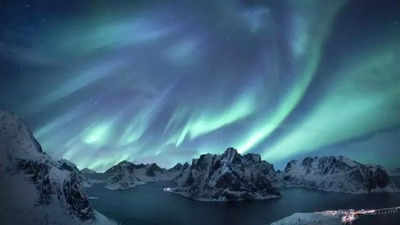
Stay connected and secure with international roaming plans
Save important emergency contact for swift response, use international debit/credit cards or consider a forex card for easy payments, convert currency before your trip, apps to download for your norway trip, local guide apps:.
- Visit Norway: Offers travel guides, maps, and information on attractions, accommodations, and activities.
- Norway Lights: Helps you track and view the Northern Lights, providing real-time forecasts and alerts.
- Oslo City Guide: Provides information on attractions, restaurants, and events in Oslo, the capital city.
Public Transport:
- RuterReise: Offers public transport information, including routes, schedules, and ticket options in Oslo and surrounding areas.
- Vy: Allows you to plan and book train and bus tickets across Norway.
Language and Communication:
- Google Translate: Useful for translating text, speech, and images to and from Norwegian.
- Duolingo: Helps you learn basic Norwegian phrases and vocabulary for better communication.
- Yr: Provides accurate weather forecasts for locations across Norway, including detailed information on temperature, precipitation, and wind.
Outdoor Activities:
- UT.no: Offers hiking and outdoor activity guides, including trail maps and route suggestions.
- Skiinfo: Provides snow reports, ski resort information, and live updates on ski conditions.


IMAGES
COMMENTS
March to May and September to November are the best times for quiet roads. With so much going on in summer and winter, Norway falls relatively quiet during the spring and fall months. And therein lies the appeal of visiting at this time. Beyond city limits, Norway's roads are quieter by a near-exponential magnitude.
October: Autumn colours by day and good chance of northern lights by night, as long as the weather is on your side. Expect rain. Very few international tourists. A good time to visit the cities. November: Winter arrives but there's usually very little snow outside the mountains.
The best time to visit Norway depends on what you want to do. If you want to experience the hiking trails, natural wonders, tourist attractions and warm weather, summer or early autumn is best. If you instead want to experience the amazing skiing opportunities, the northern lights or the cold snow, winter is the best time. ...
Daylight: 8 to 13 hours in Oslo, 10 to 14 hours in Tromso. March and April are some of the best months to visit Norway for travellers who want to make the most of both the winter and spring seasons. The winter snow slowly starts to melt by mid to late March and most bodies of water are filled with fresh water.
When to go to Norway is a common question among first-time Norway travelers. The best time to go to Norway suitable for most travelers is early summer, especially the months of June and July. The weather is pleasant and the days are long however it is also peak season. The other seasons offer plenty to do, though it can be cold and days are ...
High Season: June to August and December. Shoulder Seasons: September to October and April to May. Low Season: November and January to March. Choosing the best time of year to visit Norway depends ...
Norway in summer. Best for enjoying the midnight sun & warm waters. June to August is a fantastic time to visit Norway if you want to take advantage of the country's legendary midnight sun. At this time of year, the days are long and pleasant, and greenery stretches as far as the eye can see.
The best time to visit Norway in the northern region is in the fall, which brings thinner crowds, cooler weather between 41°F to 50°F, and glorious foliage. The best time to visit Norway in the southern region is between May and August, when the days are long, the landscapes are green, and the weather is warm, between 61°F and 72°F.
Nevertheless, most people travel during the summer season, which can be the best time to visit as bus, ferry and train connections are at their most frequent. This is the time of the midnight sun: the further north you go, the longer the day becomes, until at Nordkapp the sun is continually visible from mid-May to the end of July.
The average fall temperature is +12C, but it begins to get even colder as October approaches. There's no doubt that some of the most beautiful months in Oslo, Norway, are September and October, when the sky often glows in warm hues, the air is crisp, and leaves start to turn yellow.
As hundreds of thousands of people live in this huge geographical area, the region of Northern Norway has everything from cities with a lively night scene and great museums to small fishing villages and vast, tranquil spaces without light pollution. The best time to go is now. The northern lights activity is peaking this and next year.
High season: summer is ideal for fjord cruises and outdoor activities. The summer months are the ideal time to visit the Norwegian fjords. The temperature is pleasant, the mountainsides are green and lush, and there are lots of different activities and attractions to choose from. Remember that even in summer, it's a good idea to be prepared for ...
The best time to visit Norway completely depends on what you want to see. While the country is beautiful year round, your experience will differ greatly depending on the region, the activities, and the month. Norway is a long, large country and is diverse in weather and tourism hotspots. Summer in Norway brings with it long days, great weather ...
Welcome back sun! As winter snows melt away, Norway bursts to life with vibrant colours, the scent of cherry blossoms, surging waterfalls, and sun-hungry Norwegians enjoying the outdoors. Embark on picturesque hikes through lush forests, explore quaint villages, and see newborn lambs in the meadows. Norway's springtime beauty promises the ...
June to August is the peak season and summer time. This is usually considered one of the best times to visit Norway and is known for great weather, lots of events, and long days. Train, bus, ferry, and flight connections will be most frequent, and this is the best time for you to spot the famous midnight sun, which is more prominent the further ...
Summer in the Nordic countries. Summer, June, July and August are great times to visit the Nordic countries and the high season in the Nordics. You have long days; in summer, the Sun comes up around 4:00 and sets around 22:30 in most Scandinavia. In the Arctic region, the sun is above the horizon in the summer months, and you can experience the ...
May to mid-June is a wonderful time to visit Norway with good chance of mild or even warm weather and some of the longest days of the year. May is a great time to enjoy the country's waterfalls ...
The best time to visit Norway in the northern region is in the autumn, which brings thinner crowds, cooler weather between 5°C to 10°C, and glorious foliage. The best time to visit Norway in the southern region is between May and August, when the days are long, the landscapes are green, and the weather is warm, between 16°C and 22°C.
Best Time to Visit Norway. Every season in Norway can be a good one to visit, even winter! Each season is just very different. But I think the best time to visit Norway is summer.
April. As the weather warms and nature begins to bloom, spring arrives in Norway, making it an ideal time to explore the country. The weather in the north is still cold, but it warms up later in the month. While the rest of the country enjoys longer daylight hours and temperatures ranging from 4 to 9 degrees Celsius.
The best time to see the Northern Lights in Norway is from December to March, and you can take part in guided tours to ensure you have the best chance of seeing them. As you admire the dancing lights in the sky, you'll feel like you're in a magical winter wonderland. Now, let's move on to the next season: April - May, springtime in Norway.
The best time visit Norway is summer (June-August). It promises long, light days and warmer temperatures - but no guarantee of heat, even if it won't be cold. However, the best time to go to Norway also depends on what you want to do. May and September offer gorgeous colours in nature, while November-March is for snow and Northern Lights ...
The winter is a fantastic time to explore the fjords if you'd like to see them at their most quiet and serene, with much fewer people around - and as an added bonus, the beautiful snow-capped mountains around the fjords will look spectacular. No matter what season you choose to visit Norway, we recommend experiencing the Norway in a ...
Located about 220 miles above the Arctic Circle, Tromsø is one of several top spots to view the northern lights in Norway. At the darkest point of the aurora season - which runs from September ...
Visit Norway: Offers travel guides, maps, and information on attractions, accommodations, and activities. Norway Lights: Helps you track and view the Northern Lights, providing real-time forecasts ...